Christopher Priest (1943-2024)
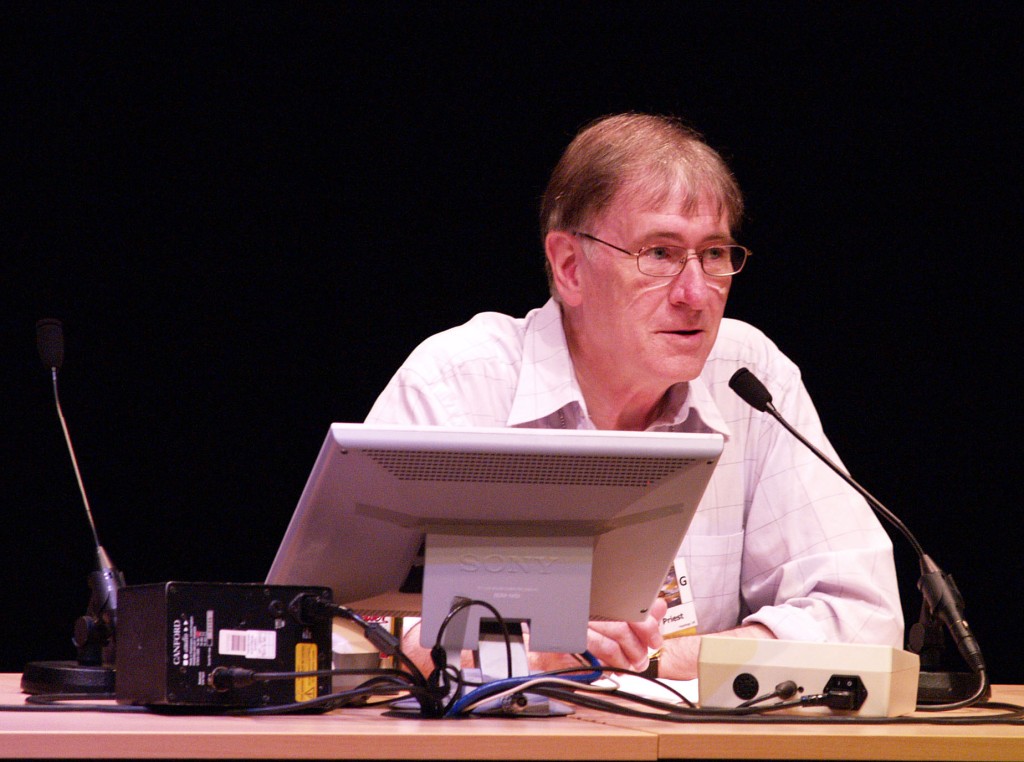
Christopher Priest passed away on 1st February, 2024 at the age of 80.*
He had a long career as a successful novelist, starting with Indoctrinaire in 1970. His most recent novel was Airside, published last year. He was working on a biography of J.G. Ballard which his partner, Nina Allen, intends to complete.
Other notable novels included The Affirmation, A Dream of Wessex, The Glamour, Inverted World and The Separation. His 1995 novel The Prestige was turned into a remarkable film of the same name by Christopher Nolan in 2006. He also wrote many short stories and produced a number of fanzines and fanzine articles; in one of these, he memorably tangled with author Harlan Ellison over the non-appearance of Ellison’s anticipated anthology The Last Dangerous Visions, for which Chris had written a story.
His novels and stories usually had an intelligent approach to their subject; he generally steered clear of the traditional science-fictional tropes of spaceships and robots. Nonetheless, he could rise to the occasion when his imagination could envision strange worlds. From about the midpoint of his career, many of his stories were set in a imaginary group of islands, the Dream Archipelago, which may (or may not) have been on a different world. The stories had a flavour of both the Greek and Caribbean islands, but were definitely in a unique socio-political setting. Sometimes, these stories were contrasted with our own world, or a near-future Balkanised UK. He won multiple awards both in the UK and overseas.
I first met Chris Priest in about 1977 when I was running the then Newcastle Polytechnic SF Society and we invited him to come to Newcastle to give a talk. I went to the station to meet him off the train, in the company of another fan who had met Priest before. But it was me who spotted him first, recognising him from a cartoon that had appeared in a fanzine a few weeks earlier.
Bearing that in mind, I was surprised, when he was Guest of Honour at Novacon in 2021, that I didn’t recognise him at first.
I still have a lot of his books on the TBR pile; time to move them up the stack.
*Not to be confused with the comics author of the same name.
What I did on my holidays, 11 – the voyage home
A short post to finish off the account of the Austrian trip.
We had the benefit of a 9:15 departure from Ulm on a stopping train to Stuttgart. As our hotel didn’t do breakfasts, and time was of the essence, I was planning on either grabbing something at the station, or (Plan B) waiting until we got on board the Paris train at Stuttgart. As you might imagine, Stuff Happened and we were onto Plan B. I’d always thought that Germans started work early, but the train to Stuttgart was busy; but well-organised enough not to be burdensome.
Stuttgart Hauptbahnhof was heaving, but we came upon our Paris train only a few platforms away from our arrival road, before we could get to the concourse and the departure board for all the services. So that worked well enough, and our reserved seats were easily found. We pulled out of Stuttgart in good time, and I went to the buffet car to get breakfast.
Which was as well. We’d been seeing news reports for a few days about the disruption to air traffic across Europe following the failure of the UK’s air traffic control system. (Which turned out to be due to a one-in-a-million combination of bad data and a system not configured to handle it elegantly. An instance of “we stop testing when the project manager tells us to so the application can be deployed, knowing that there will be undetected bugs that will hopefully never show up because they will depend on very rare combinations of circumstances”). We rolled into Karlsruhe to a huge crowd on the platform who proceeded to pack themselves onto our train, standing all the way down the aisles as well as occupying the coach vestibules.
The train manager went spare. Within five minutes, he’d made an announcement (in German) to the effect that the train was dangerously overcrowded, that people who did not have a reserved seat on that service should get off and present themselves at the travel centre, where they would be booked onto the next available train; and that our train would not be departing until this happened.
No-one moved.
After about twenty minutes, he repeated the announcement in German and French. Still no-one moved. After another twenty minutes, he repeated his announcement, this time in German, French and English. Strangely enough, the crowd began to thin out, and inside five minutes we were on our way again. Whether his language skills had had an impact, or the arrival of two armed Politzei on the platform had concentrated minds I cannot say.
By this time, we were some forty-five minutes late, but at least the sun had finally come out (as it usually does on a wet holiday when you’re finally heading home). I wasn’t worried because we had a generous cushion of time between arrival at Paris Gare de l’Est and departure from Paris Gare du Nord, two stations very close together. I was particularly taken by our journey between Strasbourg and Paris. When I last made this journey by rail in 1997, Strasbourg to Paris took more than four hours; our high-speed service covered the distance in about an hour and twenty minutes, and we recovered about ten minutes of the time we had lost.
In Paris, we felt the need to take a taxi between stations, much to the incredulity of the taxi driver who had not noticed that one of us was walking with a stick. The queues for the Eurostar was remarkable, given that it was a Wednesday afternoon, though again there was probably increased demand because of the non-availability of flights; the walking stick came in handy again, as that promoted us to the head of the various queues, and without effort we were soon through check-in, French customs and UK border control and sitting in the Eurostar lounge watching people rushing to get their trains.
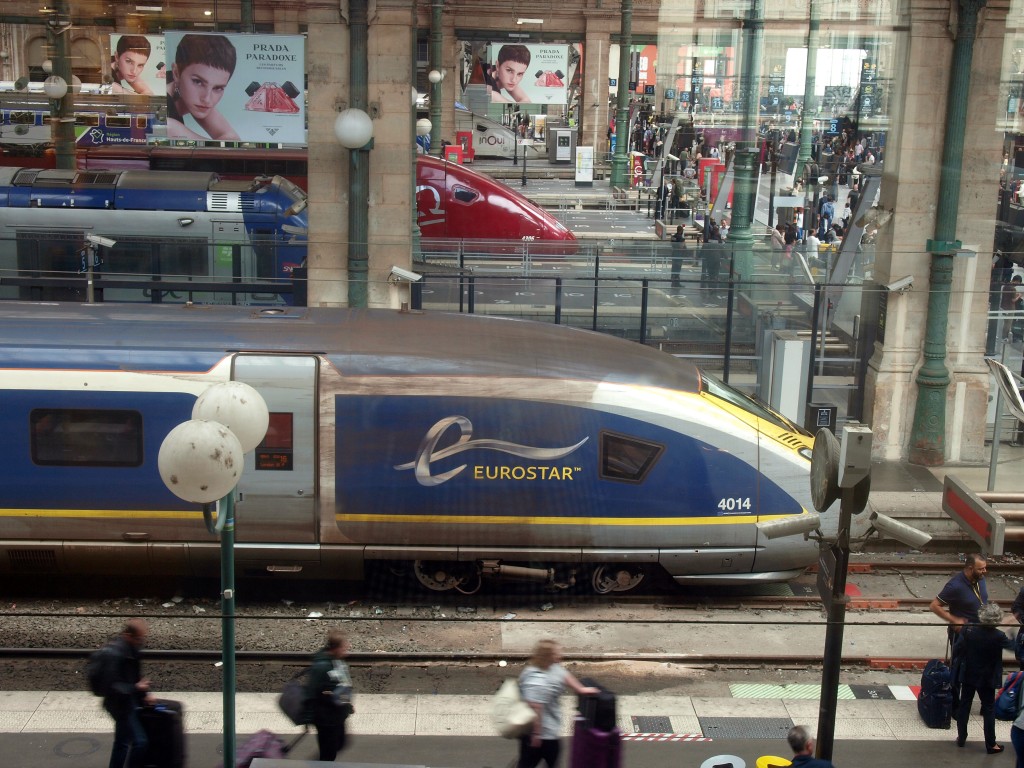
In due course it was our turn; we travelled back through the Channel tunnel and arrived at St. Pancras International; and then transferred to an East Midlands Railway Voyager for the trip back to Leicester. On the way, my friend asked “What’s powering this train?”. “Diesel” I replied.
“Ah, diesel,” she said. “How quaint.”
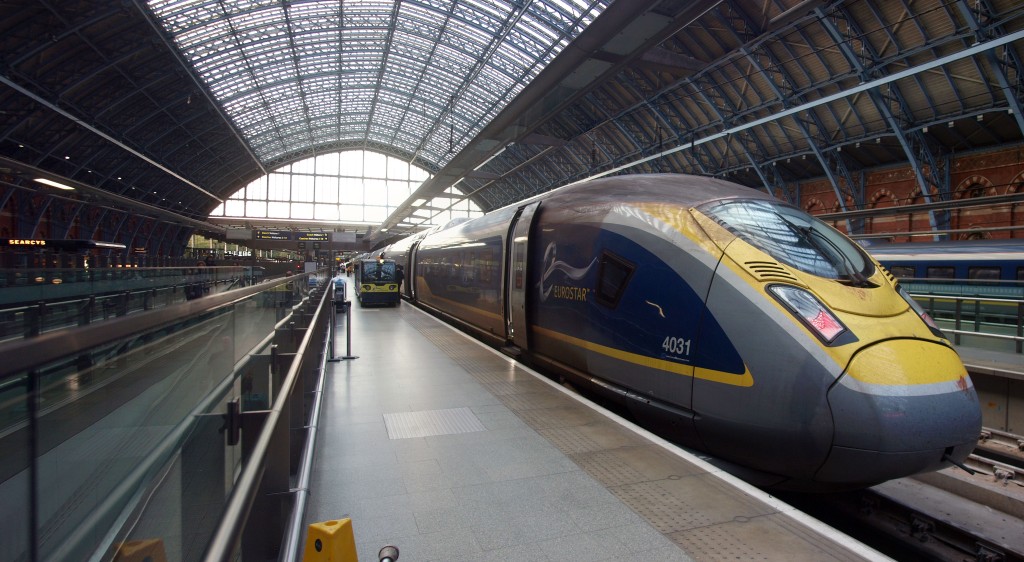
Previously: Days 10 & 11, Ulm
What I did on my holidays, 10 – Turning for home (with a stopover)
It’s a pretty savage amusement to travel by train from Salzburg back to the UK in one day. I did it back in 1996, and with a 5am start from my hotel and the first train for Munich out of the city, I landed back in the Midlands around 10:40pm – so nearly eighteen hours’ travelling, although this was in the time before high-speed rail. But in planning this trip, one objective was to take advantage of travelling by train to include a stopover. That had (eventually) worked well in Zürich on the way out, so I wanted to repeat the process on the way back. After some head-scratching with maps and timetables and the like, I eventually settled on Ulm in southern Germany as a likely stop-over. I had only ever passed through Ulm before, so I had no real idea what would be there, although some research suggested that there would be things of interest.
The journey to Ulm was reasonably straightforward, although the seat reservations computer decided to fill the train from one end in strict order – so on boarding the train, we walked the length of our coach past empty compartments to find ourselves taking the last two seats in a full compartment. This seemed a little perverse to us, but we did eventually strike up a conversation with some of our fellow travellers; in particular, one lady who knew Ulm and assured us that we would enjoy it.
Which was more than we could say for Deutsche Bahn, at least on this leg of the journey. Their staff varied from the helpful to the officious; and their idea of a first class compartment was to take an existing compartment coach, tear out the existing seats, and insert six bucket seats as used in the first class coaches of their high-speed Inter-City Express (ICE) trains. This resulted in seat spacings that didn’t match the sort of standards you’d expect from first class; I rather suspect that this was a cheap and cheerful way of upgrading rolling stock from Second to First.
Anyway, we arrived at Ulm and our initial impressions were not helped by the weather, which remained wet and cloudy throughout the day of our arrival and the next. But it is a town with much to recommend it, though you have to look. Our hotel was only about five minutes from the station and was on the edge of the old town. The city was heavily bombed in December 1944 and much of the old town centre was destroyed. It was rebuilt on much of the old street plan and many buildings were reconstructed based on their appearance before the war, but using the materials of the 1950s and 1960s. Some individual buildings survived; others have been restored to their original condition since then.
We took an evening walk around the immediate surroundings of the hotel. The streets were cobbled and dedicated to pedestrians (in that they had priority over cars, which were not banned as such). We could see the pattern of the old buildings, with roof-lines or floor plans that betrayed the original buildings; occasionally, we would turn a corner to reveal a building restored to its full half-timbered glory. But as the rain showed no sign of letting up, we retreated to our hotel – an odd place where the rooms were in a separate building in a courtyard that included an entrance to an underground car park. This courtyard was accessible from the street without any need to enter the hotel via the front door. It was actually quite modern, with a spacious room and (for once) good internet connectivity. It’s strange how something so new has become an essential for even the most casual traveller.
The next morning, the weather was little better. We retraced our steps of the previous evening and found ourselves in the main town square, facing Ulm Minster. Despite appearances, this is not a cathedral; nonetheless, it is remarkable for its size and its spire, which at around 520 feet is the tallest church spire in the world.
So the Fishermen’s Quarter, which we spent some time in, is a maze of cobbled streets and pathways, which sometimes
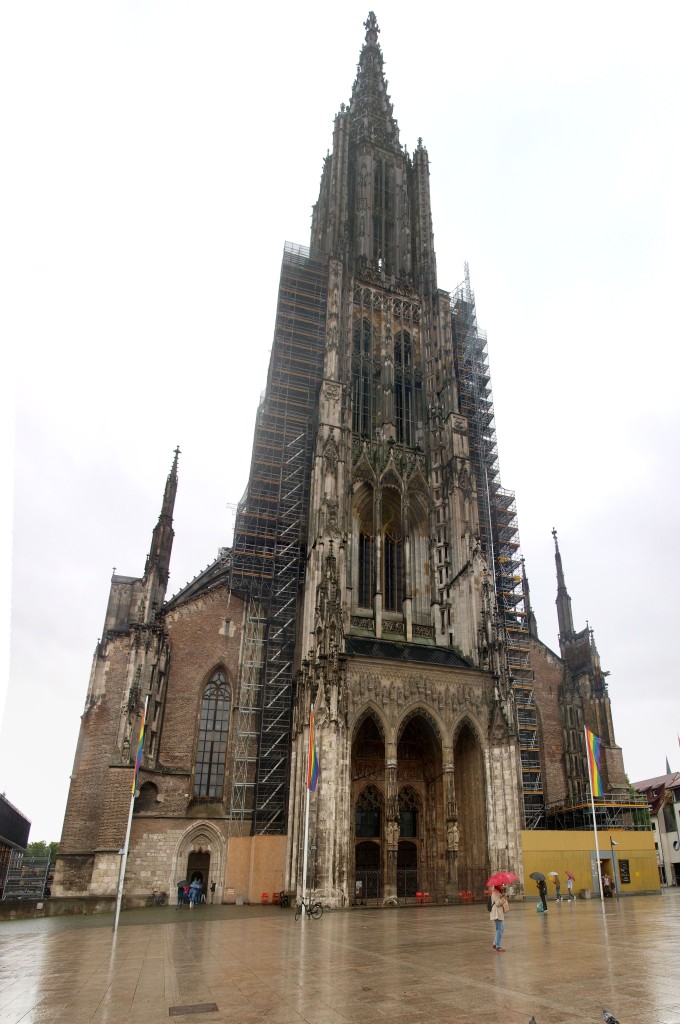
The inside is as spectacular as the outside. There were notices setting out the usual prohibitions for visitors that you would find in ecclesiastical buildings anywhere, including one on photography. But it seemed that lots of people were taking photographs with their mobiles; and the pictogram on the sign showed a digital SLR camera, so we thought phones would be OK – not that I’ve ever used mine for photography much. I was reasonably pleased with the results, though some of my close-ups suffered from camera shake as I was unused to the camera controls and how to hold the phone.
Later we did see someone using a DSLR; only then did I look again at the pictograms on the prohibitions sign to see that the sign showed a camera on a tripod. That’s a very specific ban!
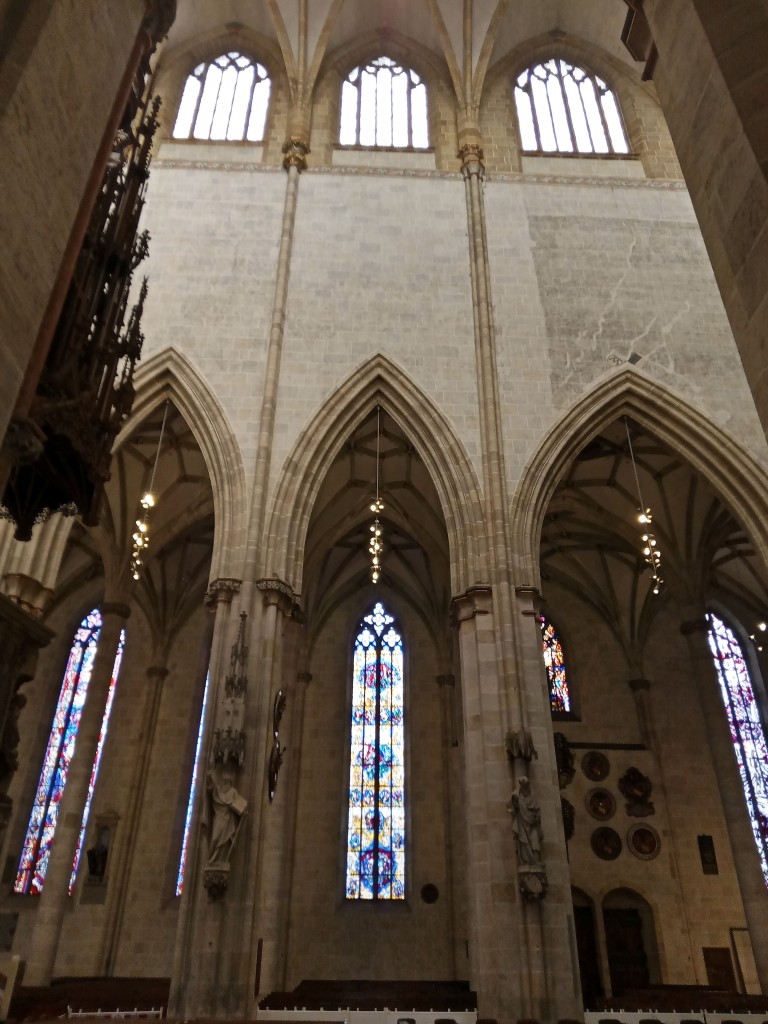
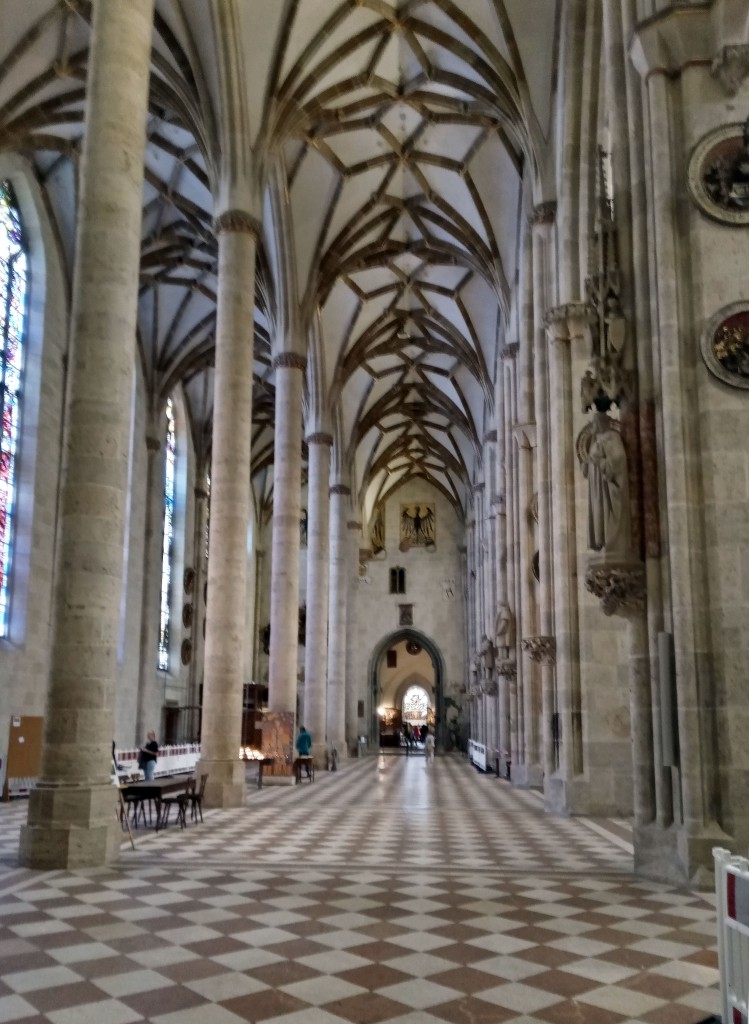
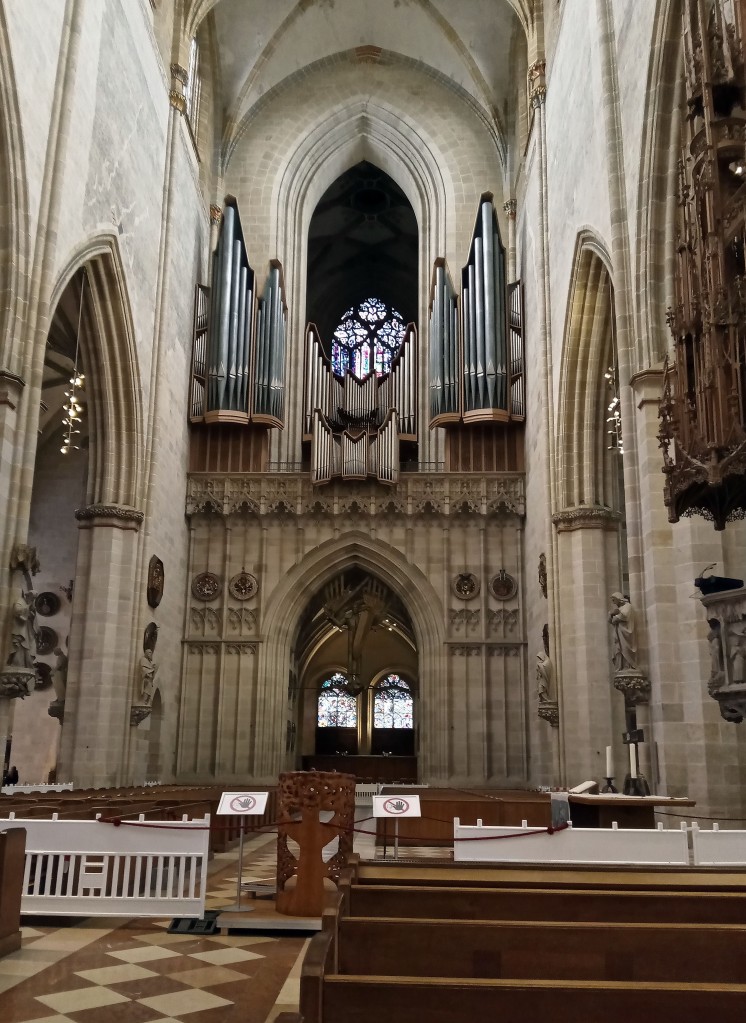
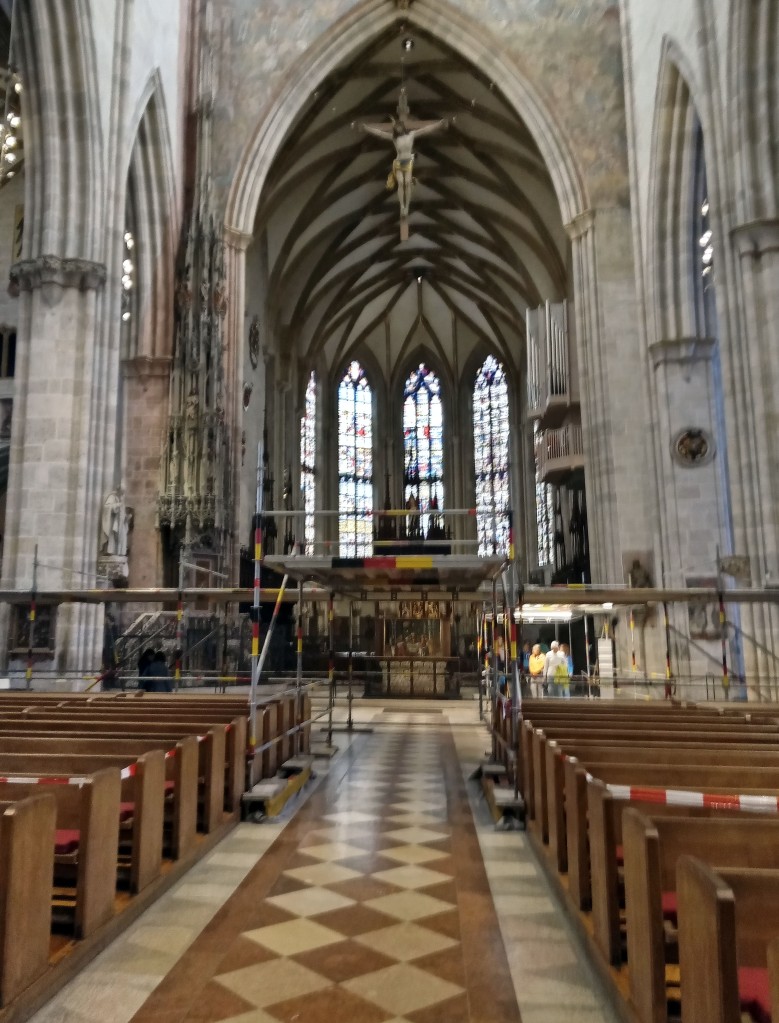
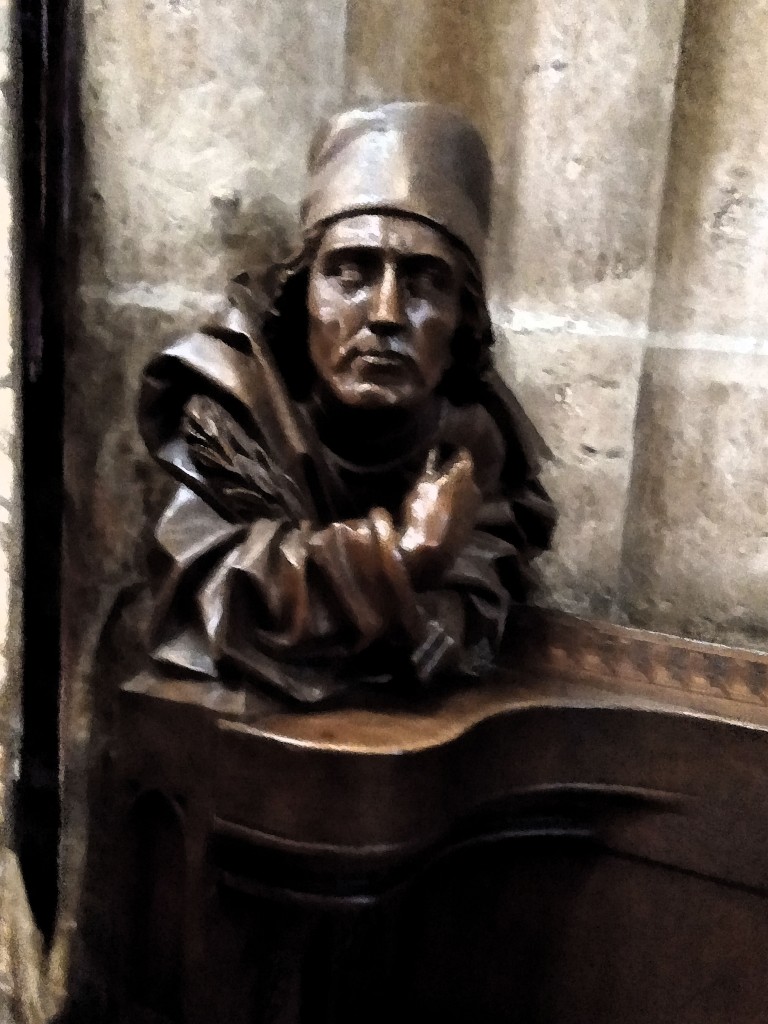
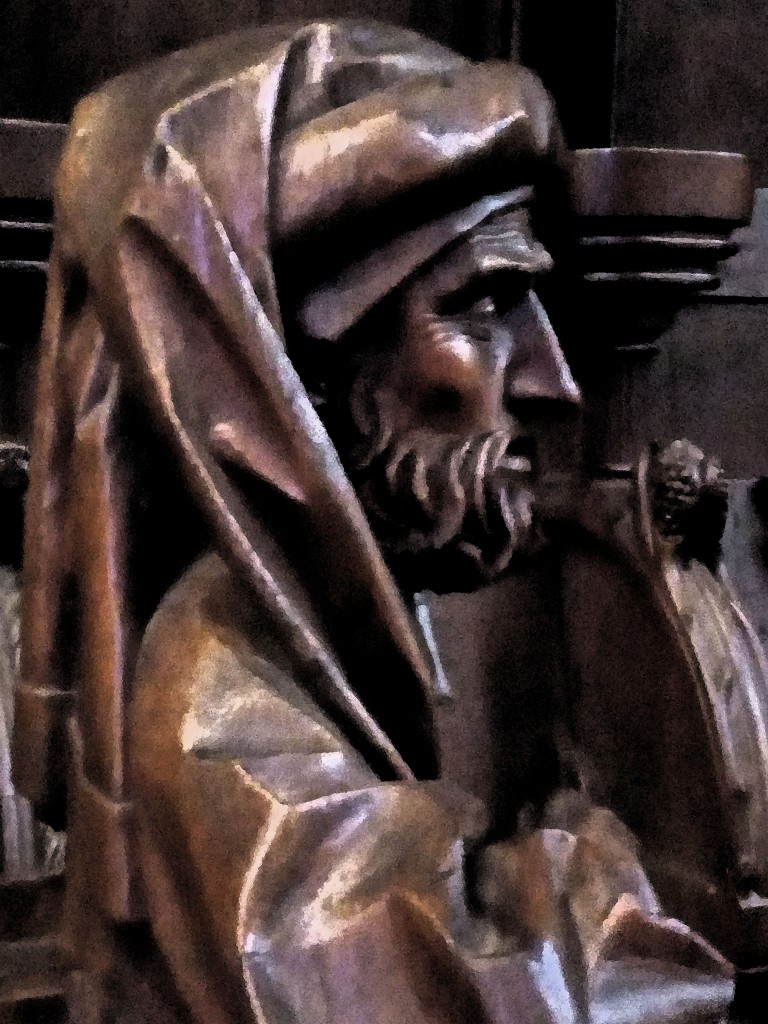


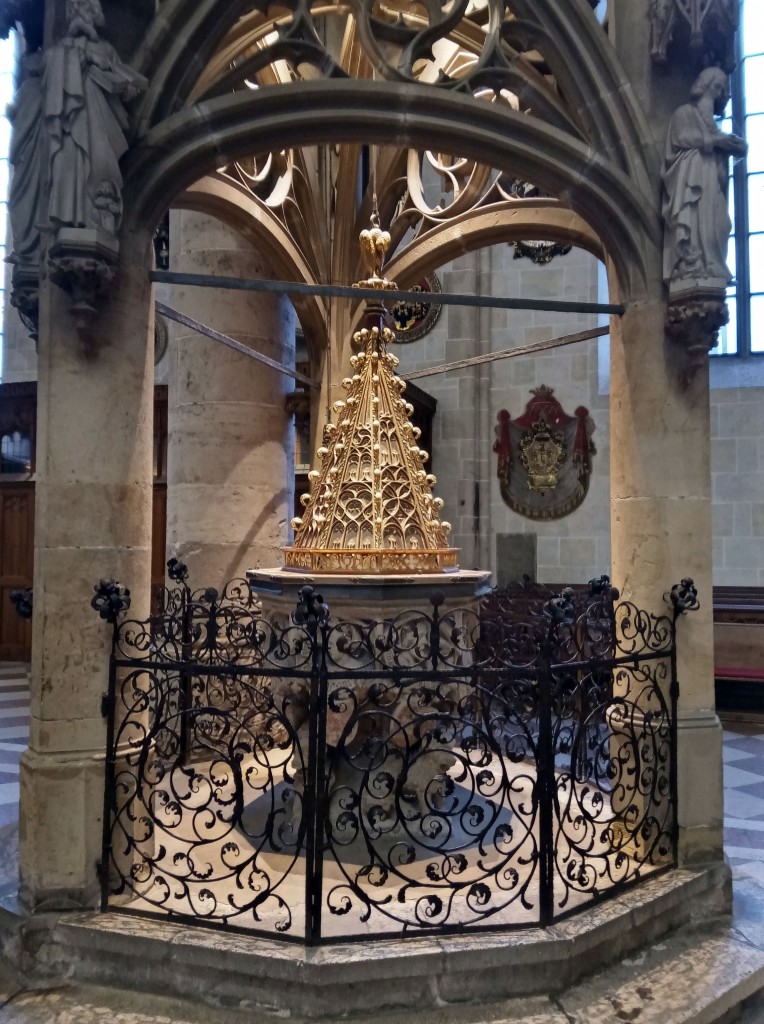
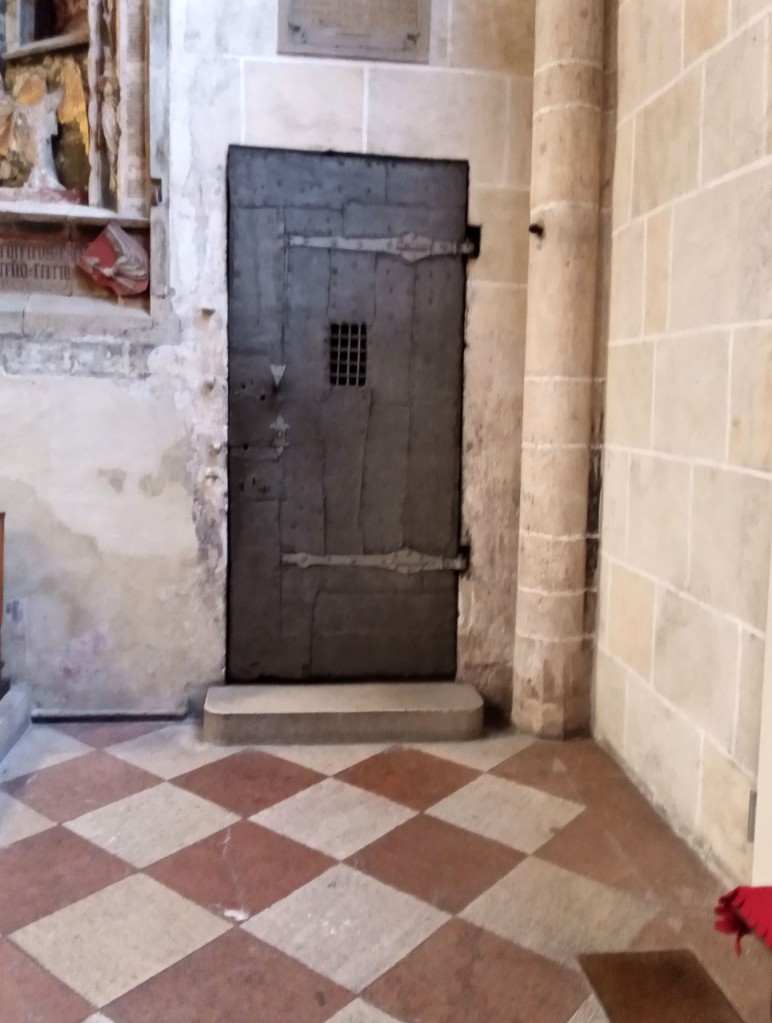
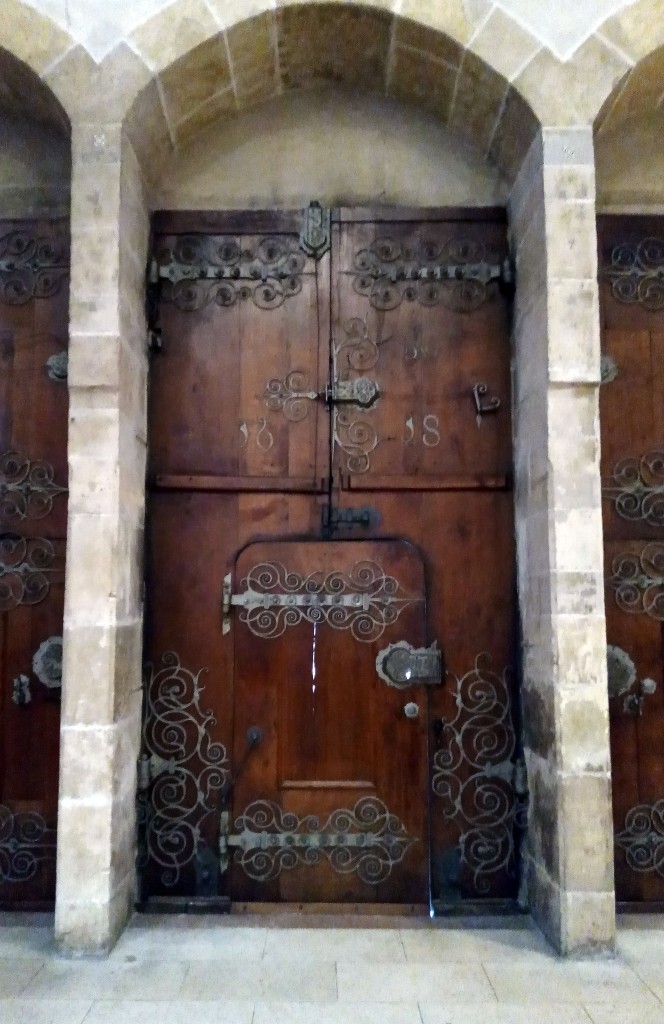
One of the minster’s stand-out features are the choir stalls, carved by Jörg Syrlin the Elder (15th century). These pictures suffered the most from my camera shake problems, so I enlisted the wonders of Photoshop to render them using one of the artistic filters to make the blur seem deliberate. It at least makes them viewable, in my humble opinion.
From the Minster, we went down towards the River Danube, through the Fishermen’s Quarter.
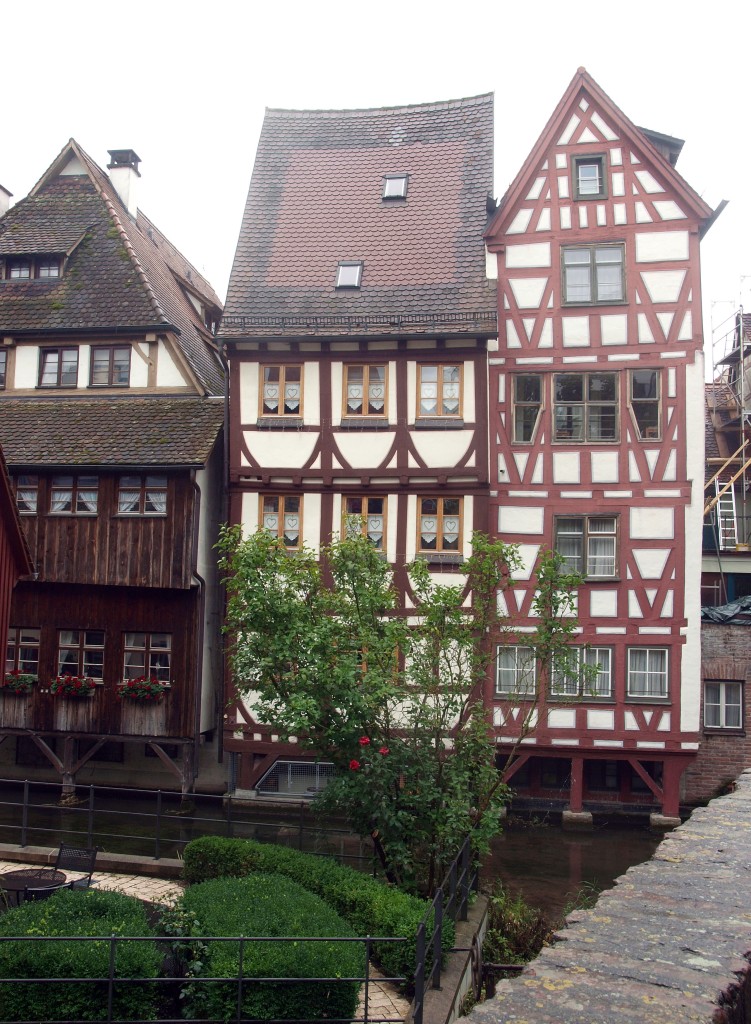

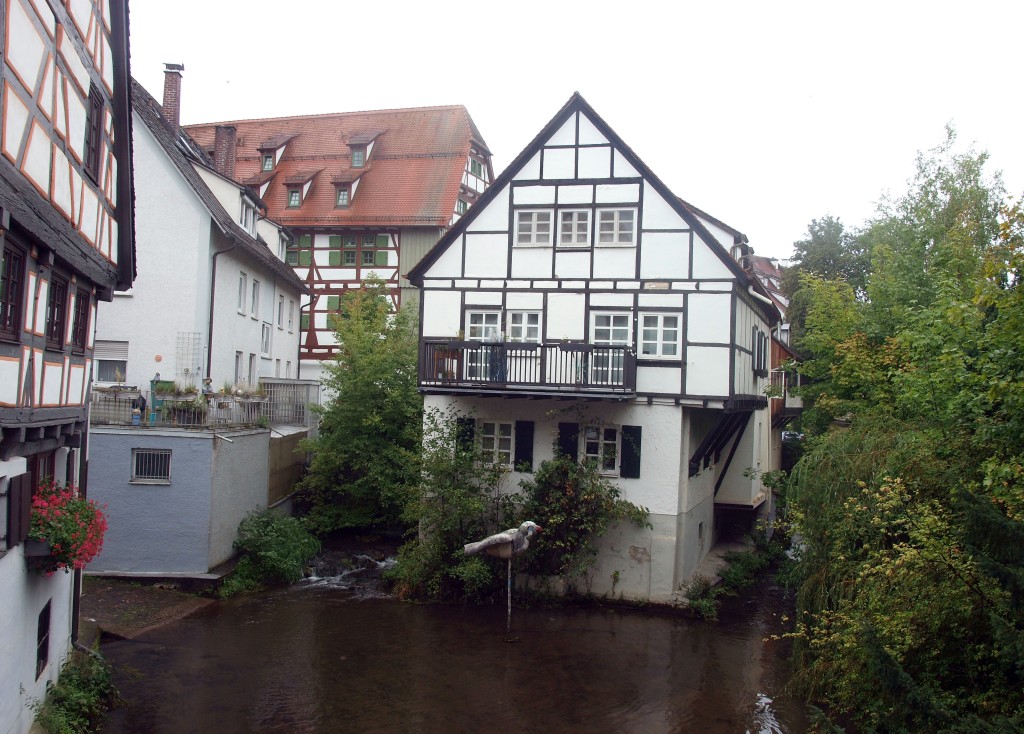
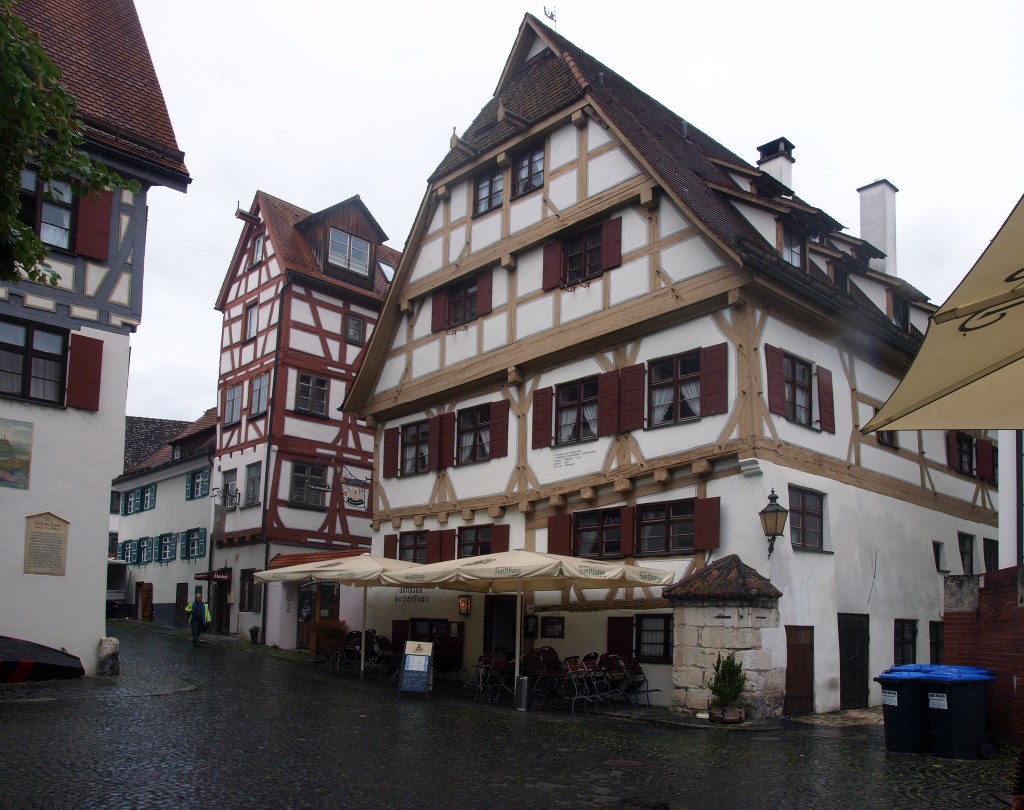
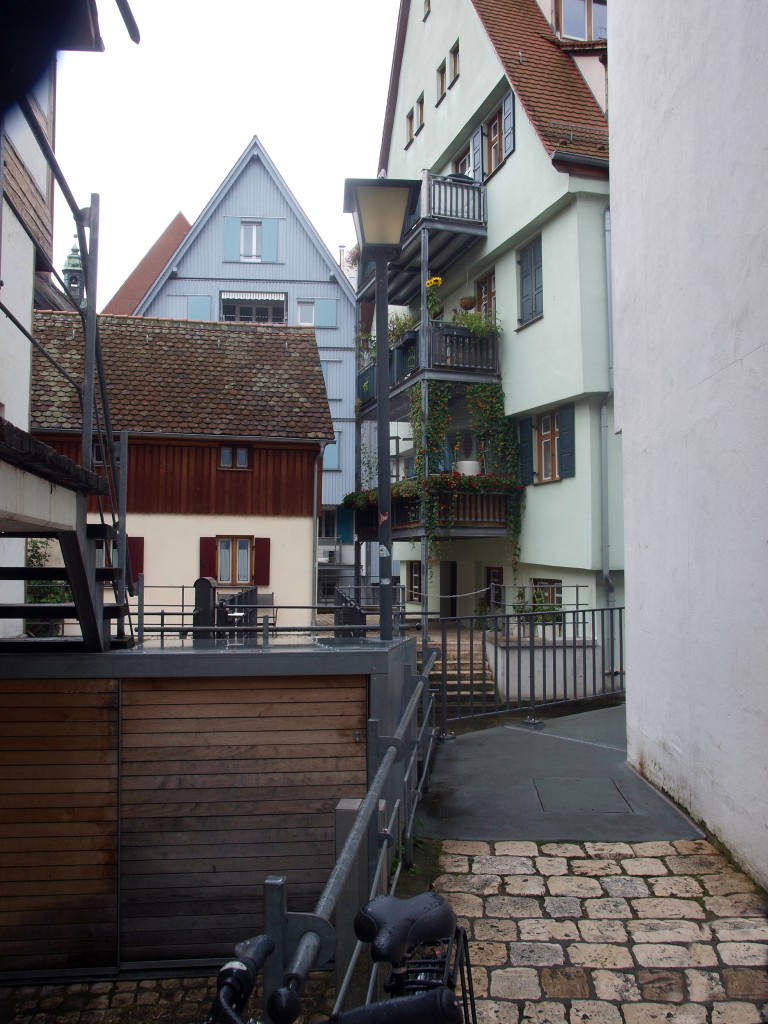
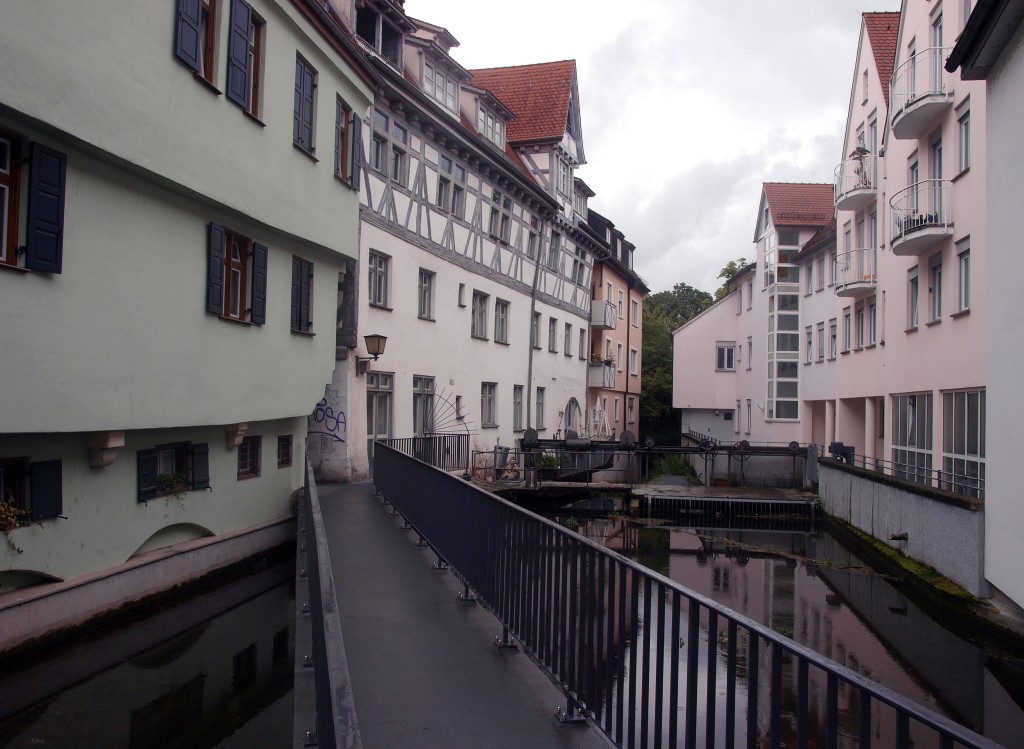

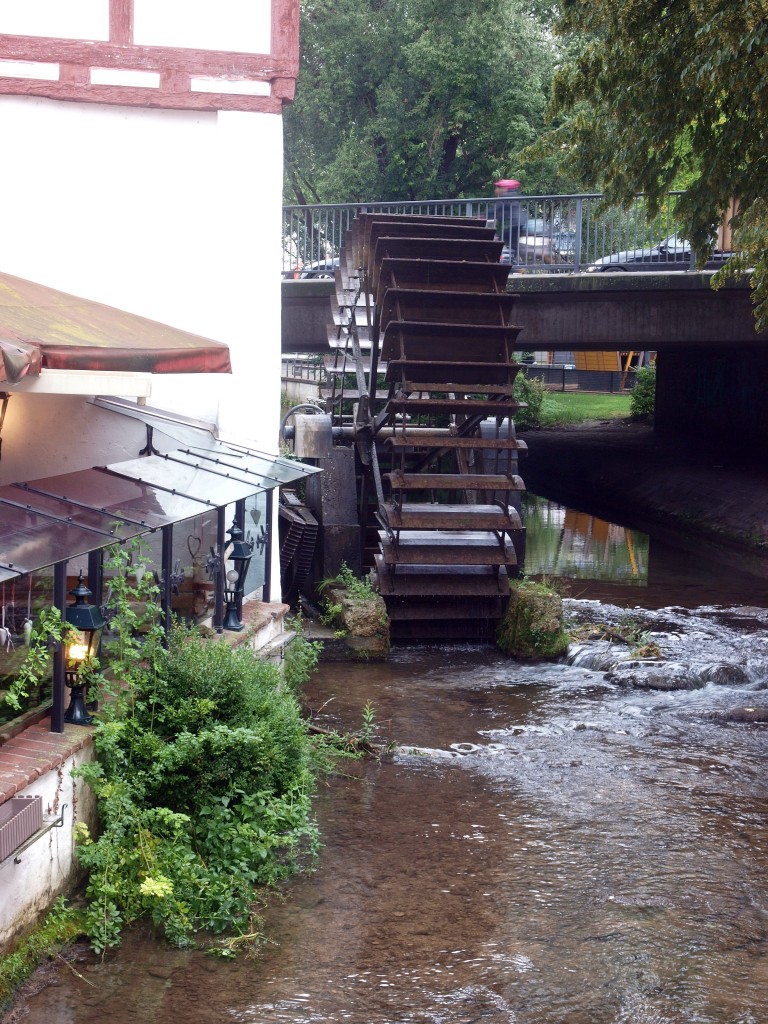
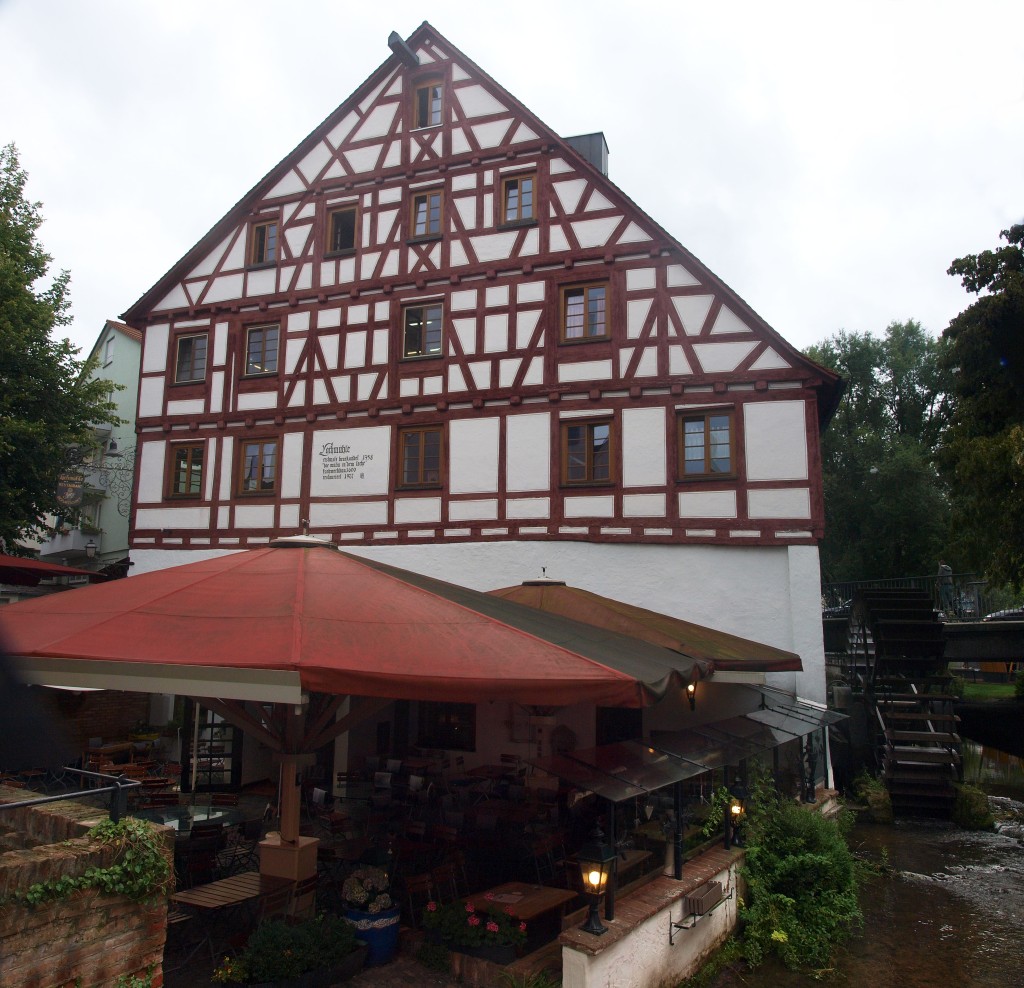
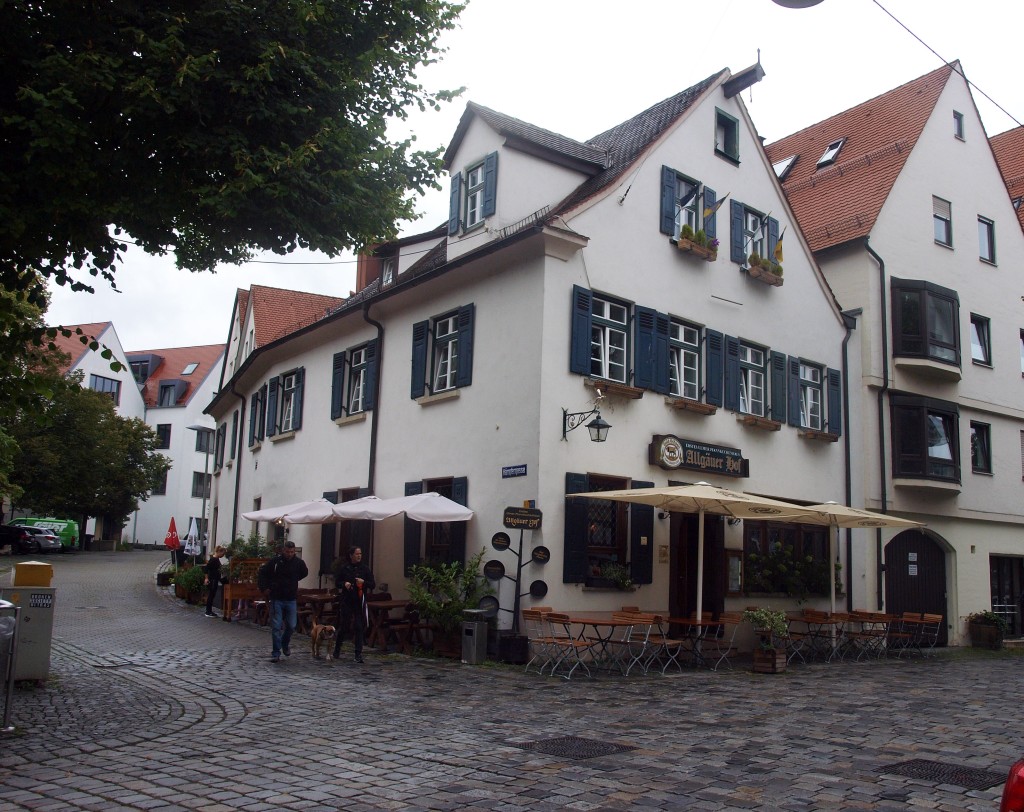
The last picture above shows the Allgäuer Hof, a pleasant hostelry where we stopped for lunch. There were no shortage of places to eat in the Fishermen’s Quarter, but there were very few people about and most of the places we looked at seemed quite large and empty. But this one felt more welcoming, and so it proved. It apparently has a reputation for crepes, but the rest of the menu was equally good. Lunch was simple but substantial; but perhaps the biggest surprise for me were the toilet facilities. I opened the door and was dazzled by bright lights and a Gents that shouted Cleanliness and Order. Good German virtues are alive and well in Ulm!
On leaving the Allgäuer Hof, we soon found ourselves in the Schweinmarkt, which has a quirky statue marking its history.

The statue, by sculptors Wolfgang und Christoph Oester, was unveiled in May 2001.
We then headed for the river, to find a Danube that was anything but Blue.
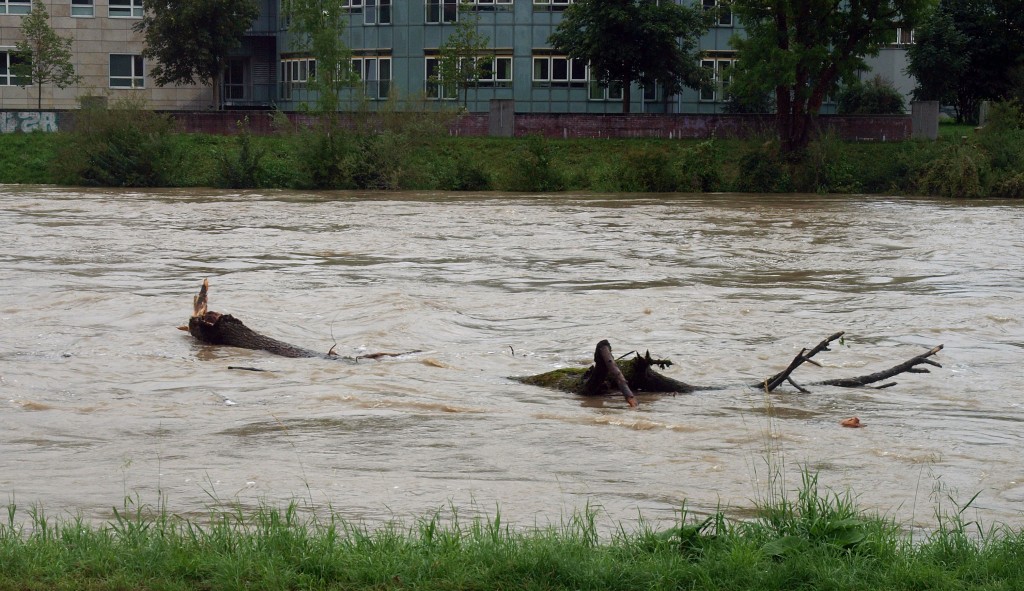
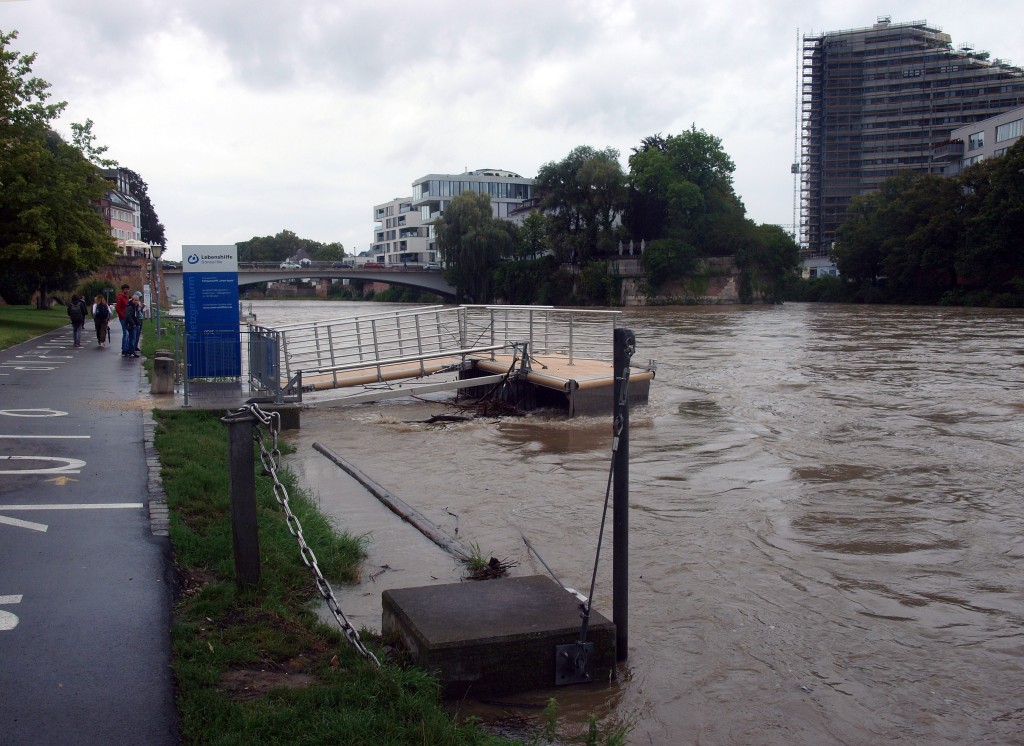
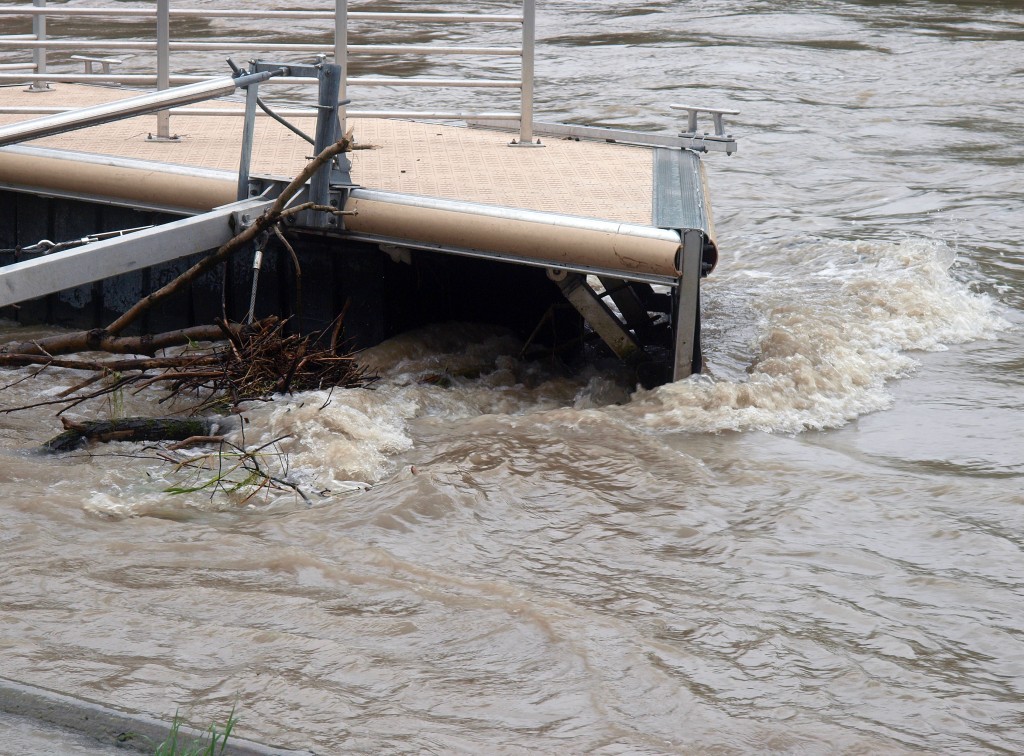
The heavy rain of the past few days that had fallen on the Bavarian uplands was now pushing its way downstream; some areas where we had already been were suffering flooding. Tree limbs were being washed downstream – the one in the photograph above was far from the smallest. But it didn’t bother the bird life – we sat for a few minutes and saw many sparrows – often a rarity in the urban UK these days – and a heron.
Finally, we walked a way along the river bank to the Metzgerturm (Butchers’ Tower), which has a tilt of some two metres at its top; and then crossed back into the town through the old town walls and headed back to the hotel to dry off.
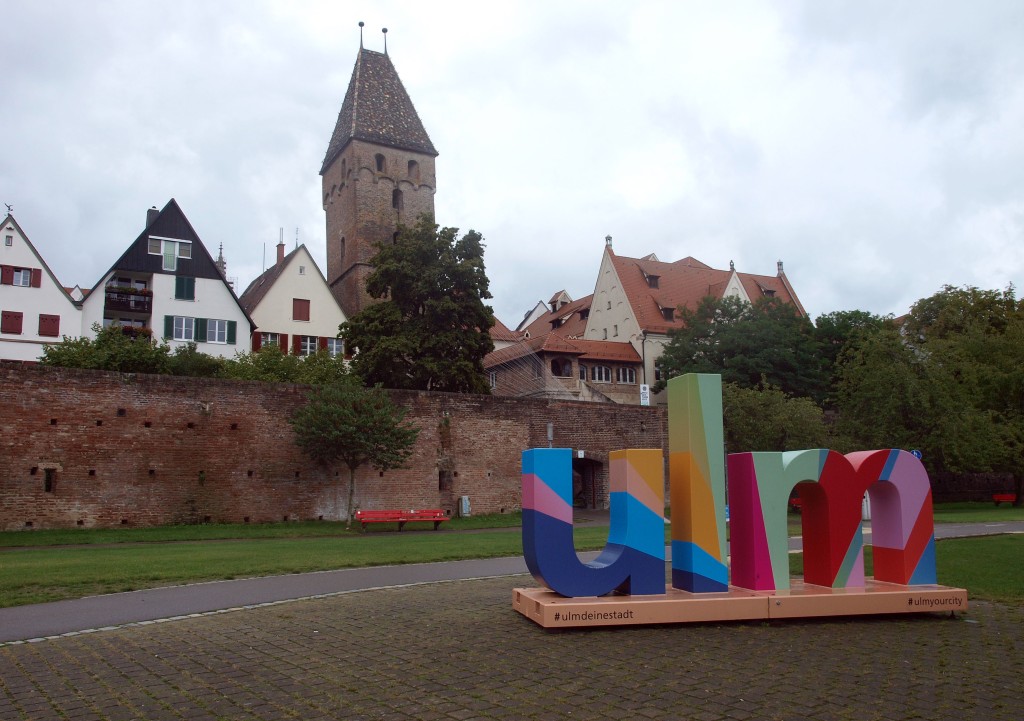
All in all, Ulm was a pleasant surprise (apart from the weather), and I’m sure there was plenty more to see.
Previously: Day 9, Wet Salzburg
Next: Day 12, the voyage home
More photographs can be seen on my Flickr page.
What I did on my holidays, 9 – wet Salzburg
And today, the weather had changed. Just like that. It was far cooler, and wet; a constant drizzle, with low cloud that looked much more like October than August. We felt quite at home, although my summery straw fedora wasn’t appropriate holiday wear any more.
I went and did some railway photography at Mülln-Altstadt, a new S-Bahn (suburban railway) station on the other side of the river which was being built last time I was in Salzburg in 2007. Although it was a Sunday morning, there was plenty of passenger traffic, both local and long-distance, and even a freight train. The surroundings were less than ideal: the view from the platform end seemed to give me a very un-Salzburg-like background of brutalist architecture; but I suppose it’s a useful reminder that the places we go on holiday have their own populations and that not all of them work in hospitality. People who live in touristy spots need insurance and washing machines as much as you or I do.
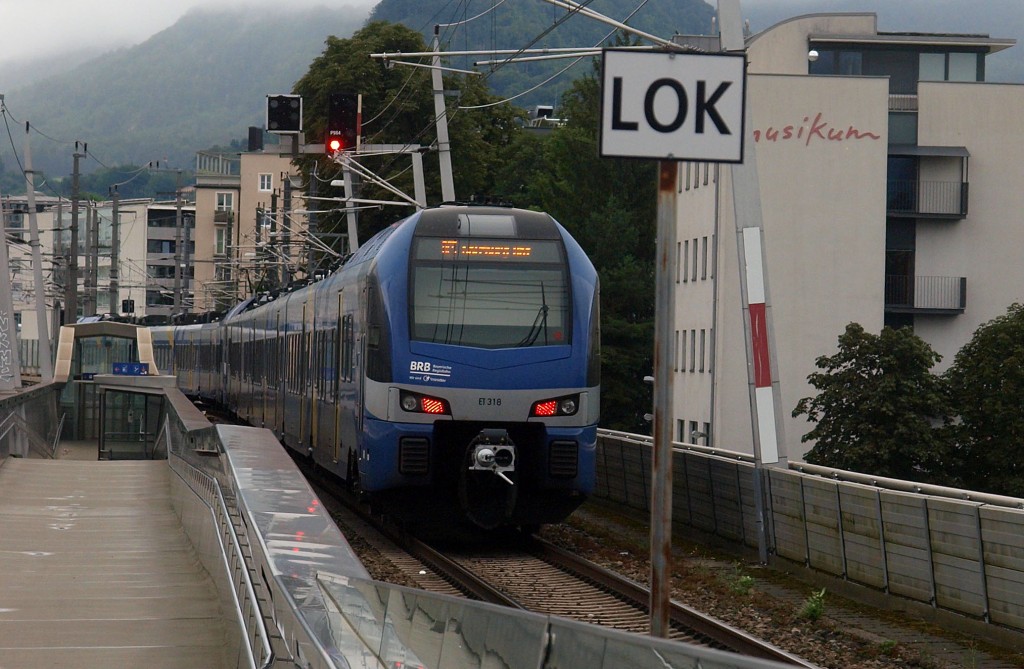

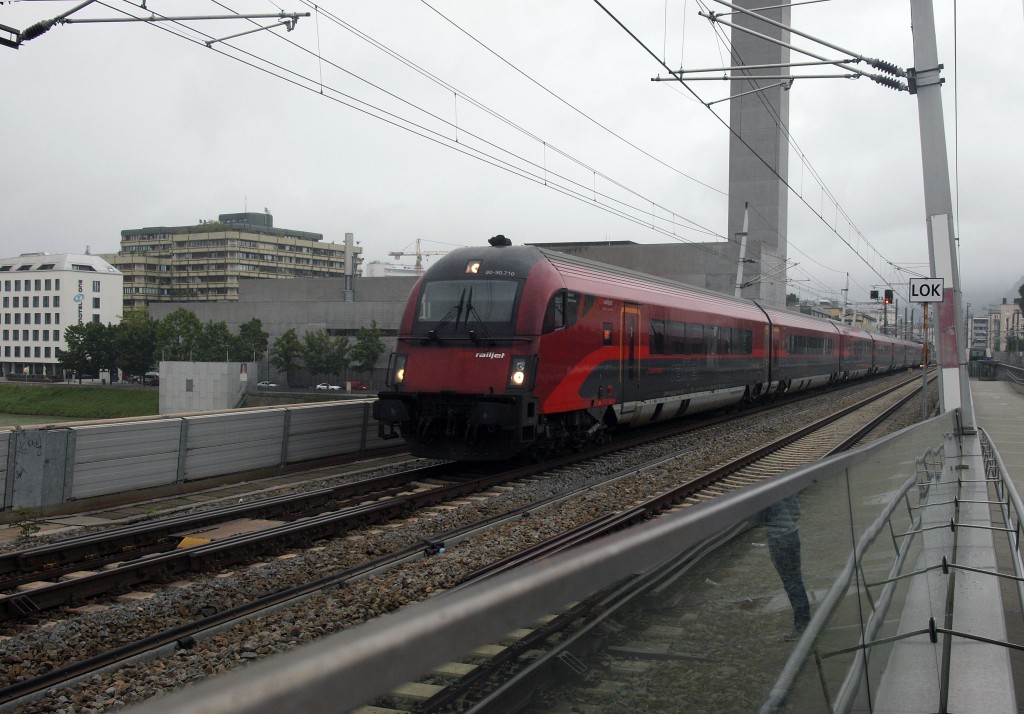
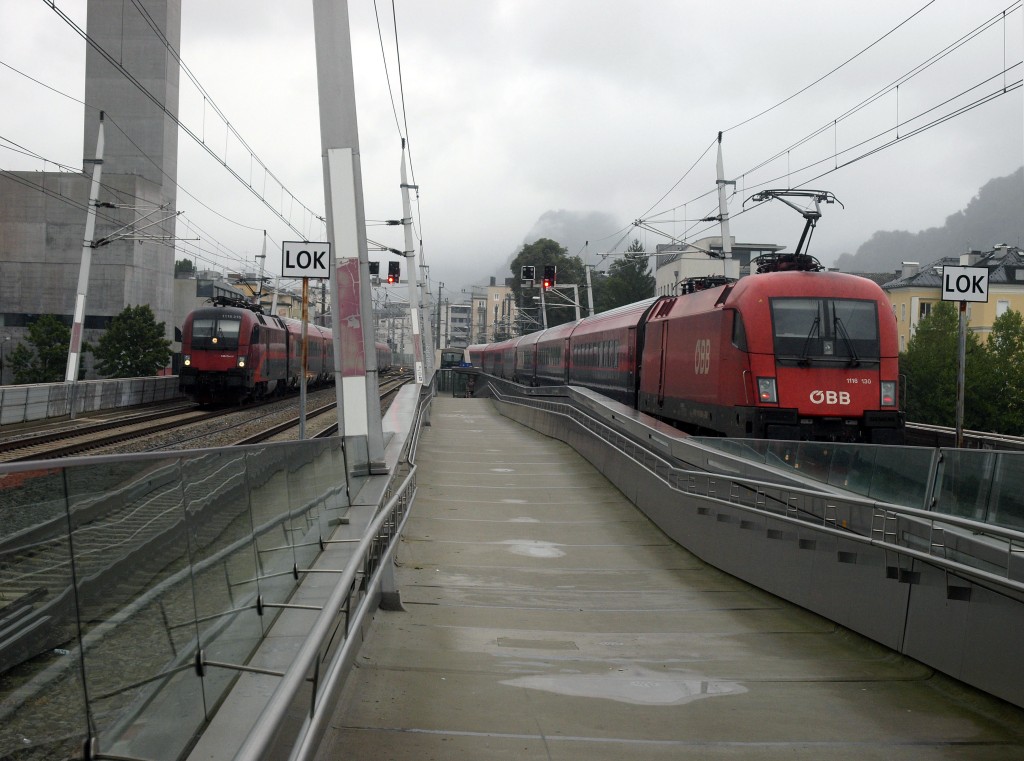

In about an hour, I saw trains from Austria and Germany, belonging both to their respective countries’ State railways and “private” operators. I say “private”, but that doesn’t mean quite what it means in the UK. For instance, after German re-unification, a lot of local railways were “privatised”, but the shares were taken up roughly 30% by the regional government, 30% by the State railway, and 30% by the redevelopment banks, which themselves are part State-owned. Or look at the picture above of the Westbahn train. Westbahn run non-State railway services on the route from Vienna via Salzburg to Munich. They were set up as an open-access competitor to the Austrian state railway (ÖBB) to take advantage of EU anti-competitive practice rules. Yet the French state railway operator SNCF holds 17% of the shares. It seems that the Lilley Doctrine (named for the Thatcher-era Minister Peter Lilley, who once asked “Why did we privatise our railways only to let foreign governments buy them up?”) is ignored as much on the Continent as we’ve allowed it to be in the UK.
Trains from the Bavarian Bayerische Regiobahn run into Salzburg, and many local services are run jointly by both State operations. And just to add colour, ÖBB has sold advertising space on some of its engines to various organisations. Just as I was coming away, I was able to capture a view of a Taurus locomotive advertising the association for Austrian organic farmers, Bio Austria.
Anyway, a little later we wandered along the riverbank – still well-patronised despite the rain – and passed the house long occupied by the conductor Herbert von Karajan. A statue in his memory stands in front of it:

We then headed for the Mozart family home, which now houses a museum devoted to the Mozart family; specifically, to Mozart’s father Leopold (who made his fortune by writing a best-selling violin tutorial) and his sister Maria (known to the family as Nannerl). The museum has various letters and other family documents, original scores and some instruments owned by Mozart himself. It’s not a big museum, but it is quite an interesting one.
But before then, we went to warm up in the café attached to the Mozarthaus. This is a proper Austrian café, offering Gulaschsuppe, Sachertorte and steaming cups of großer brauner coffee; all good, solid Austrian fare appropriate to a cold, wet day – even if it was still August!
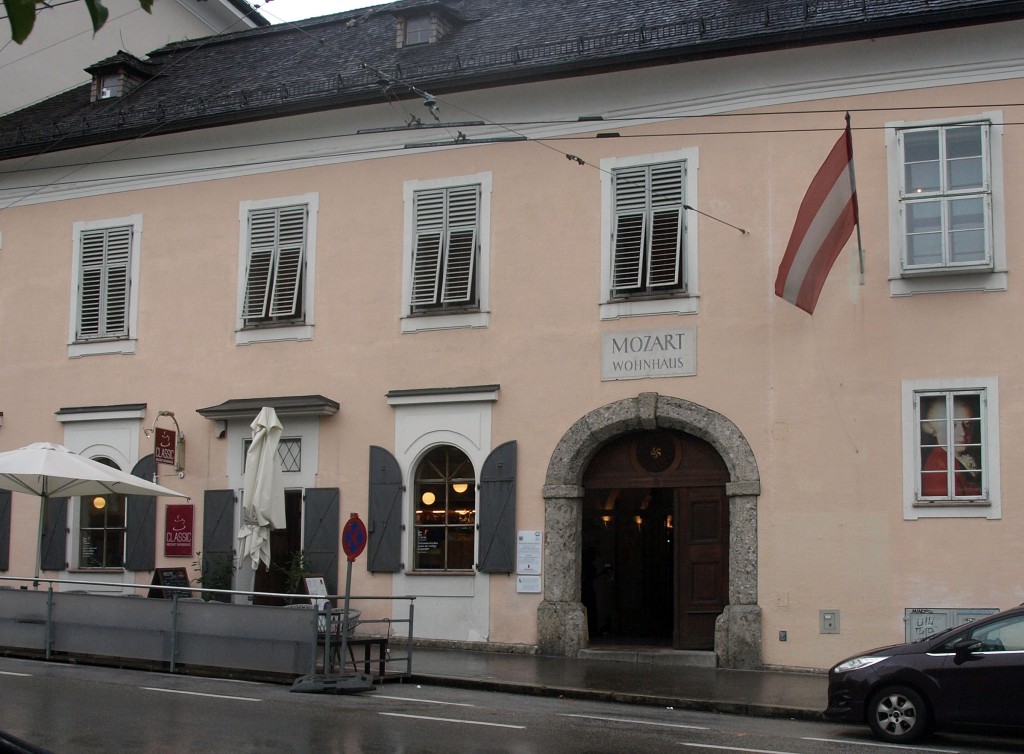
And then, before retreating to the hotel, we looked at the adjoining birthplace of the physicist Christian Doppler (the effect named for him is well-known, especially if you think of train whistles and police sirens). Perhaps not the most famous son of Salzburg, but a notable one nonetheless.
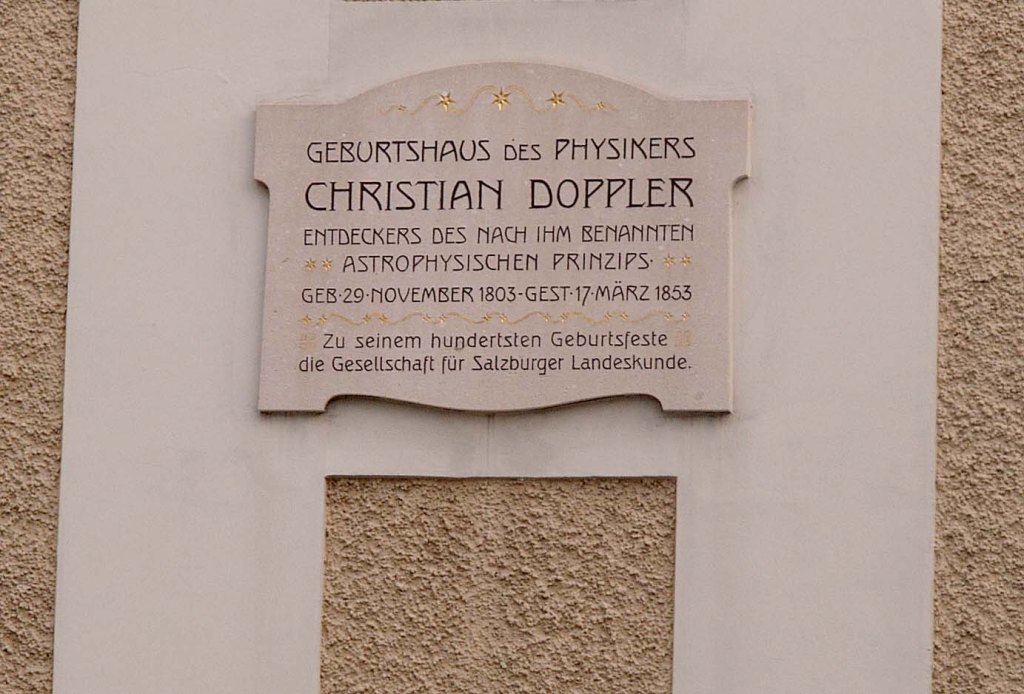
Previously: Day 8, More Salzburg
Next: Days 10 & 11, Ulm
More photographs can be seen on my Flickr page.
What I did on my holidays, 8 – more Salzburg

Today’s plan was to meander along the bank of the river (the Salzach) and then around the top end of the Old Town, before heading for the Marionette Theatre for a performance of Mozart’s Magic Flute (Die Zauberflöte). The riverbank was just a couple of streets away from the hotel and the riverside path was well provided with shade from the sun and benches to sit and people-watch.
Eventually, we stirred ourselves and wandered towards town, crossing the river by the Müllnersteg bridge. Once on the other side, we found ourselves at one end of an extensive craft and art market that extended all the way down the Franz Josef-Kai. In between the craft stalls were refreshments, and we stopped for a glass of wine.
Once we reached the Old Town, we headed for the Mönschberg lift, which gave access to a viewing promenade that offered a panorama of the whole city.

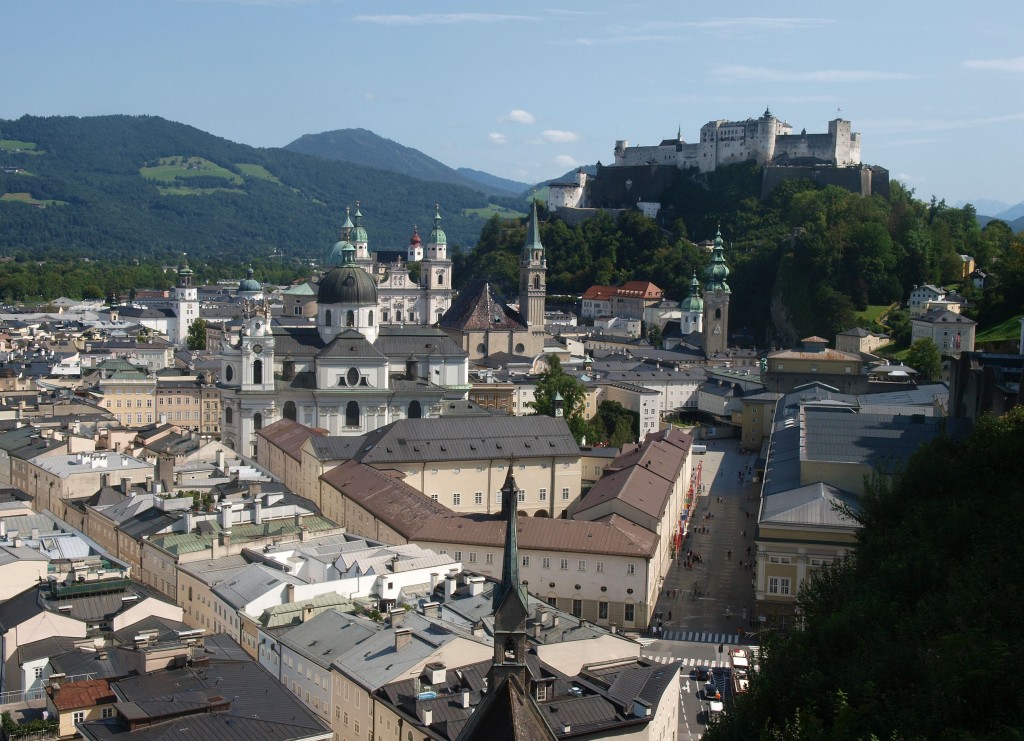
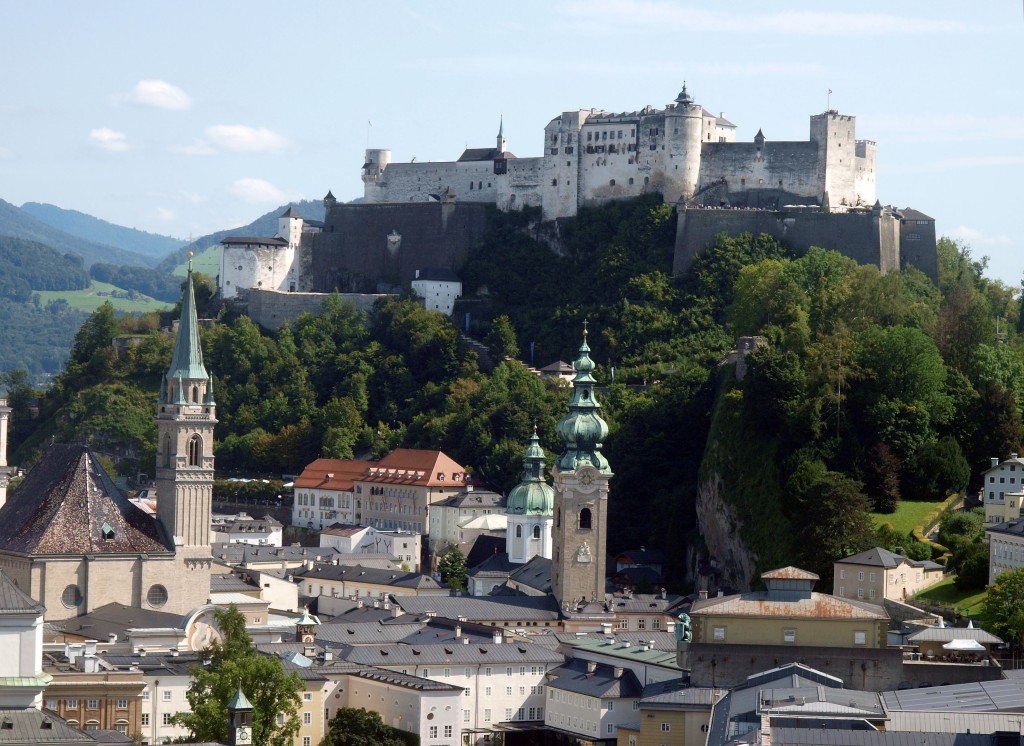
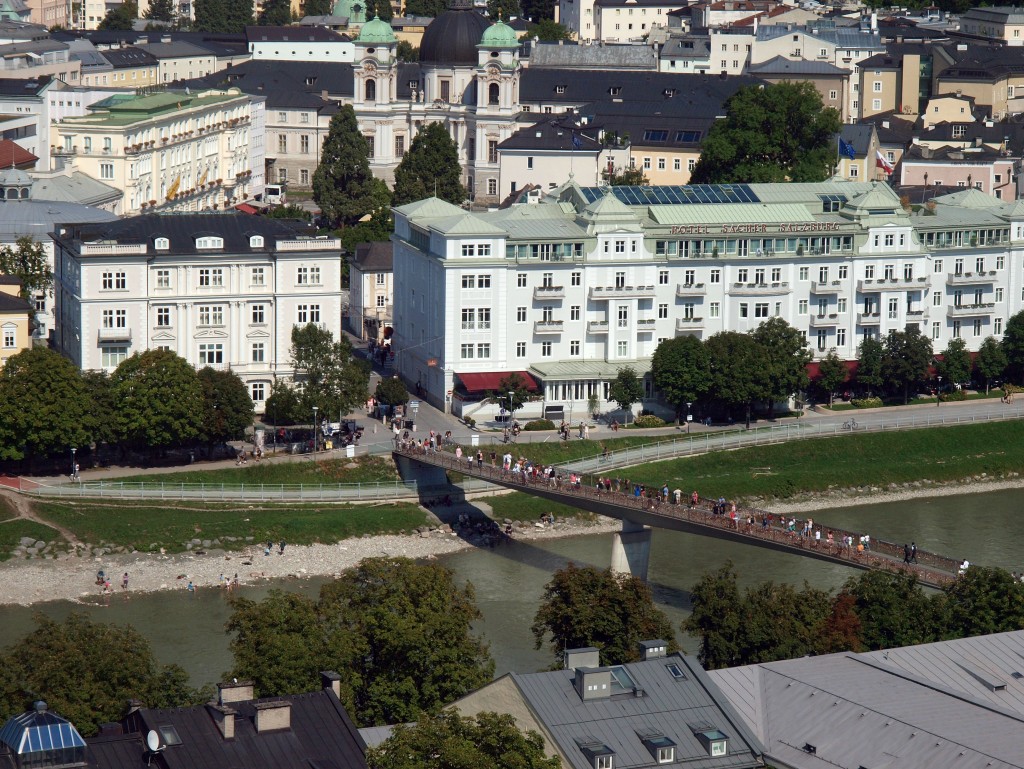
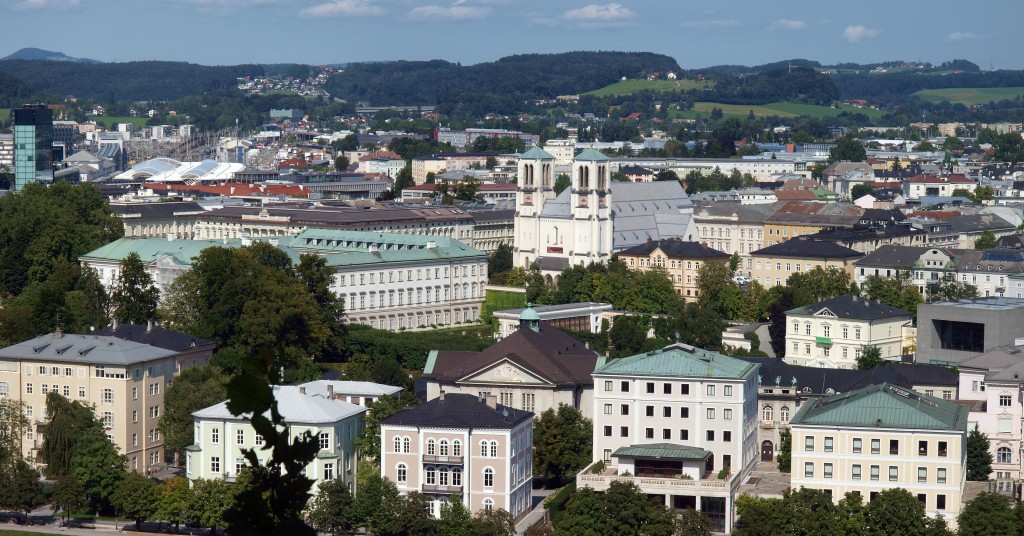
If any of you watched the BBC dramatization of Philip Pullman’s His Dark Materials (now available on DVD), you might be having a moment of deja vue, because a digitally altered version of Salzburg was used to represent Geneva, seat of the Magisterium, in Season 3. Why anyone thought that Salzburg could substitute for Geneva is beyond me. For one thing, Salzburg lacks any sort of lake, let alone Lake Geneva…
We cut short our wanderings to return to the hotel to get ready for our night out.
The Salzburg Marionette Theatre is located in a former casino building, itself of considerable note. The foyer and the corridor to the auditorium has many fascinating displays of the history of puppetry. This is no mere novelty, but rather full-blown theatre in miniature. They have an extensive repertoire of operas, plays and ballets from retellings of fairy tales up to major operatic undertakings, such as Wagner’s Ring cycle (admittedly compressed to two hours’ duration). Their production of Humperdinck’s Hansel and Gretel reflects the composer’s background in having worked with Wagner, though from what I’ve seen, I’m unsure how much someone had their tongue in their cheek – the gingerbread house is unmistakeably Wagner’s own Bayreuth Festspielhaus!
The theatre company was founded in 1913 and moved to its present location in 1971. It has toured worldwide, and the decoration in the theatre bar shows examples of the company’s playbills from around the world. The puppetry is of a very high order; even the walking motion, which defeats many marionette designers and operators, is convincing.
The production of The Magic Flute is in no way inferior to a full-scale production except in the matter of physical size. All the characters and effects are there, including intelligent set design, lighting and on-stage pyrotechnics. All the major set-pieces are there, and do not fail to impress – the great aria by the Queen of the Night is as impressive as you could wish for. The recording used is the 1955 performance featuring Dietrich Fischer-Dieskau amongst others, with the RIAS Symphony Orchestra, Berlin (later known as the Berlin Radio Symphony Orchestra and now the Deutsches Sinfonie-Orchester Berlin) conducted by Ferenc Fricsay. This was a staple of the Deutsche Grammophon catalogue for years, and in the era of digital transfers, the recording comes up perfectly well. You would not know you were listening to a recording that will soon celebrate its seventieth anniversary.
Attending this performance was one of the highlights of our trip and it did not disappoint. The weather, however, had other plans; the high temperatures we’d experienced up to now were replaced by a downpour of rain, which was to continue for the rest of the holiday. Did we let that stop us? Read on…
Previously: Day 7, Hot Old Town
Next: Day 9, wet Salzburg
More photographs can be seen on my Flickr page.
What I did on my holidays: 7 – hot Old Town
After the pyrotechnics of the previous night, it didn’t seem any cooler in the morning. We took ourselves to the Old Town for a look around and to try to secure some supplies. It wasn’t long before refreshment was necessary, in the form of a beer at a street café (or Imbiß) which gave the opportunity for some gentle people-watching. So fortified, we set out again and headed toward the Old Town and the cathedral square, or Domplatz.
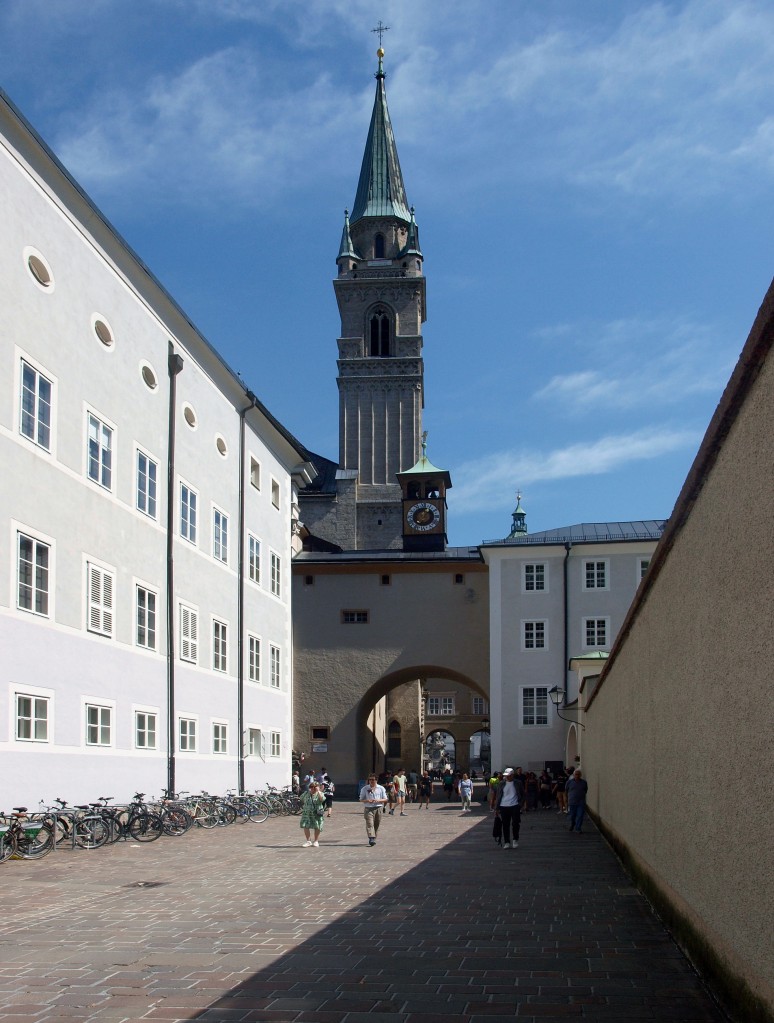
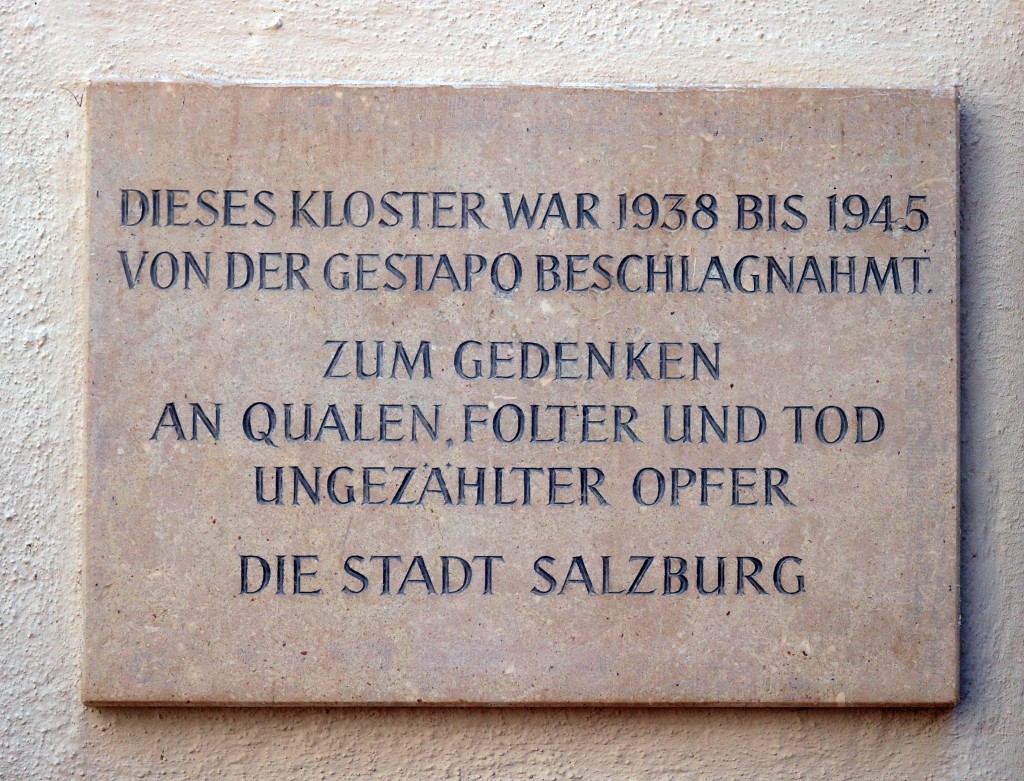
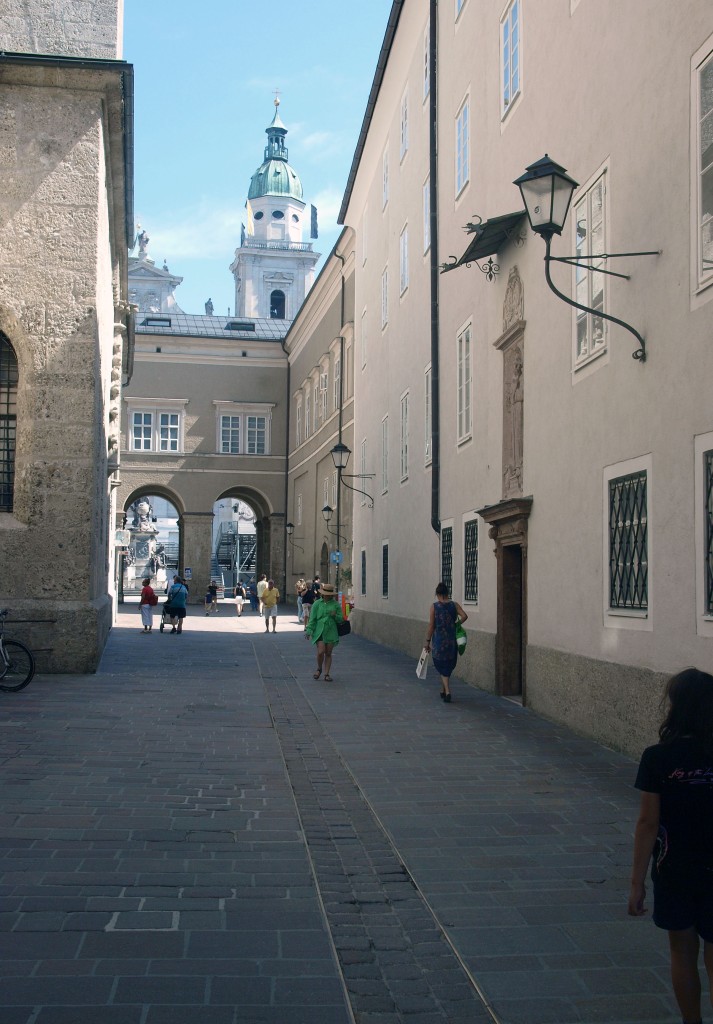
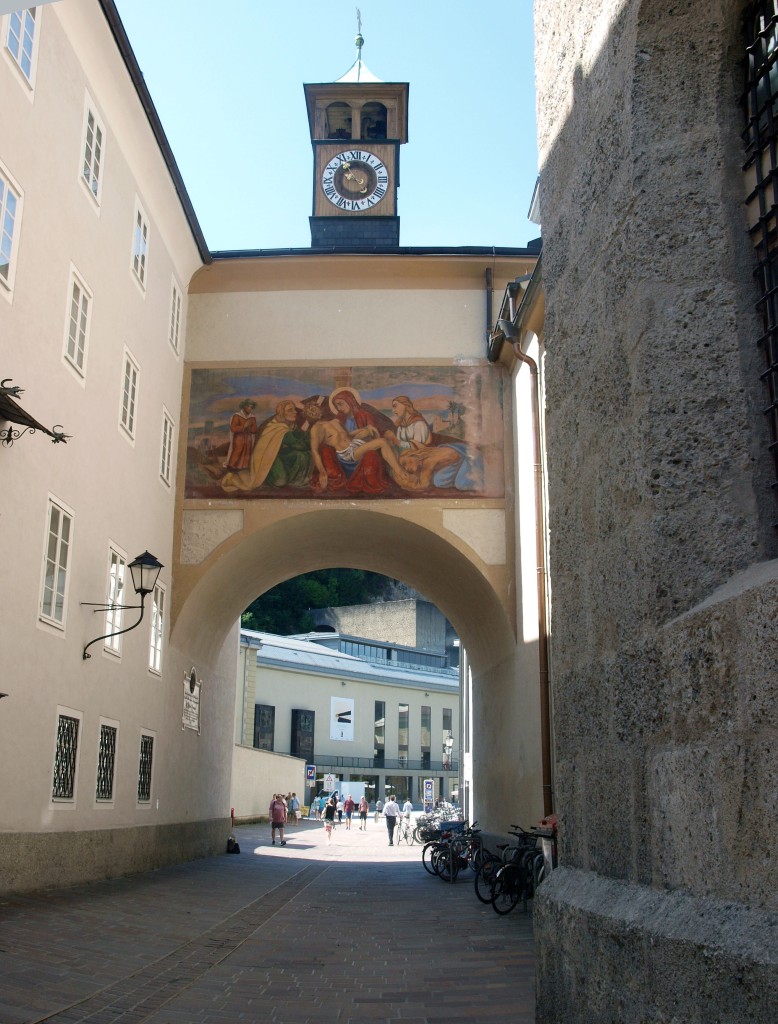
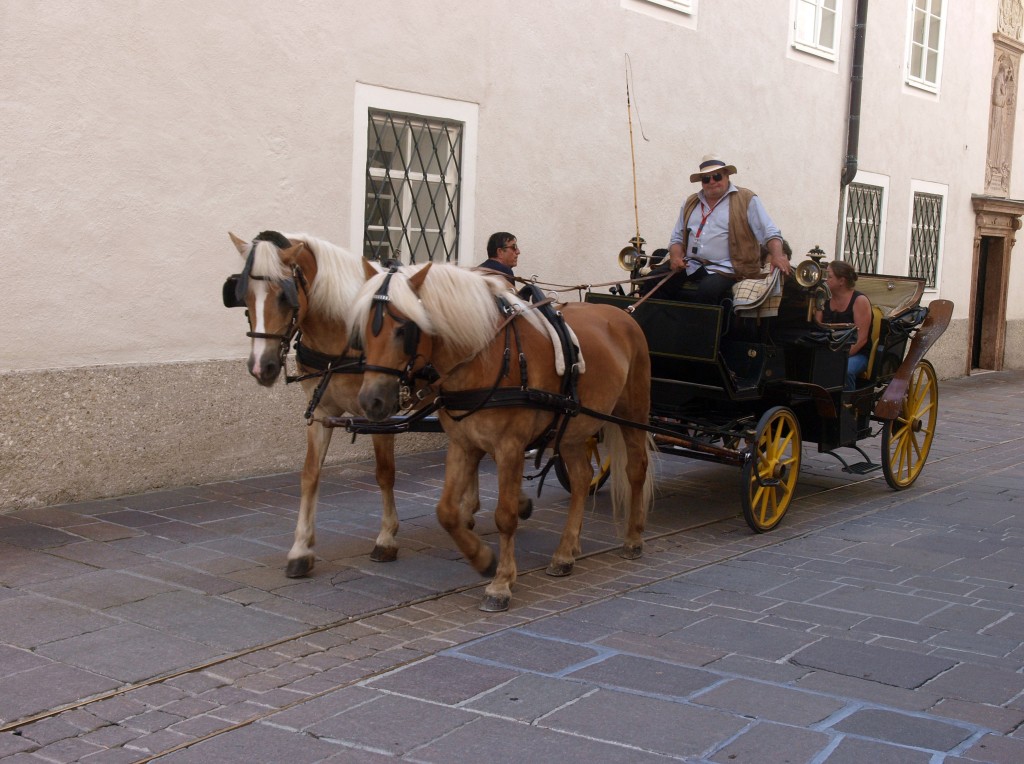
The plaque outside St.Peter’s monastery, marking its use by the Gestapo, is a sign of changing times. Increasingly, a new generation in Austria is memorialising those who suffered during the Nazi regime, and similar plaques have appeared at various places in Austria in the past ten years or so. Marking past events is important: it may help later generations avoid making the same mistakes, or even new ones.
In a bit of a lapse in forward planning, we had arrived in Salzburg during the Festival week. I’d checked out some concert ticket prices before travelling, only to find that at this late stage, all that was available were the eye-wateringly expensive seats. The presence of the Festival meant that the town was very crowded, and also that certain parts of the Old Town had had outdoor auditoria installed. Hence the view of the frontage of the cathedral was mainly blocked by the seating for the traditional outdoor performance of Hugo von Hofmannsthal’s Jedermann (Everyman), a 1911 reworking of the 15th-century English morality play.
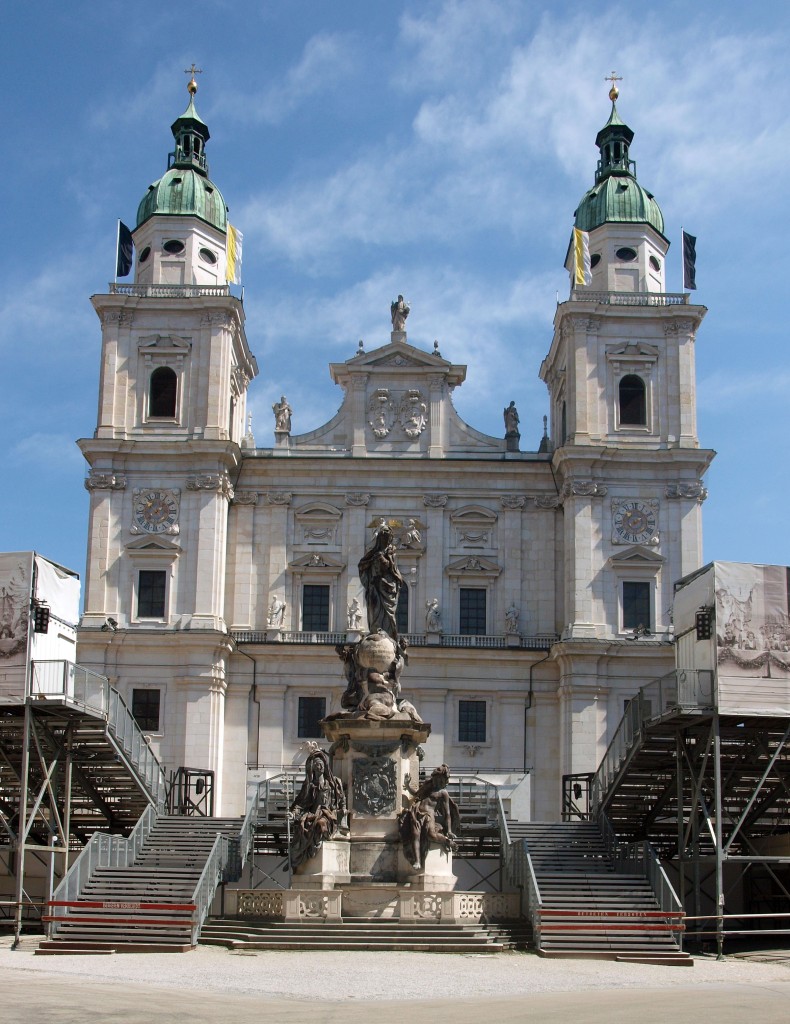
We carried on into the Kapitelplatz, where ice creams were taken whilst we sat and watched a couple of chess hustlers playing on a street chessboard. Further wandering brought us to a house where a plaque commemorated the 16th-century physician Paracelsus:

A little further on, we came to the Mozartplatz, and had to step around someone manhandling a piano across the square. It seemed that we had happened upon an open piano being set up to raise money for music projects for the disadvantaged. For a couple of hours we were treated to a succession of different people – probably music students – playing a succession of classical and jazz piano pieces, all in the shadow of a statue of Mozart.
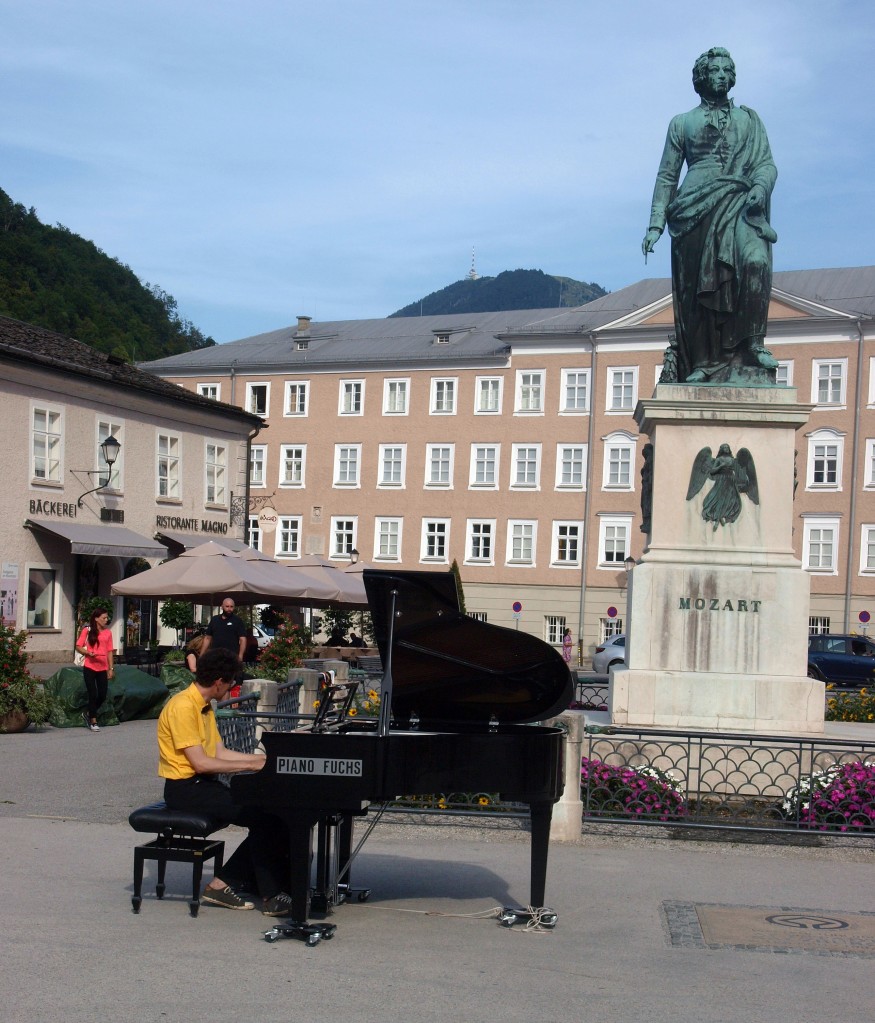
Finally, to round off the day, we retired to an Italian restaurant across the square, and enjoyed a fine meal at a pavement table, still with a piano accompaniment.
Previously: Day 6, The journey to Salzburg
Next: Day 8, More Salzburg
More photographs can be seen on my Flickr page.
What I did on my holidays: 6 – Moving to Salzburg
Today we transferred from Innsbruck to Salzburg.
There was time for a little photography on Innsbruck station before our train.
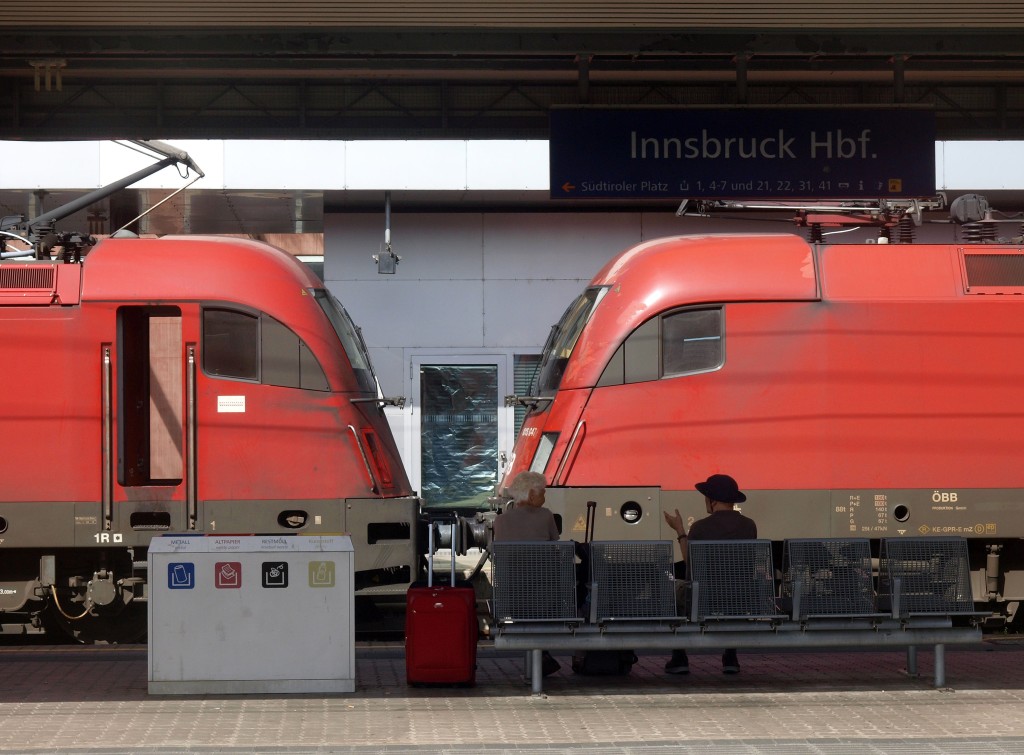
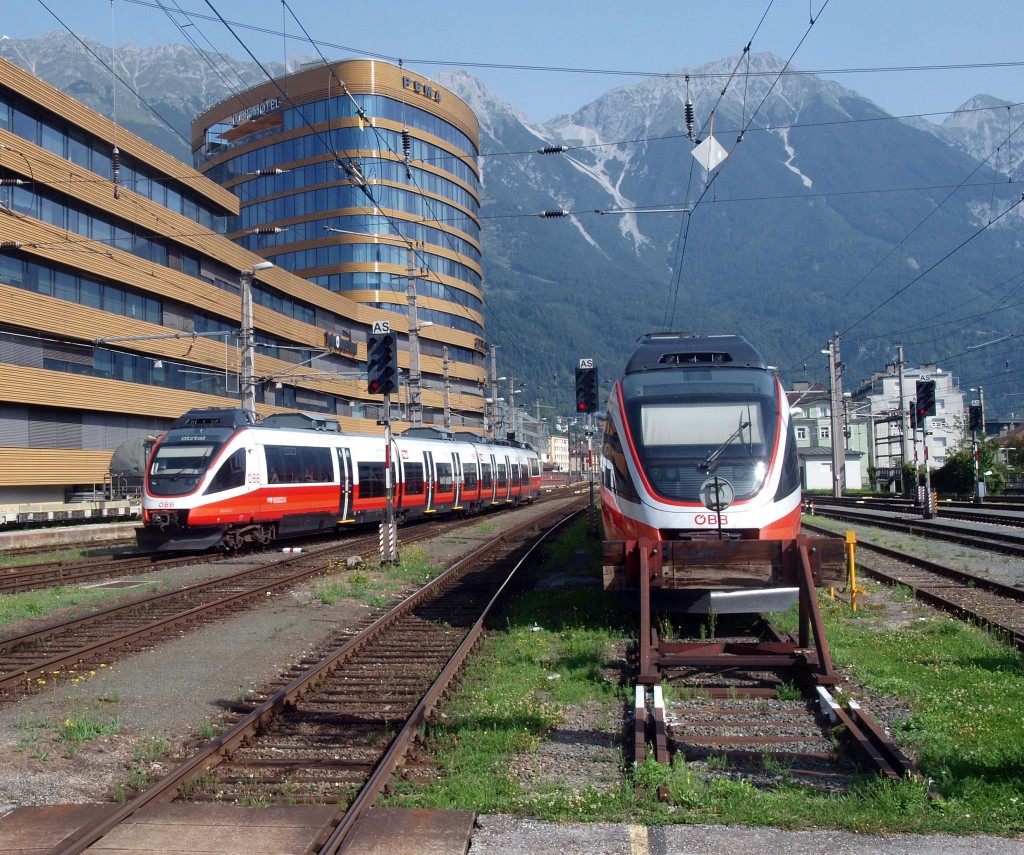
Leaving Innsbruck, I was able to capture two last views of the Nordketten, including a clear view of the Hungerberg funicular ascending the mountain.
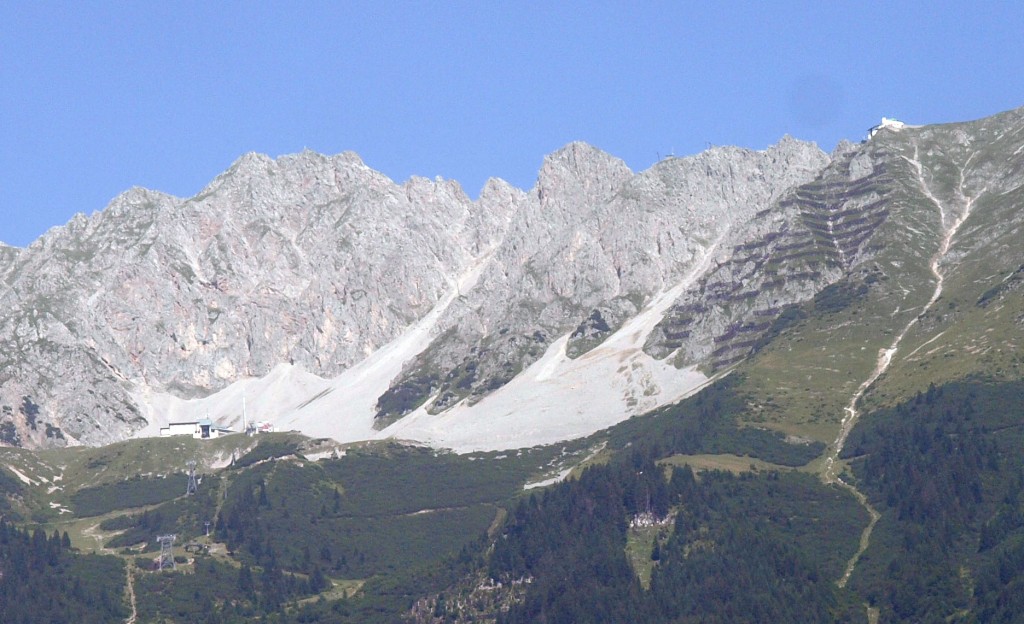
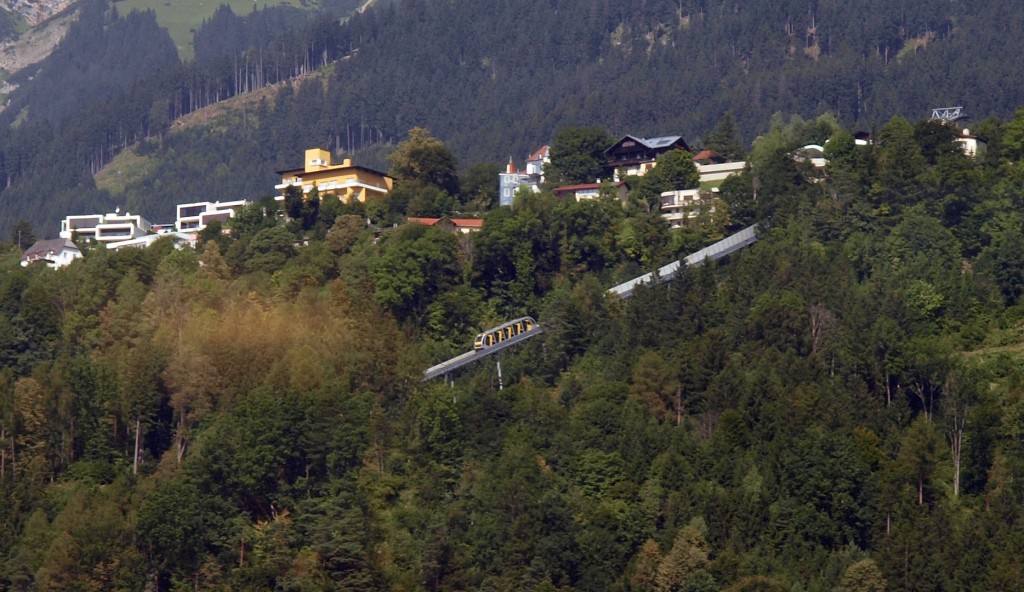
The journey took us along the Inn valley to Wörgl. Since I last travelled this way, the line between Innsbruck and Jenbach has been upgraded to a high-speed route, and much of the journey was in tunnels. This seems to be a feature of recent line upgrades in Austria; perhaps nowadays, people on trains are so engrossed in their devices that they don’t mind missing the scenery. But for me, that’s one of the reasons for visiting Austria, and the tunnel running was a bit of a disappointment. Then the train turned to the north past Kufstein, and then ran through Bavaria, joining the Munich – Salzburg main line at Rosenheim before re-entering Austria.
Arrival at Salzburg resulted in our stepping off the train into even hotter and more humid conditions than we had at Innsbruck. After checking in to our hotel (which fortunately did have air conditioning), we went out on a shopping expedition, and on the way back stopped outside the Volksschule on the Faberstraße to see the plaque memorialising Einstein’s first symposium on his Theory of General Relativity.
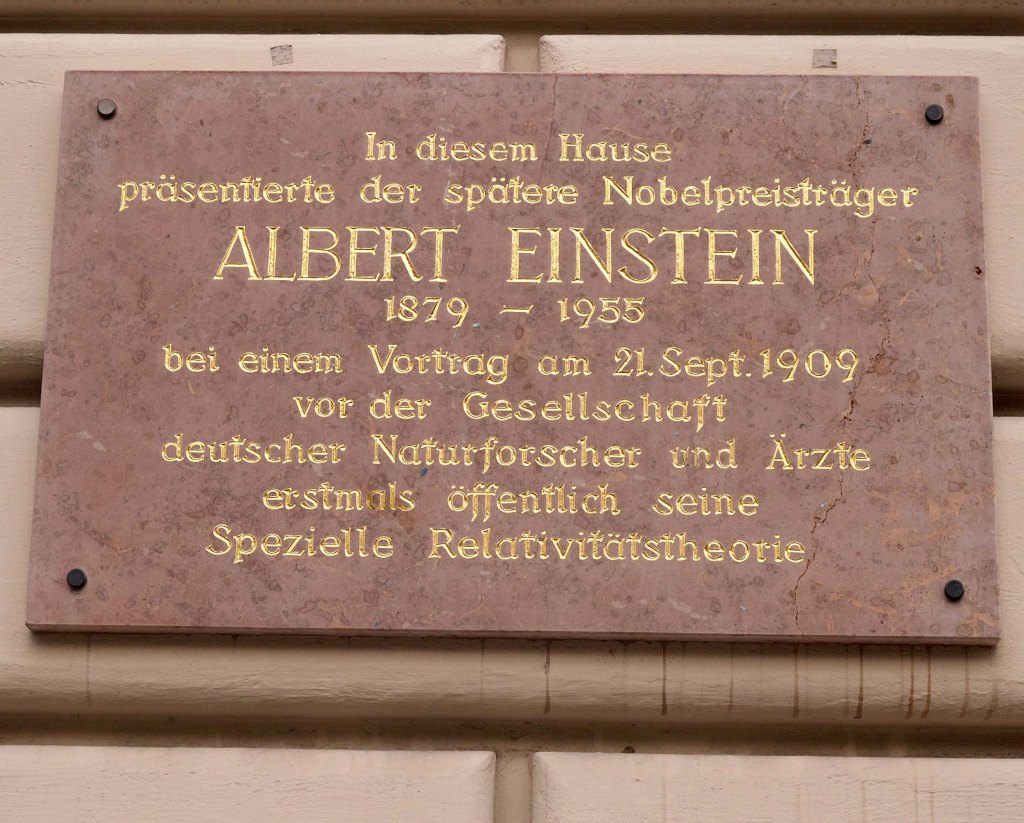
In the evening, there was a massive electrical storm – 45 minutes of continual lightning.
Previously: Day 5, Seefeld
Next: Day 7, Salzburg
More photographs can be seen on my Flickr page.
What I did on my holidays: 5 – The Trip to Seefeld
The plan for today was to take the short but spectacular trip to Seefeld along the railway known variously as the Mittenwaldbahn or the Karwendelbahn. Seefeld is about 22 km away from Innsbruck to the north-west, but it is considerably higher up (1182 metres / 3877 feet above sea level as compared to Innsbruck’s 560 metres / 1837 feet). The main east/west railway through Innsbruck, the Arlbergbahn (along which we travelled to Innsbruck on day 2) runs along the valley floor: the Mittenwaldbahn climbs up the north face of the valley, passing through tunnels and avalanche shelters and over viaducts before turning north to pass through Seefeld before crossing the German border after Scharnitz.
The line was originally built between 1910 and 1912 to make a direct connection with the line from Munich to Garmisch-Partenkirchen, thus creating a direct route between Munich and Innsbruck. The line was planned specifically to use electric traction: the gradients made any other sort of railway other than one using rack assistance impractical. From 1930, the German State Railway (Deutsche Reichsbahn) ran a named express train, the Karwendel Express, from Munich to Mittenwald on the German side of the border, extended to Innsbruck in the high tourist seasons.
I had read a lot about the Mittenwaldbahn over the years, and a trip over it had been on my “to do” list for a while. The choice of Seefeld as a destination was simply a matter of thinking where would be the best place to go with facilities, something to see and places to obtain food and drink.

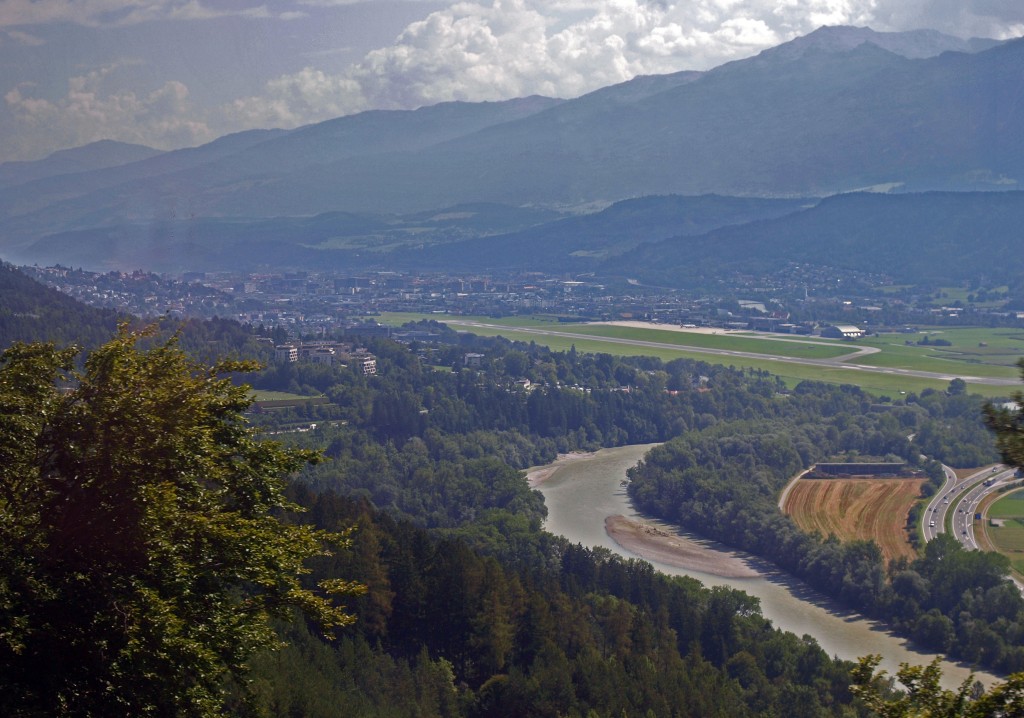


Of the journey, there actually isn’t much to be said; the pictures show things rather better. Services on the line are run jointly by the Austrian and German state railways, so we settled into our seats in a German electric train (a class 2442, for those interested in such things – a class of train nicknamed ‘hamster cheeks’ because of the appearance of the cab ends).
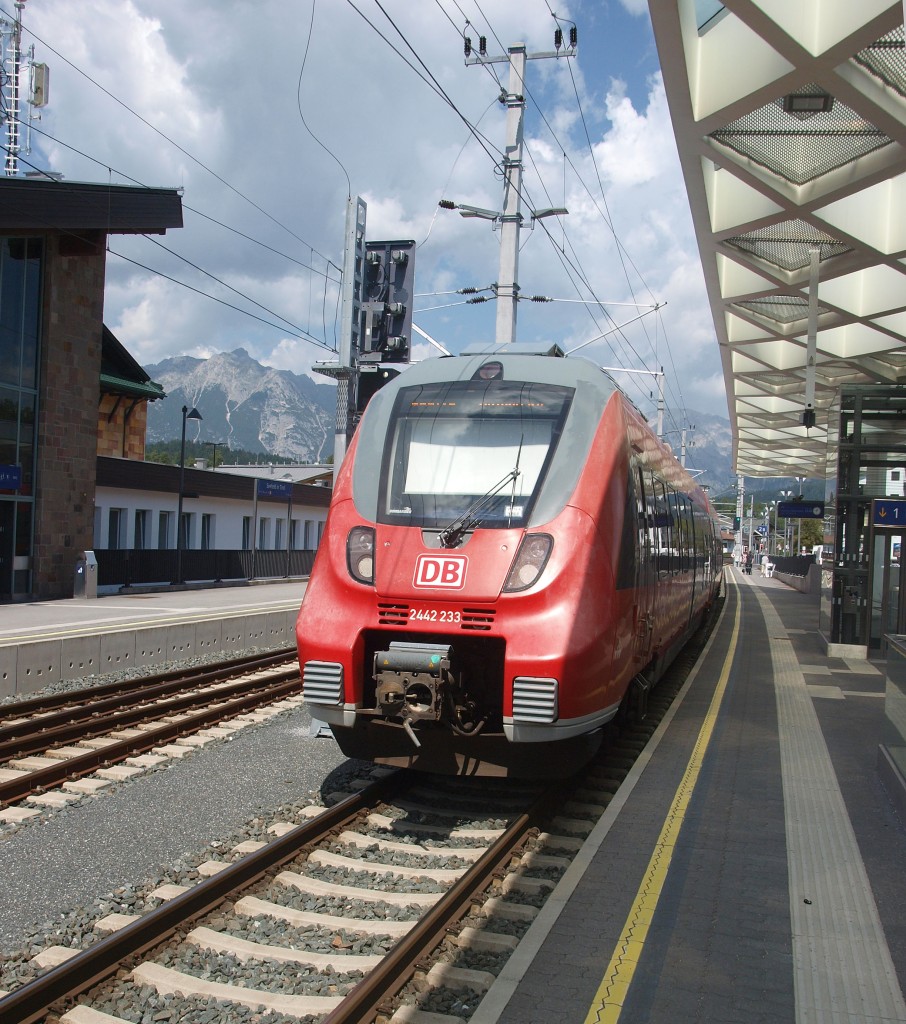
The journey was comfortable and quick, and we were soon getting off the train at Seefeld, where the station opens out almost immediately onto the village centre.
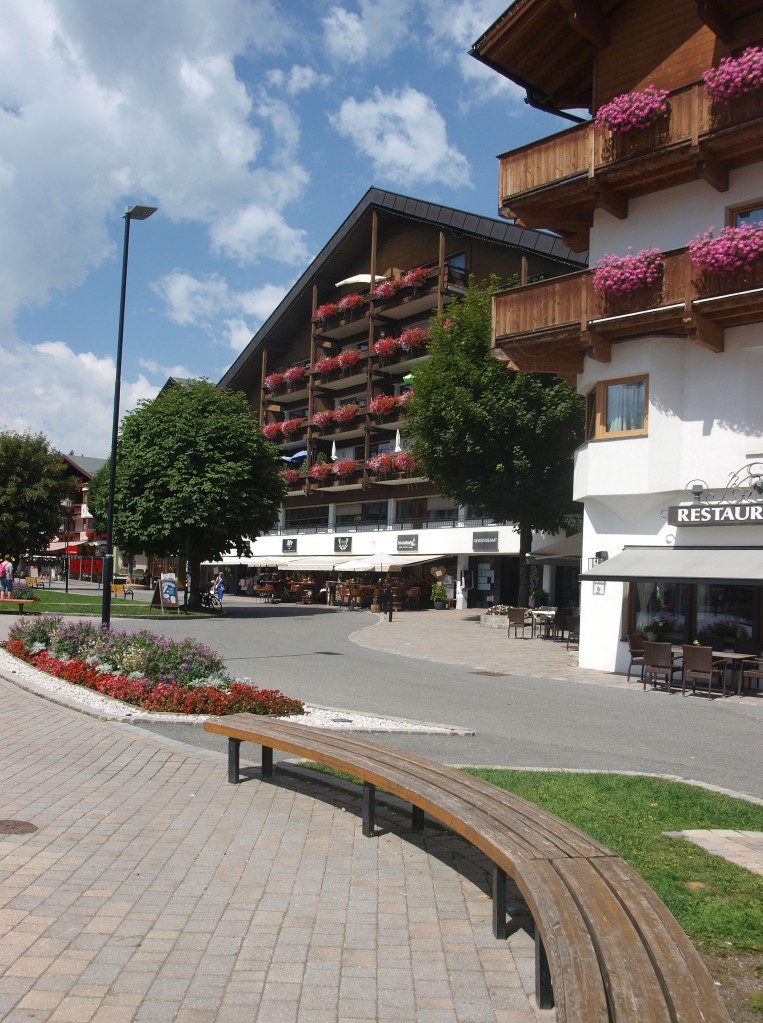
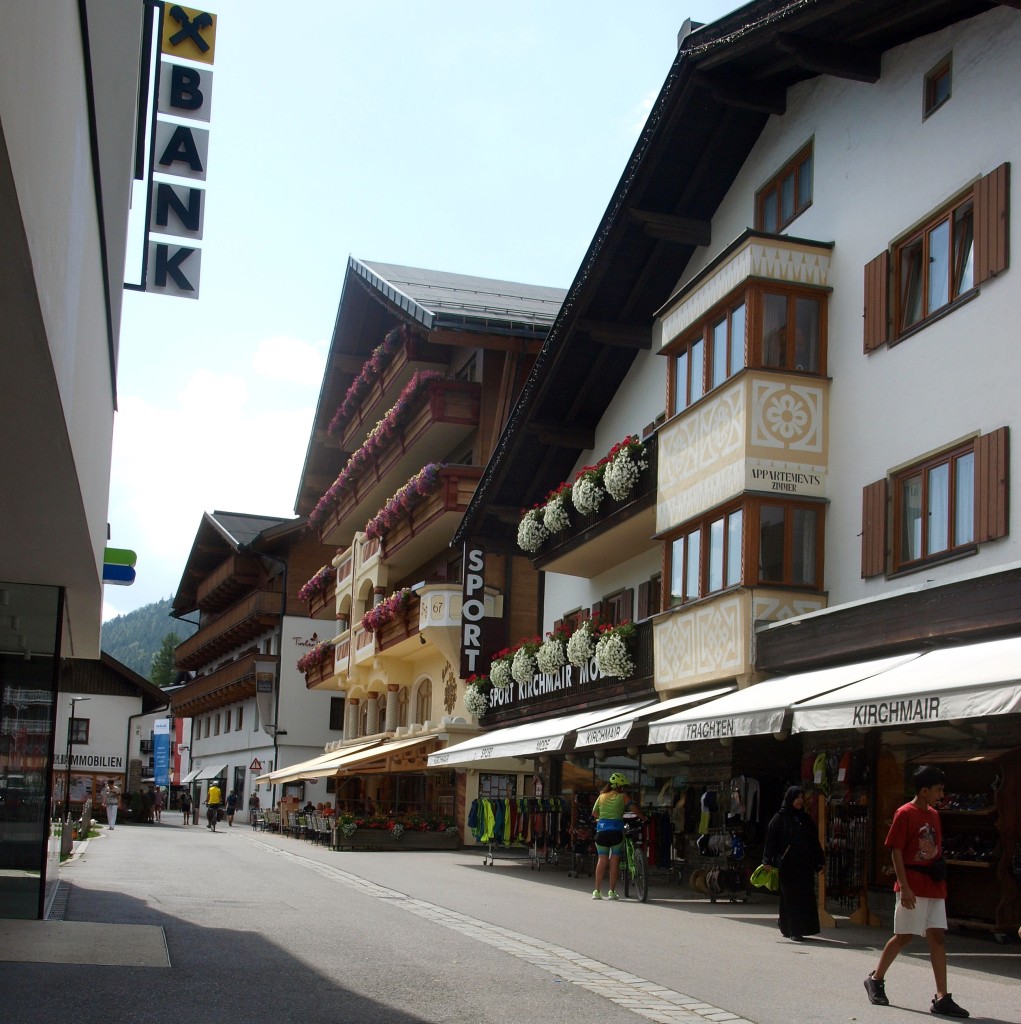
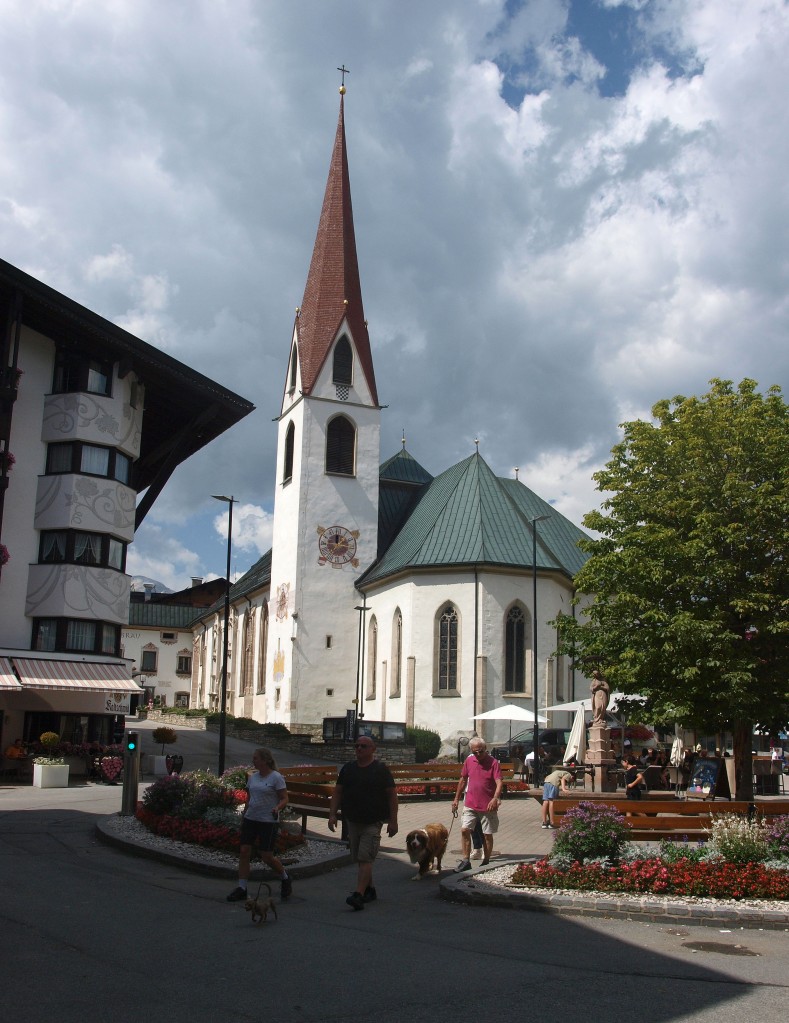
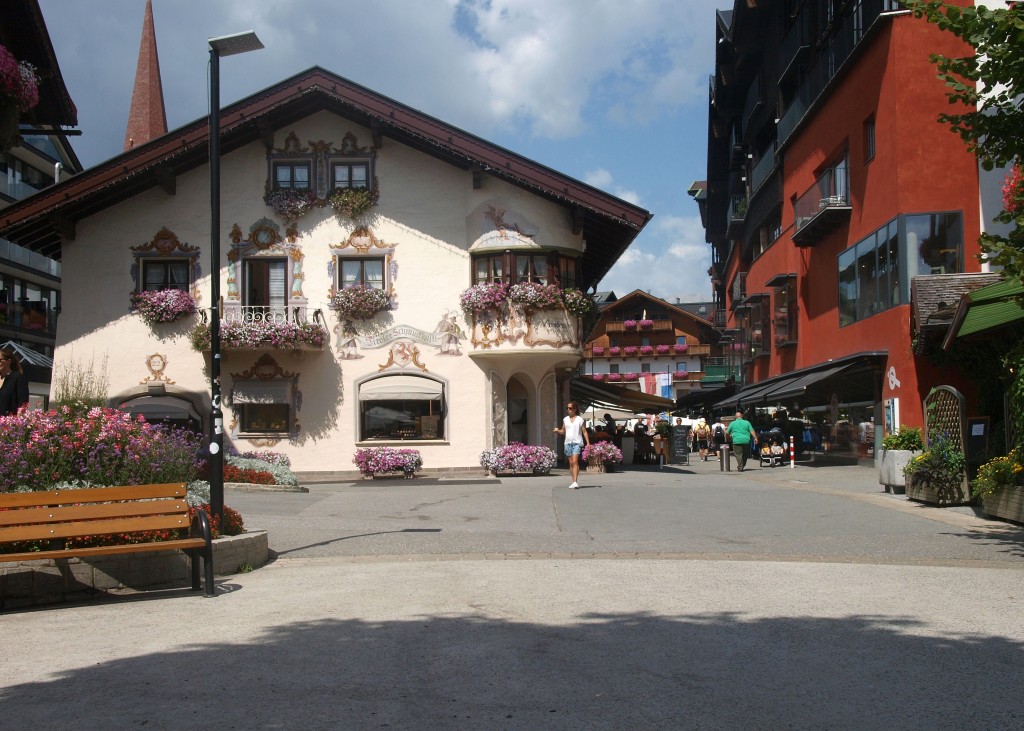
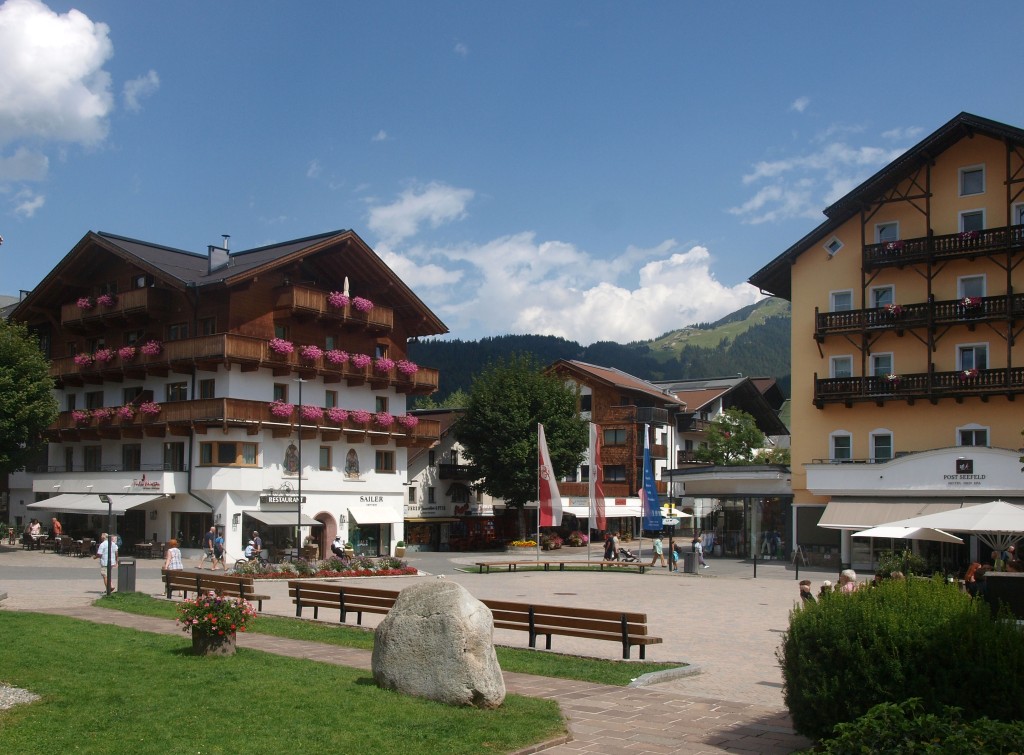
We strolled around, had an ice cream, sat in the church for a bit and listened to a rehearsing singer, and finally made our way back to the train. I know that doesn’t sound like much, but although there were plenty of people around, the place seemed neither busy nor crowded. It was also rather hot, though the weather showed signs of change. Our train arrived to take us back to Innsbruck almost exactly as advertised, this time in an Austrian unit. The scenery was as good going back.
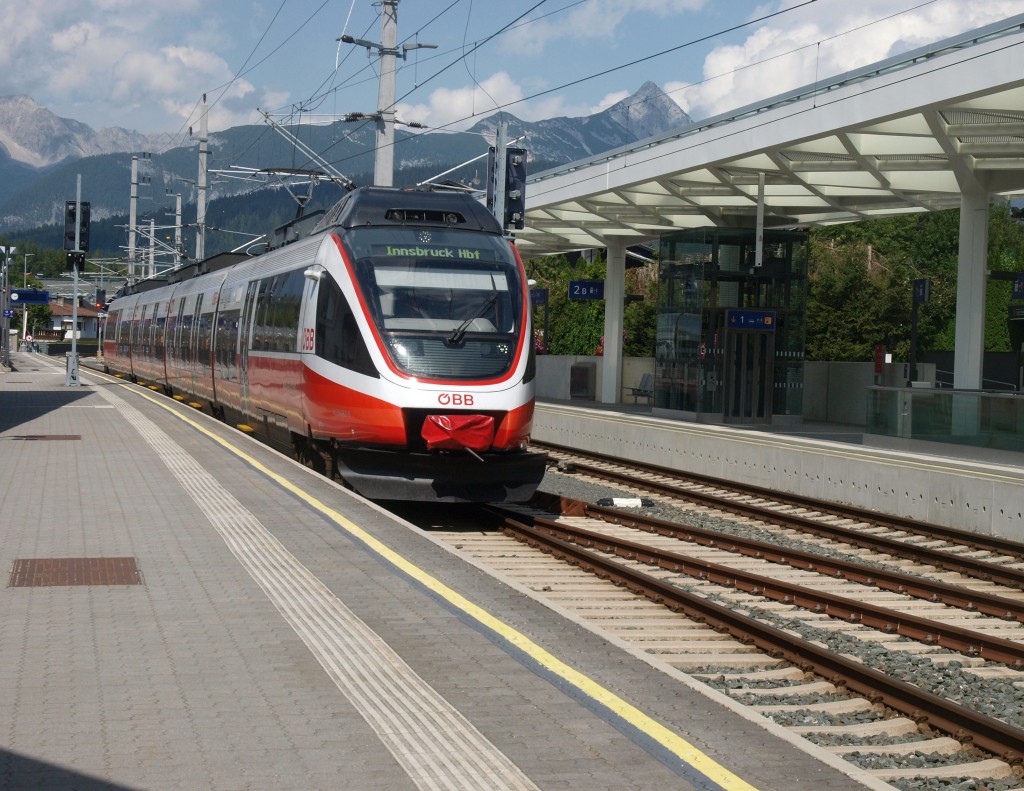
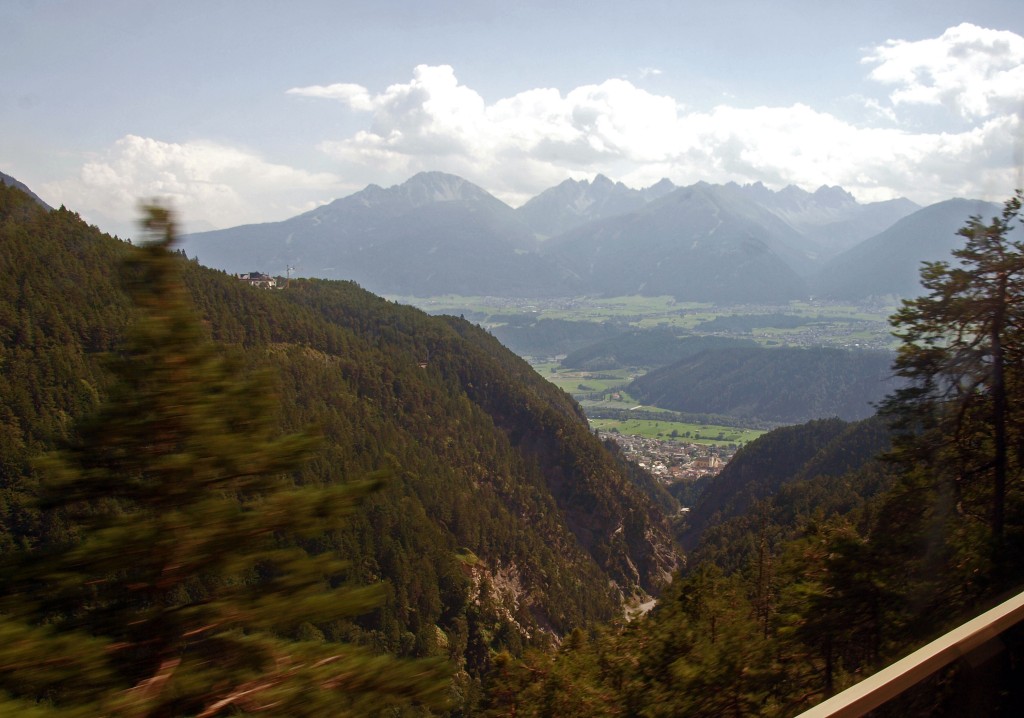
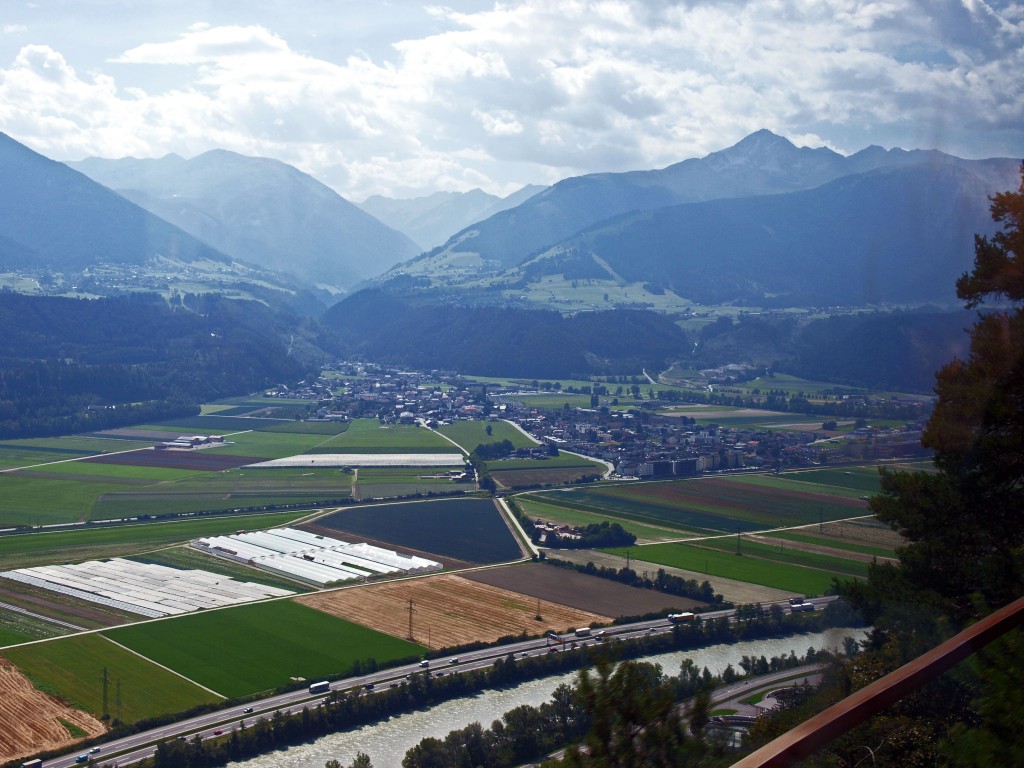
In retrospect, I found the trip that I had long looked forward to a bit of an anti-climax, for two reasons. Firstly, a lot of vegetation has grown up on the slopes over the years, which means that some of the best views, especially those I’d seen in books, were no longer visible. And the other reason is that Austrian trains are now just too modern and efficient! When the line first opened, the journey would take about an hour and fifteen minutes; by the 1930s, that was reduced to between 45 minutes and an hour, depending on the number of stops. Our journey took just over thirty minutes in each direction – very commendable and efficient, but not the scenic experience I was expecting. Perhaps I’ve been spoilt by all the accounts of the panoramic railcars that plied this route for many years until the last remaining one was taken out of service following an accident in 1995. (Its restoration to traffic was not a priority for Deutsche Bahn, and only now does it look anything like it should after years of restoration work by volunteers.) (The link takes you to a page in German.)
Previous: Day 4, Nordketten
Next: Day 6, Transferring to Salzburg
More photographs can be seen on my Flickr page.
What I did on my holidays: 4 – The Ascent of the Nordketten
Our second full day in Innsbruck was taken up with the ascent of the Nordketten, the mountain standing immediately to the north of the city that provides its stunning backdrop.
Calling it “the ascent” makes it sound like more of an adventure than it actually is, because the whole process is mechanised, and you can start from the city centre with the first stage, the funicular Hungerbergbahn, starting from an underground station next door to the conference centre. The railway in its current form replaced an earlier funicular and opened in 2007, with innovative carriages that can adjust to differing gradients along the line, and striking modernist station buildings designed by British architect Zaha Hadid.
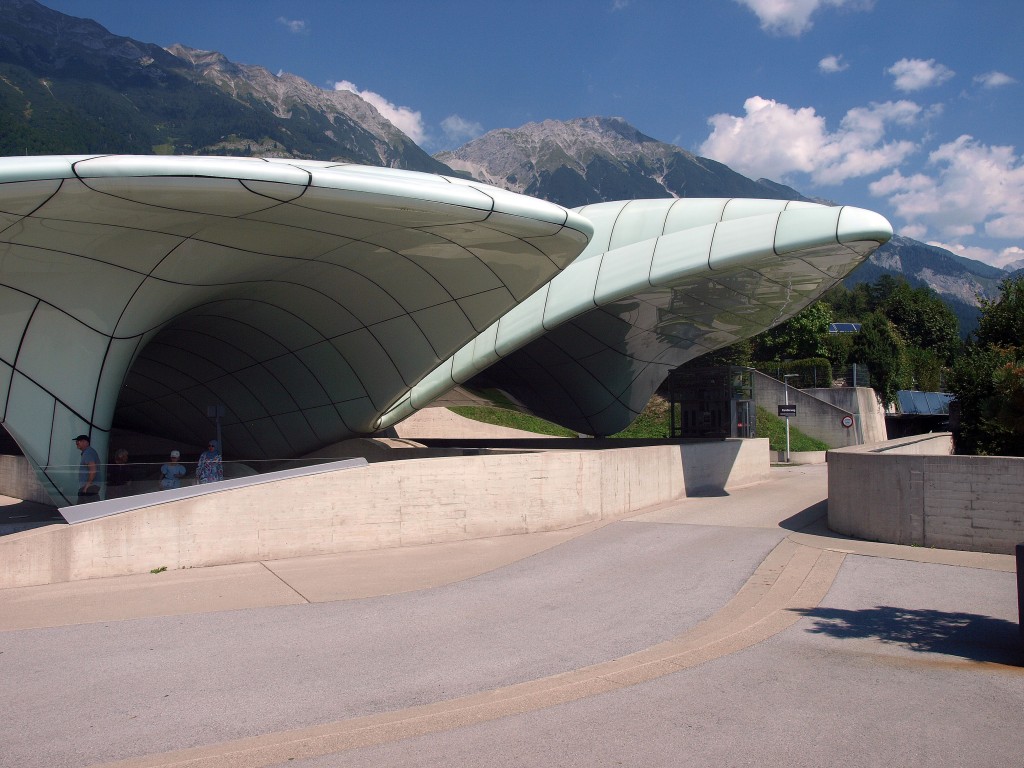
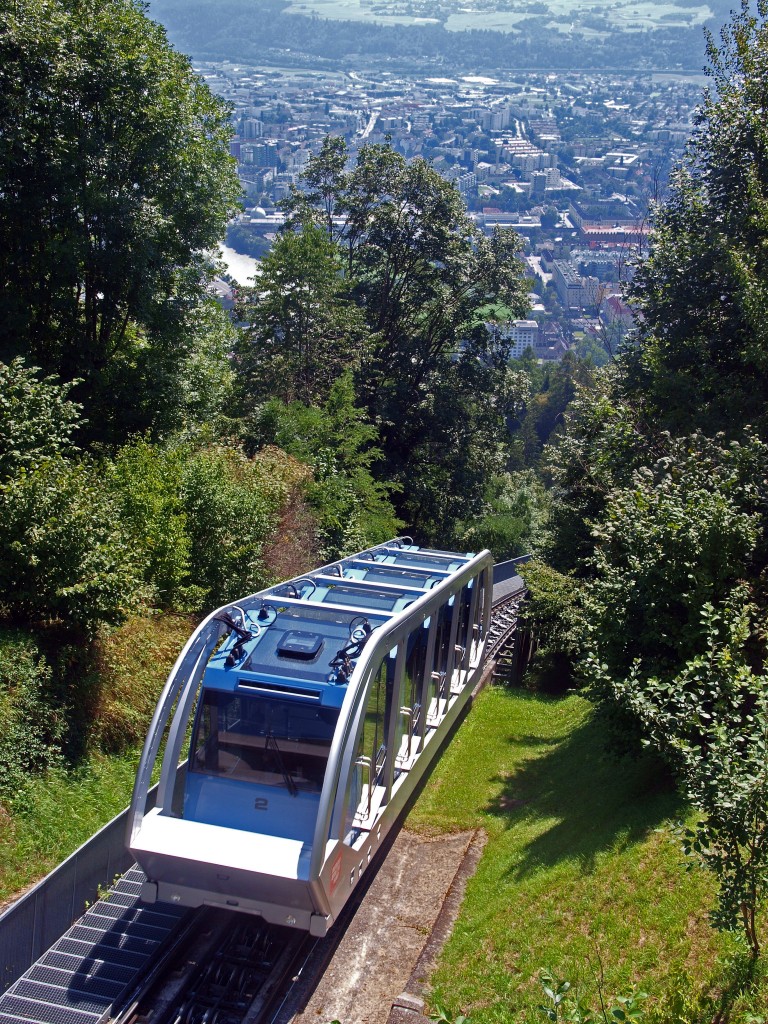
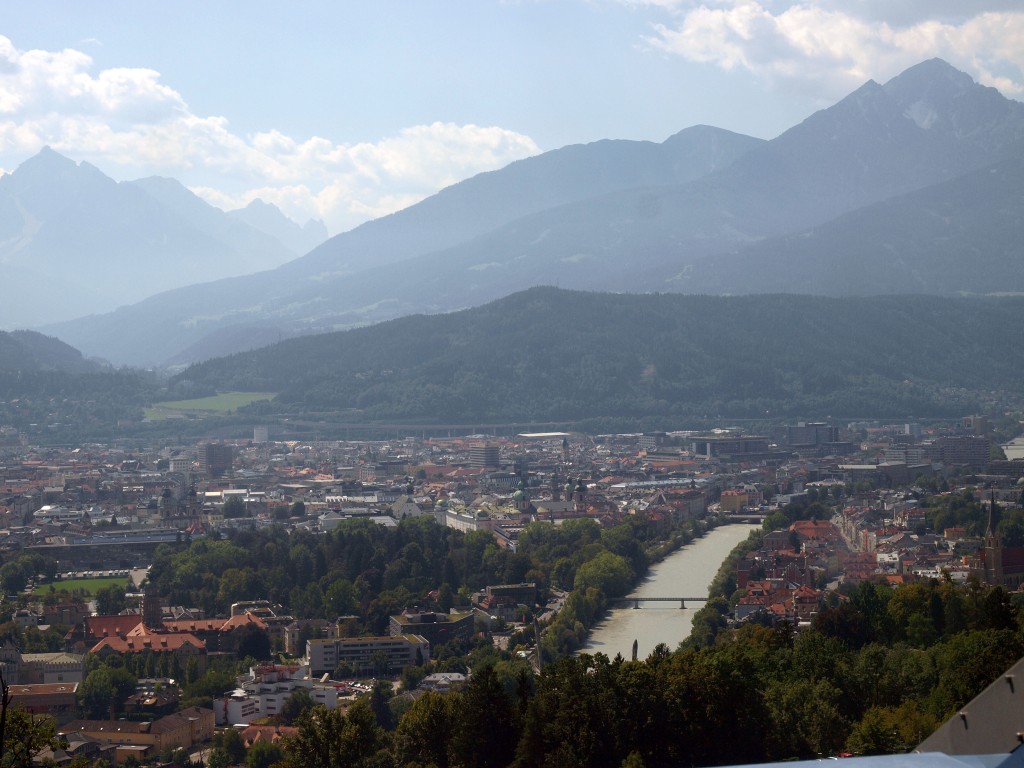
In eight minutes, the funicular whisks you from the centre of Innsbruck (already at 1,837 feet/560 metres above sea level) to the village of Hungerberg (2,820 feet/860 metres). It’s then a short walk to the lower station of the next stage, a cable car up to the next station at Seegrube (6,250 feet/1,905 metres). This cable car was built in the late 1920s, and the station architecture is rather more traditional.
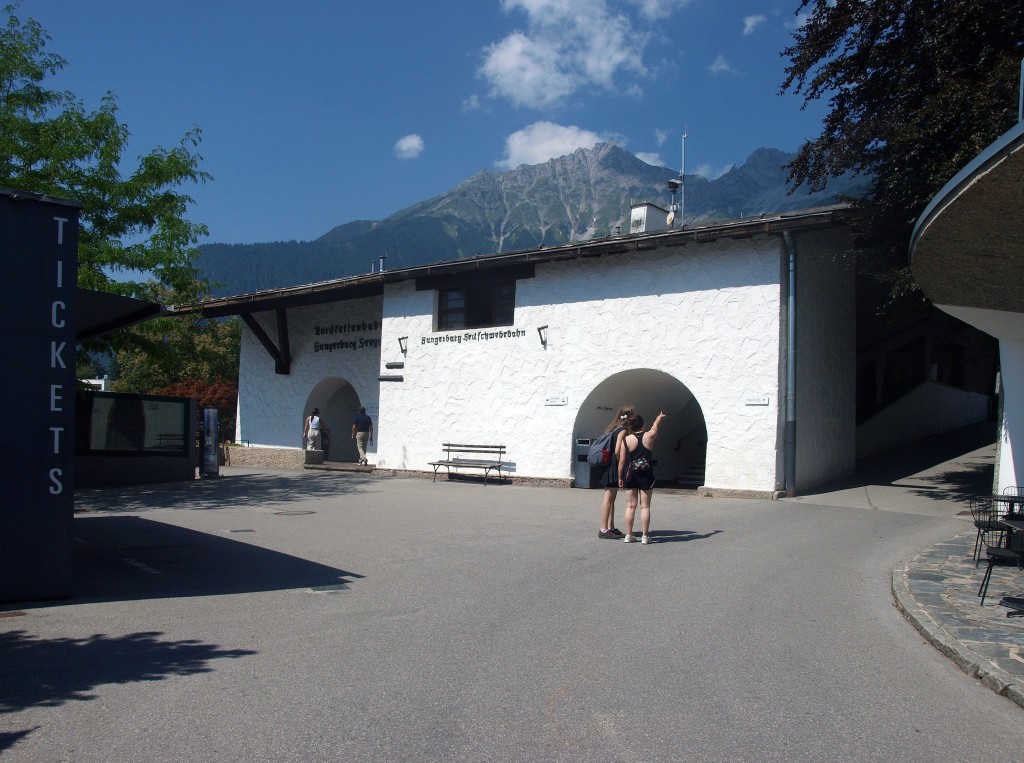
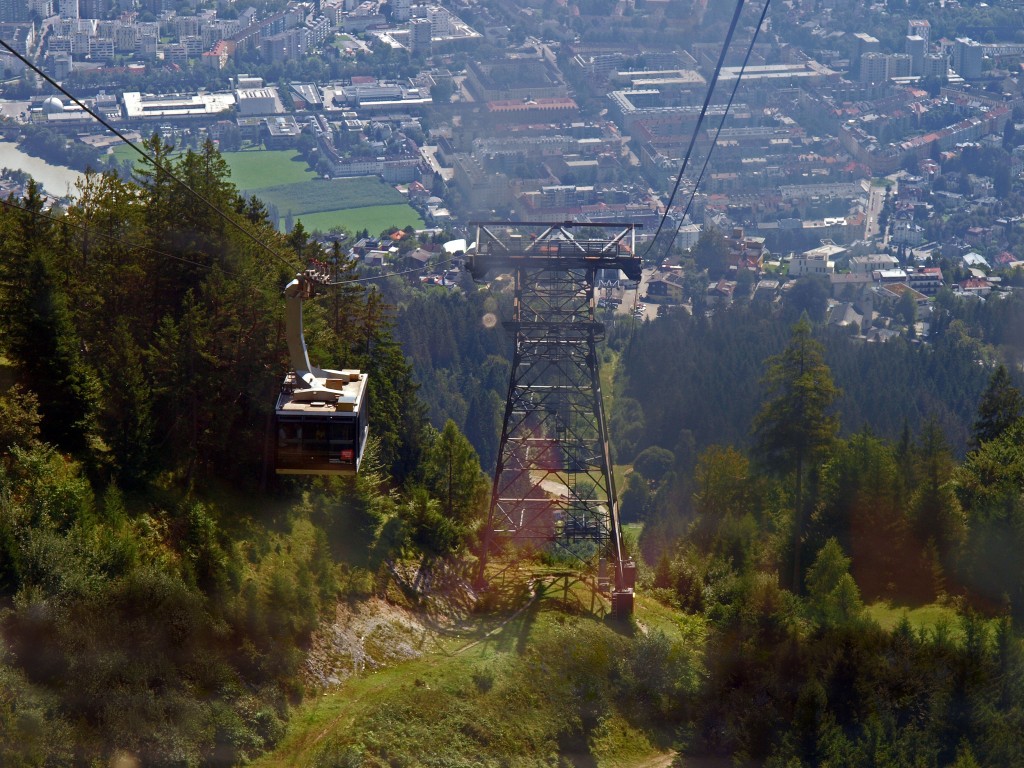
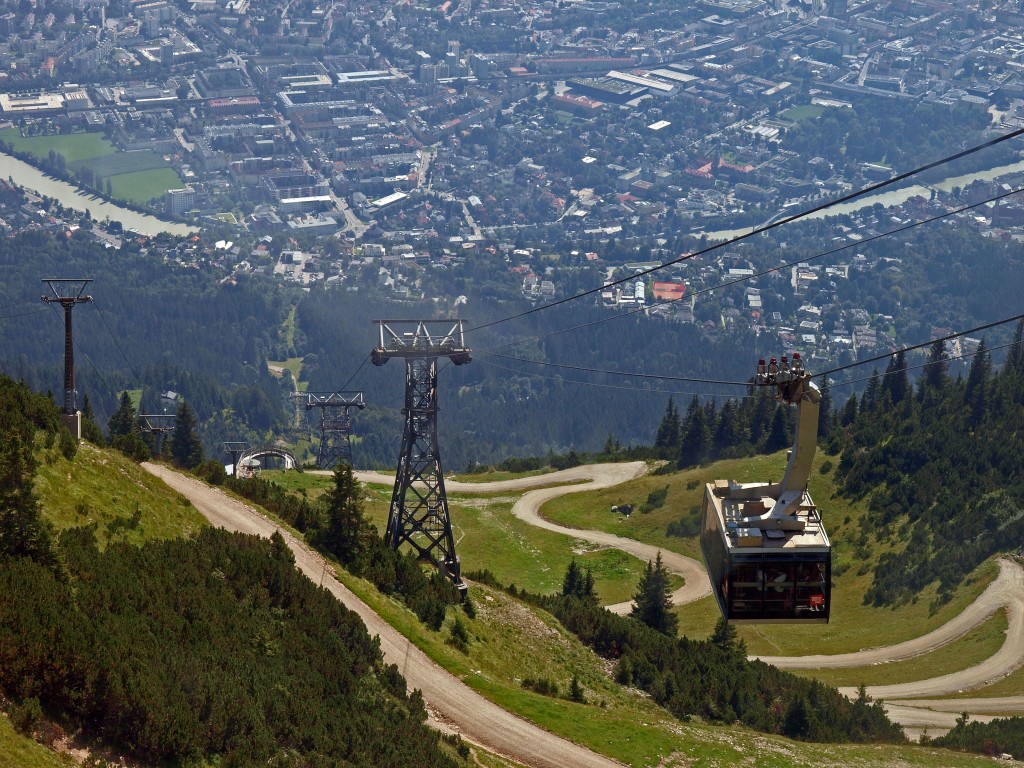
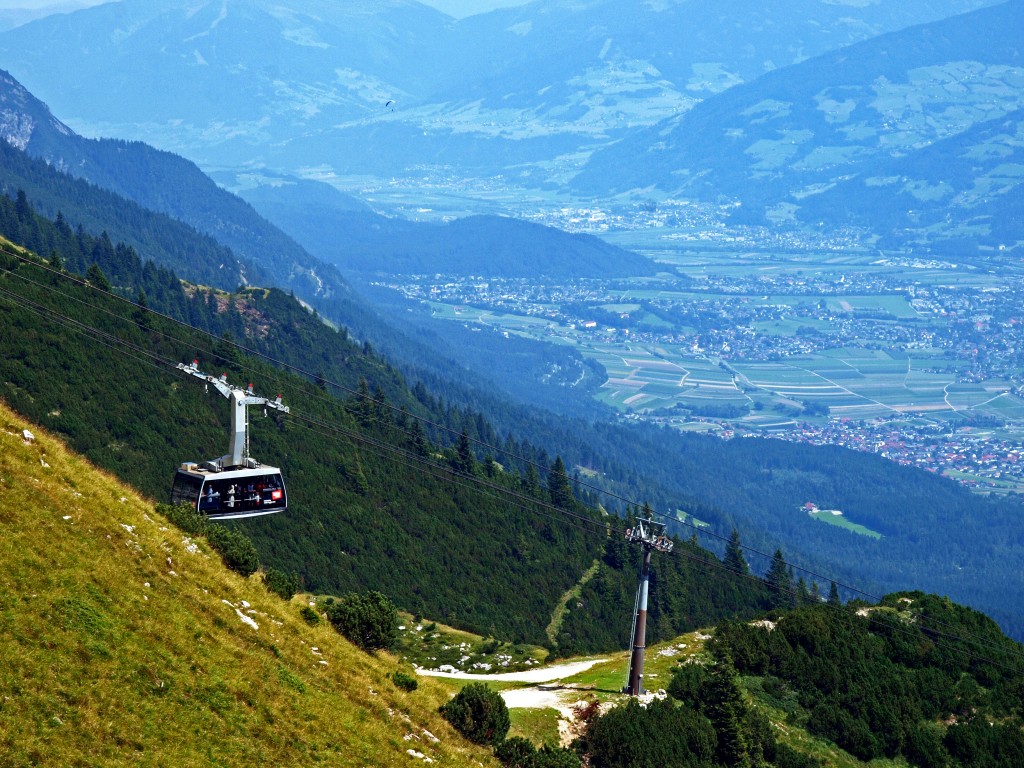

Seegrube has all the usual Alpine facilities – a restaurant, a shop, fantastic views, some improving quotations on some of the windows and a slight air of the James Bond villain’s lair about it. There are extensive paths, play facilities for children, and the infrastructure for winter sports, such as chairlifts, which in the absence of snow look rather strange, like one of J.G. Ballard’s empty swimming pools. We stopped here for a drink, a slice of Apfelstrudel, and to appreciate both the view and the drop in temperature. With a fall in temperature of roughly two degrees Celsius per 1,000 metres, 35 degrees in Innsbruck city centre became 27 degrees at Seegrube – still warm but much more pleasant.
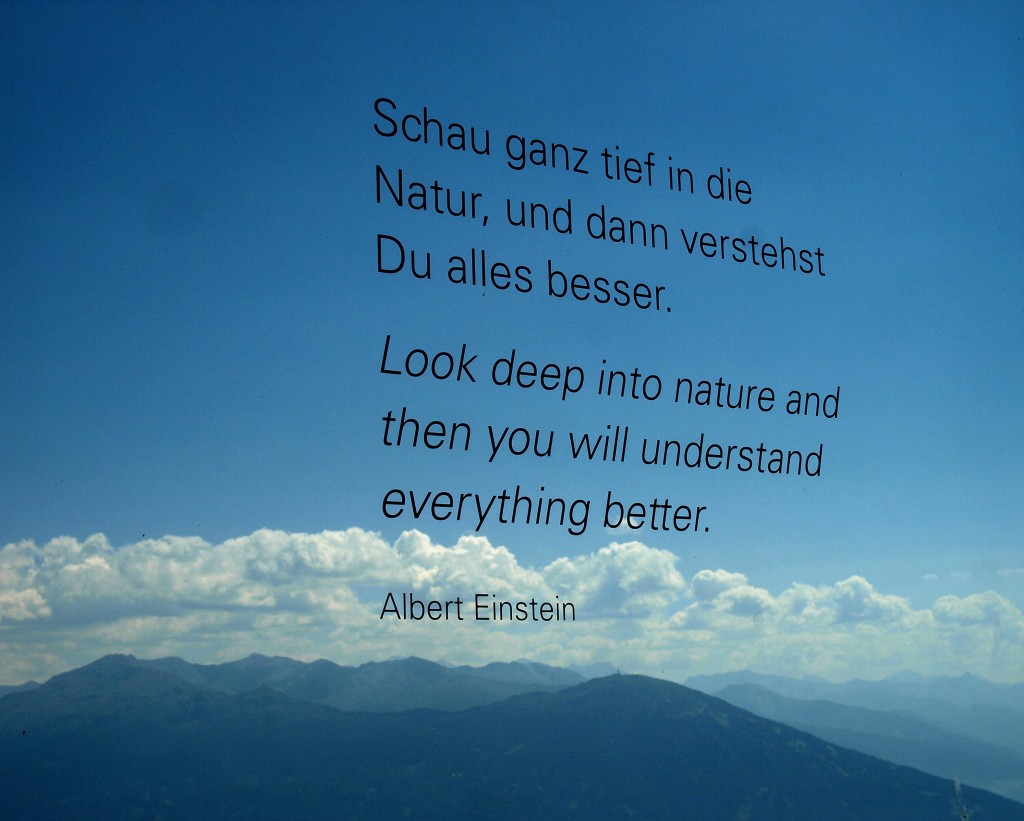
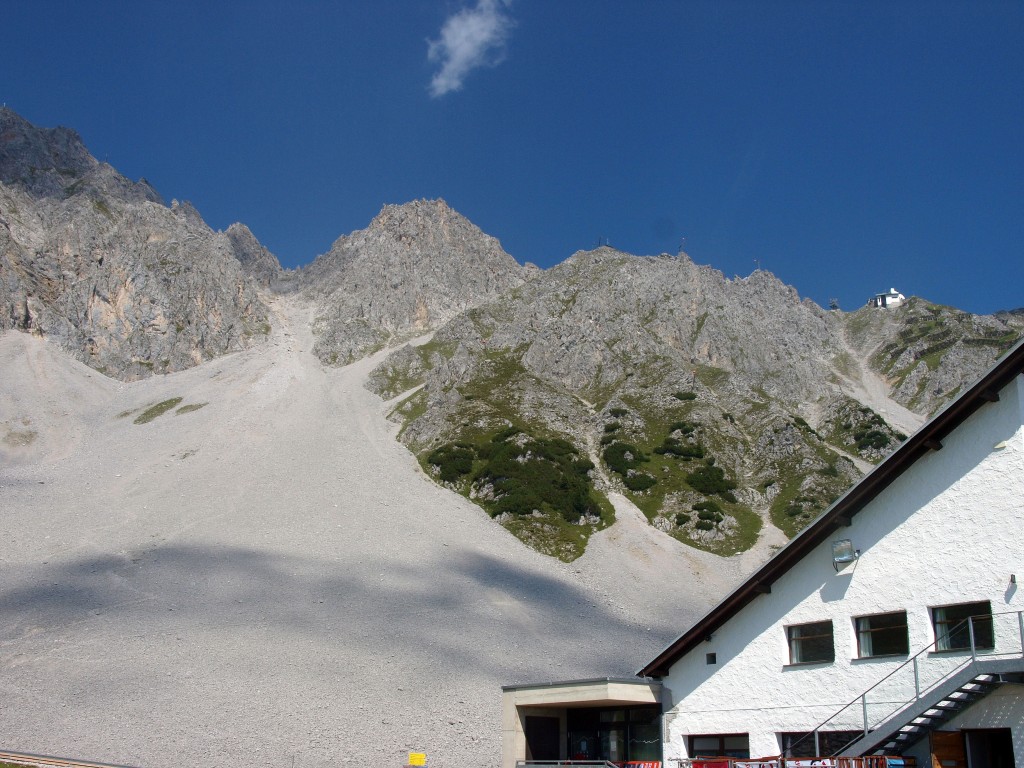
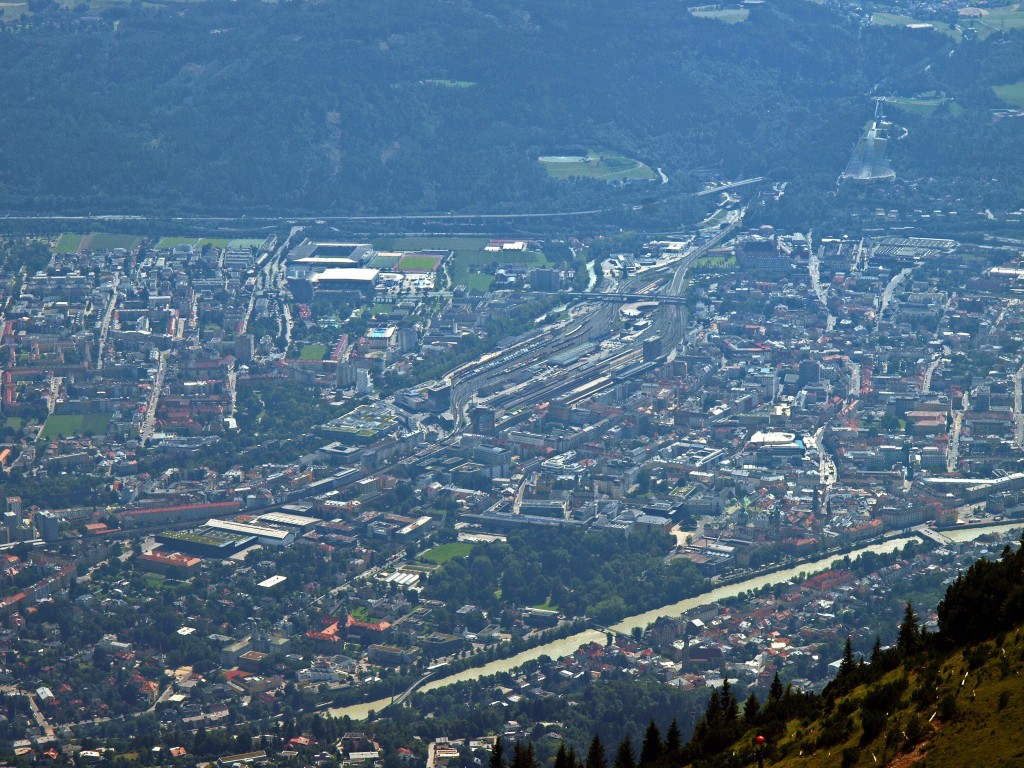
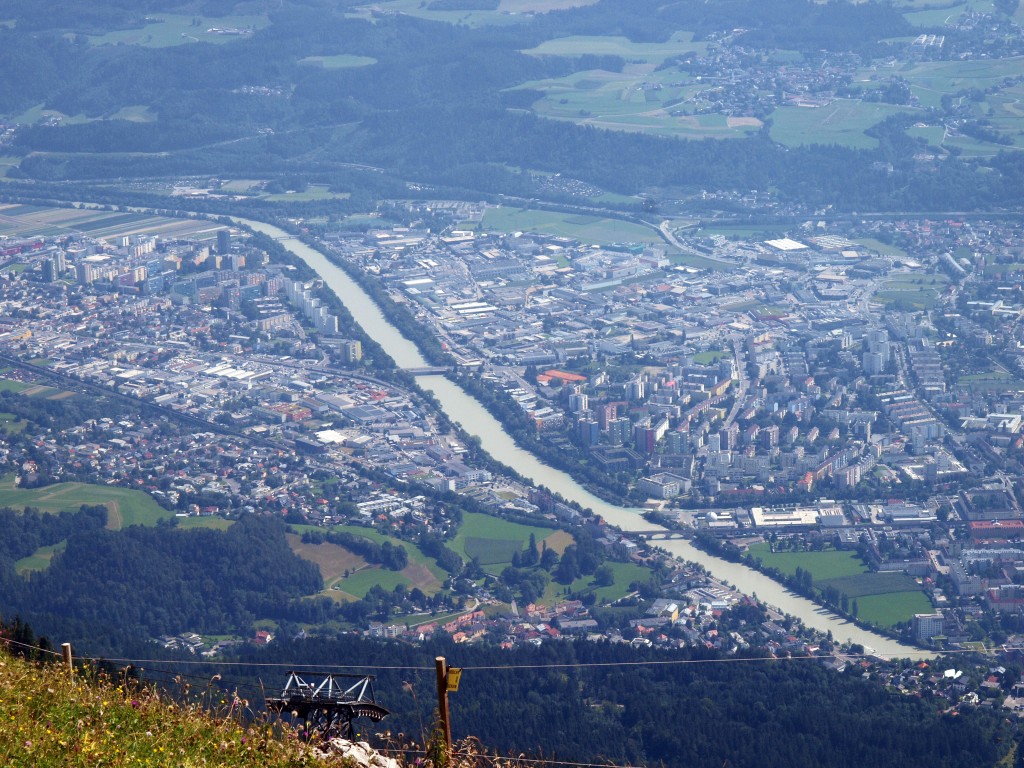
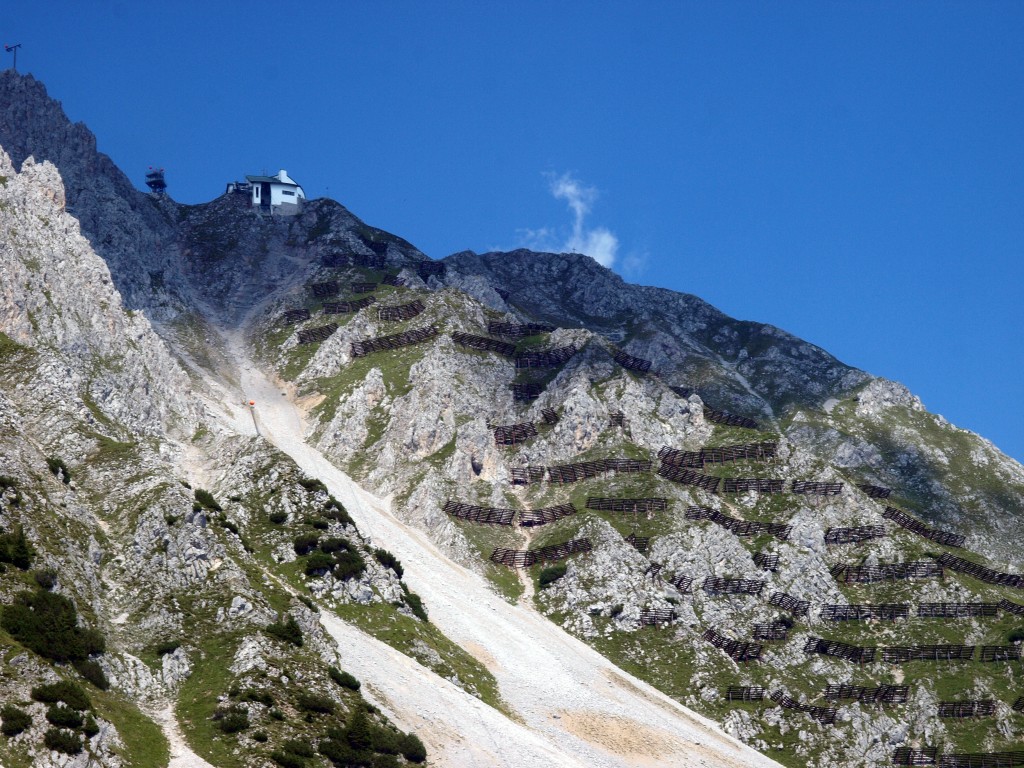
The final stretch up to the summit of the Nordketten at Hafelekar requires another cable car, though whilst the previous leg had two partially-balanced gondolas, this stretch had only one, counter-balanced by a sort of flying counterbalance which seems to be adjusted at the end of each run to account for the load. This leg only takes two-and-a-half minutes; when you get out at the summit station, you are now at 7,400 feet/2,256 metres, and the temperature has dropped another two degrees.
The views are stupendous.
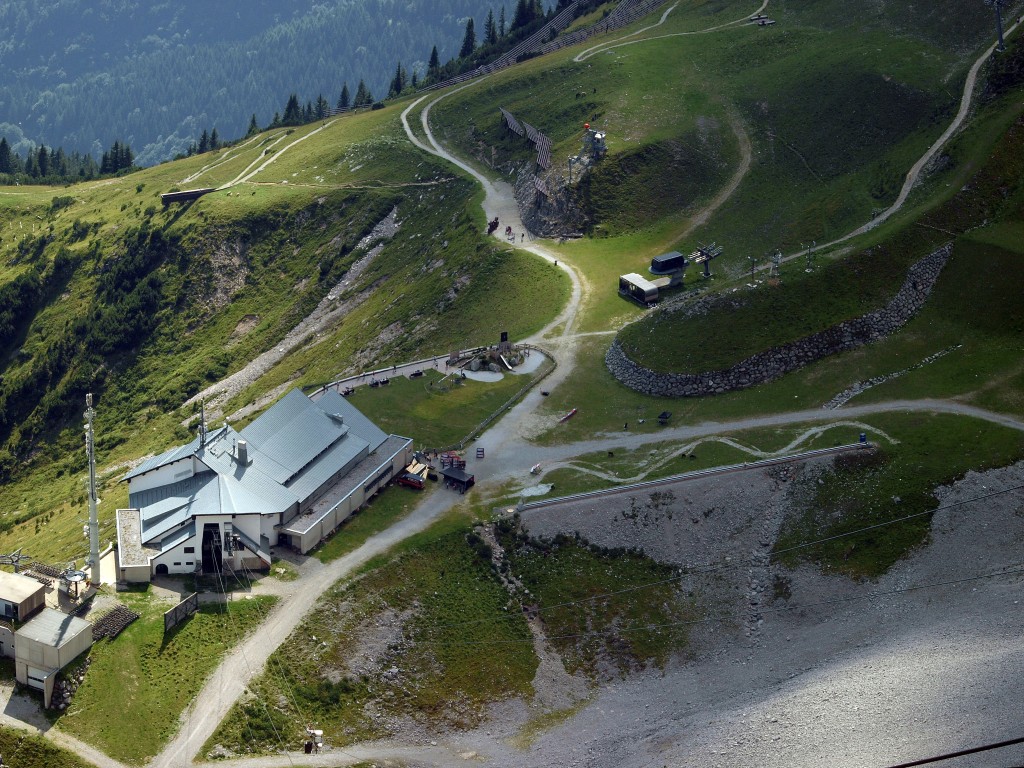
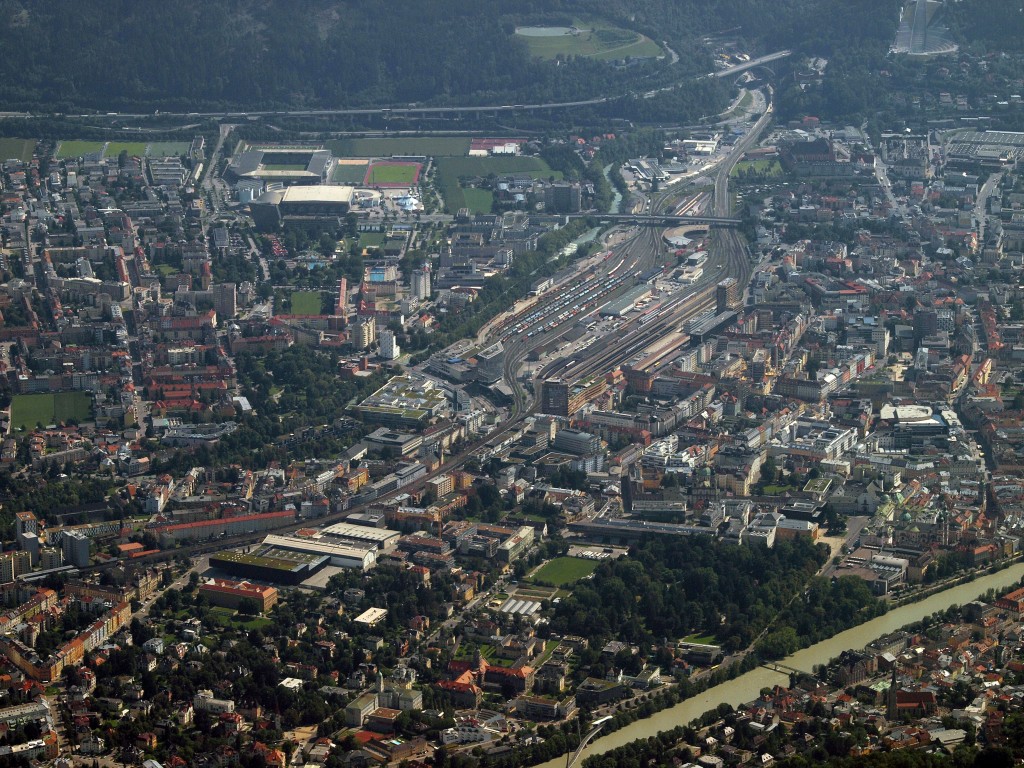
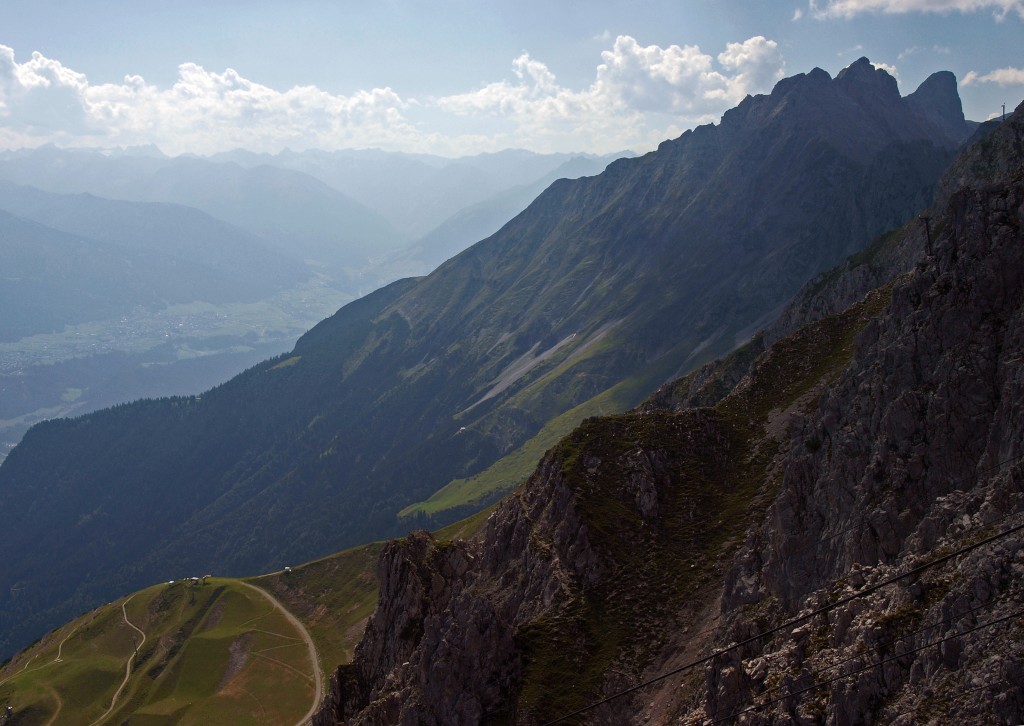
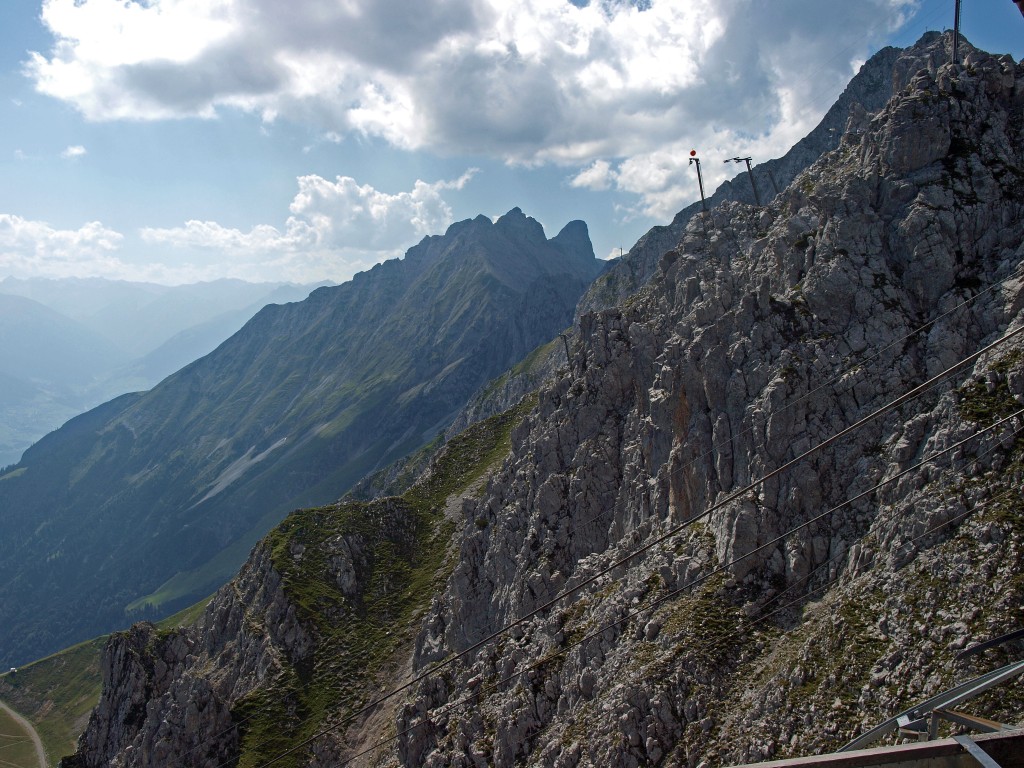
And then you climb past the cable car station and over a low saddle in the hill, and the Karwendel range is spread out before your eyes.
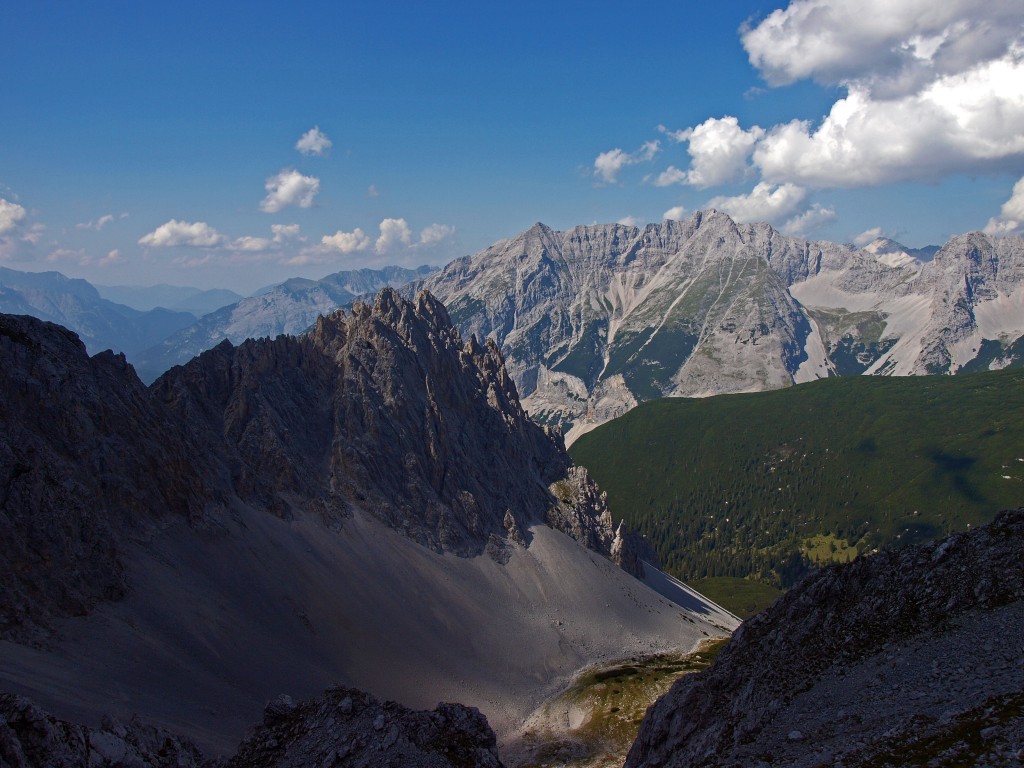
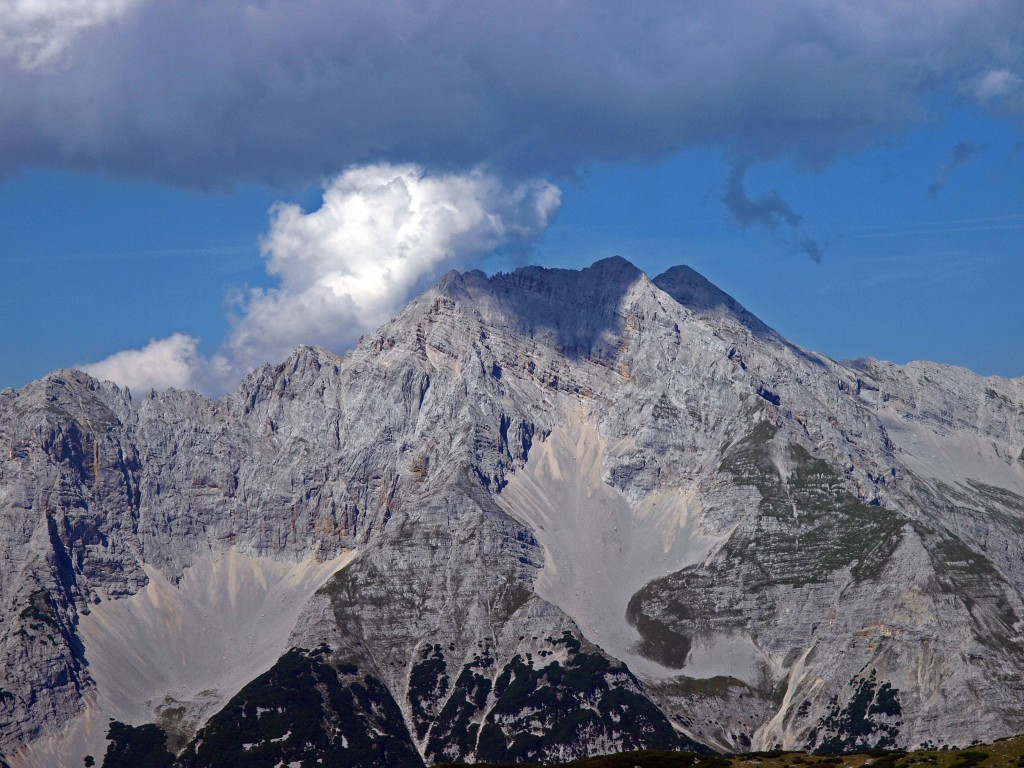
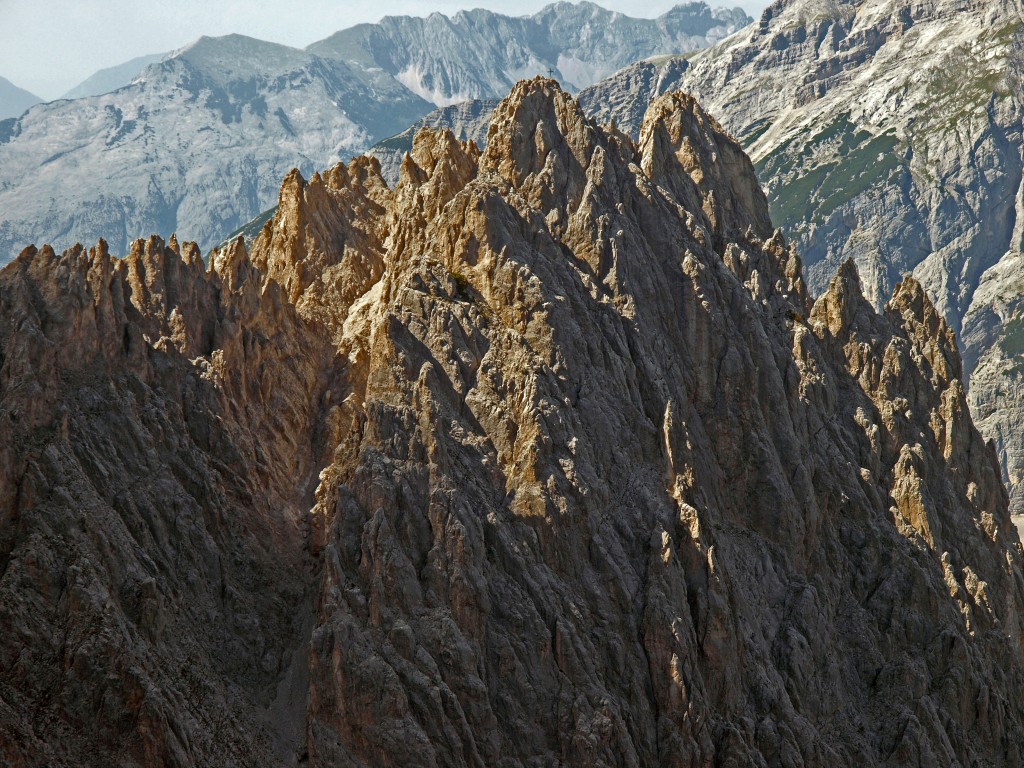
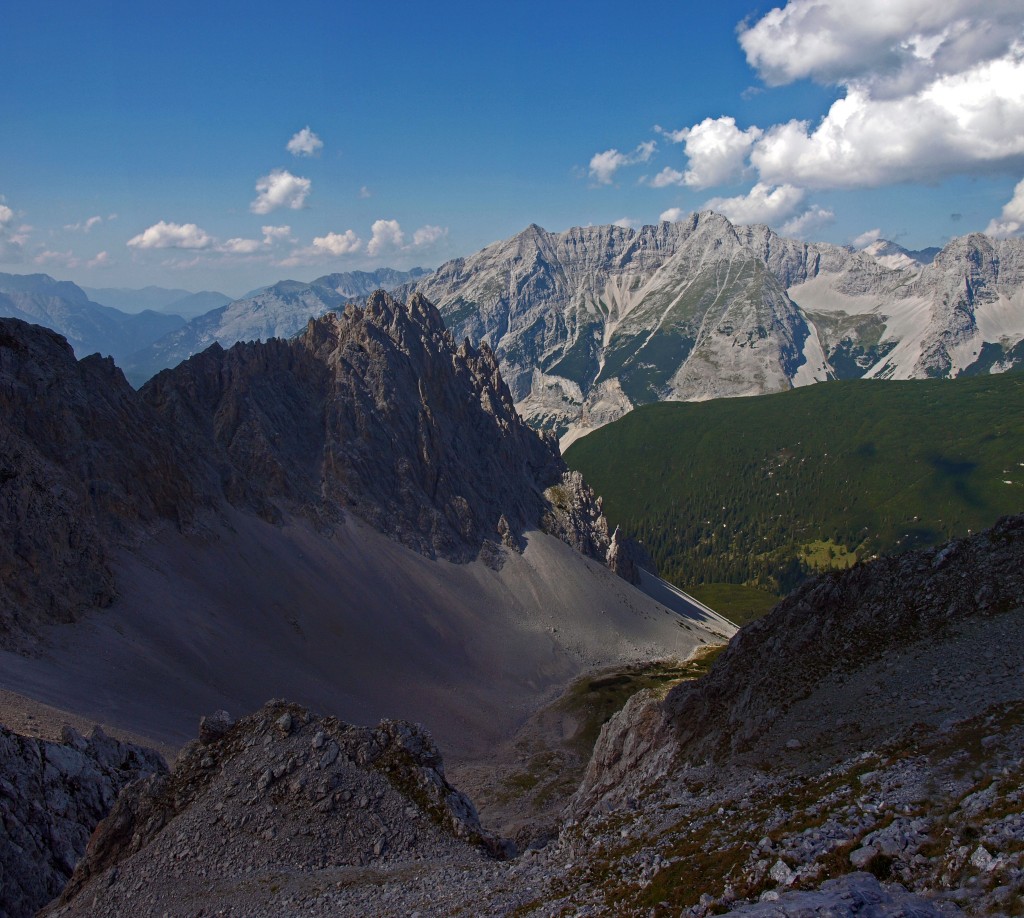
We stayed there for some time, watching the shadows of clouds move across the mountainside, and the change in the light on rocks as the sun moved around. Although there were many people on the hill, the space and altitude somehow made it not seem crowded. We had an impromptu physics lesson as I took out a bottle of water, only to find that it had become pressurised on the journey up from when I refilled it earlier in the day in Innsbruck. Further physics lessons followed as we visited the hut which forms the Victor Franz Hess Observatory – a high-altitude cosmic ray research laboratory opened in 1931.
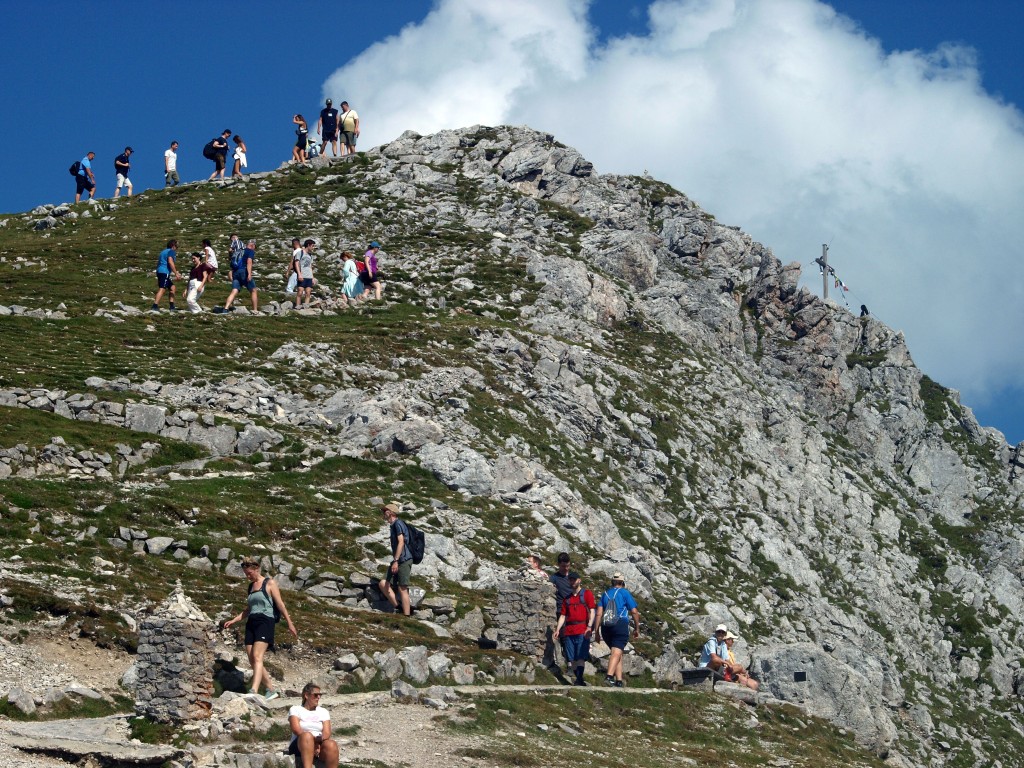
The path to the summit itself looks comparatively easy, taking the visitor up the final 250 feet; but I’m not as fit as I was when I last came up here in 1996, and I was feeling a bit scenery-ed out. So instead, we started our descent. On the way down, my by now empty plastic water bottle imploded with a gentle crack, again demonstrating the effect of pressure changes. And on the final stretch back down into Innsbruck, I spotted signs of the formation of the earlier Hungerbergbahn through the trees. We disembarked the train, back into the sweltering heat. Fortunately, the adjoining Kongresshalle was hosting an international conference on Near Infrared Spectroscopy, so I was able to ask the concierge to ring for a taxi for us back to the hotel.
Previous: day 3, Innsbruck
Next: Day 5, Seefeld
More photographs can be seen on my Flickr page.
What I did on my holidays: 3 – There’ll be a hot time in the old town tonight
I’d been to Innsbruck in the summer before, of course. Even in strong sunshine, there would often be a cool breeze blowing down off the mountains. But not this year. The Mediterranean heatwave extended this far north, and despite Innsbruck being more than 1,800 feet above sea level, the altitude gave little relief. The other thing I’d not experienced in Innsbruck before, even in the summer, was the crowds. It seems that people were very much re-discovering their taste for travel and most of Italy was on holiday in Innsbruck,
We started the day with a search for a decent hat to guard against too much sun exposure. That done, we were wandering down the Maria-Therese-Straße when two people stepped out of a church, produced trumpets, and proceeded to play Purcell’s Prince of Denmark’s march. They were advertising a free lunchtime concert by a Dutch choir, and mindful that this would give us an excuse to sit in a (reasonably) cool church building for an hour or so, we went in.
The choir was, it turned out, a scratch choir aimed at bringing together a group of people not previously involved in live music, and by intensive tutoring make them able to engage in public performances. In this, they succeeded. The test was for them to undertake a short tour (for certain values of the word ‘short’!), and today they were in Innsbruck.
We chatted with them a bit after the concert. It turns out that we had been spotted as appreciative music-lovers as opposed to mere tourists, and one of the singers admitted that held been pitching to us. Having done some public choral singing myself in my past, I understood the sort of pressure they’d been under; just because you’re an amateur, that doesn’t mean that you shouldn’t aim for the highest standards. And additional kudos was due their music director and his colleague (one of the trumpeters – the other was his wife) for making all their announcements in a foreign language (for them) – German. (As with nearly all Dutch, they were also fluent in English.)
Spiritually uplifted by the power of live music, we proceeded further into the Old Town and soon stopped for drinks, which turned into drinks and ice creams. We then continued to explore, oohing and aahing over the Goldenes Dachl, the “little golden roof” on a bay window on the Hofberg palace.
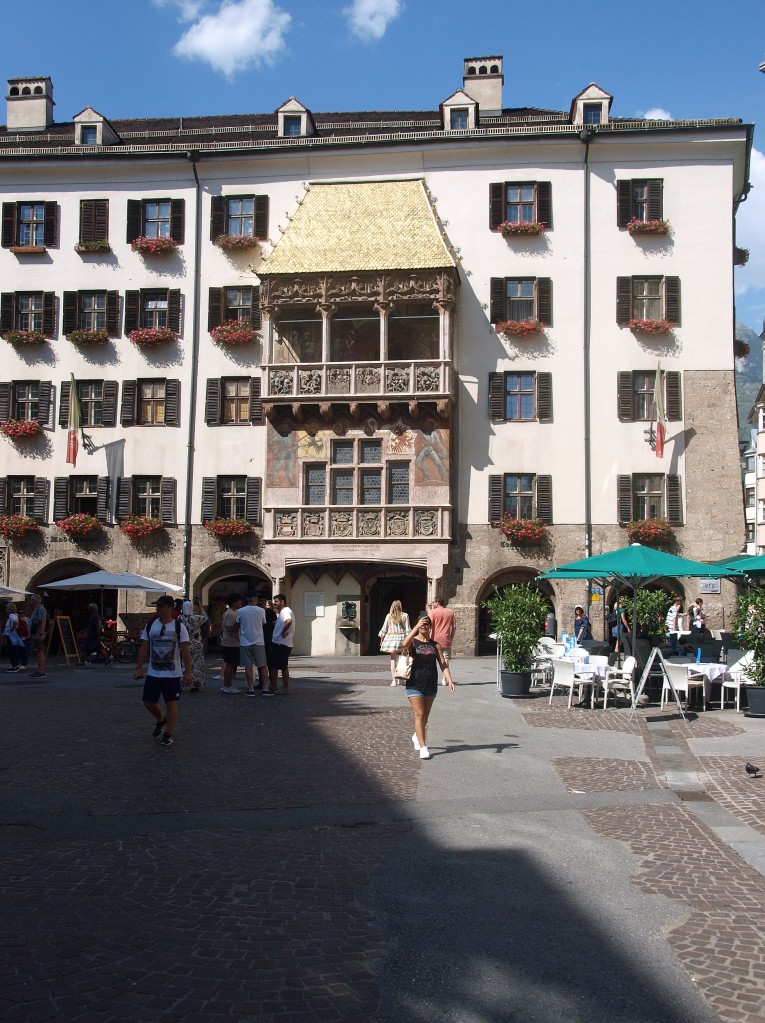
We discovered a fantastic toyshop, full of old-fashioned toys, marionettes, musical boxes and a wonderful mobile of a 1930s globe, surrounded by recognisable representations of contemporary aeroplanes, carved in wood – a DC-2, a Sikorsky flying boat and a Waco monoplane. It was gorgeous and tempting, but way too fragile to survive being carted all the way around Europe by train (though it seems it’s available through the power of the Internet) (other online vendors are available).
Eventually, we negotiated the backstreets of Innsbruck and emerged on the far side of the Hofberg palace.
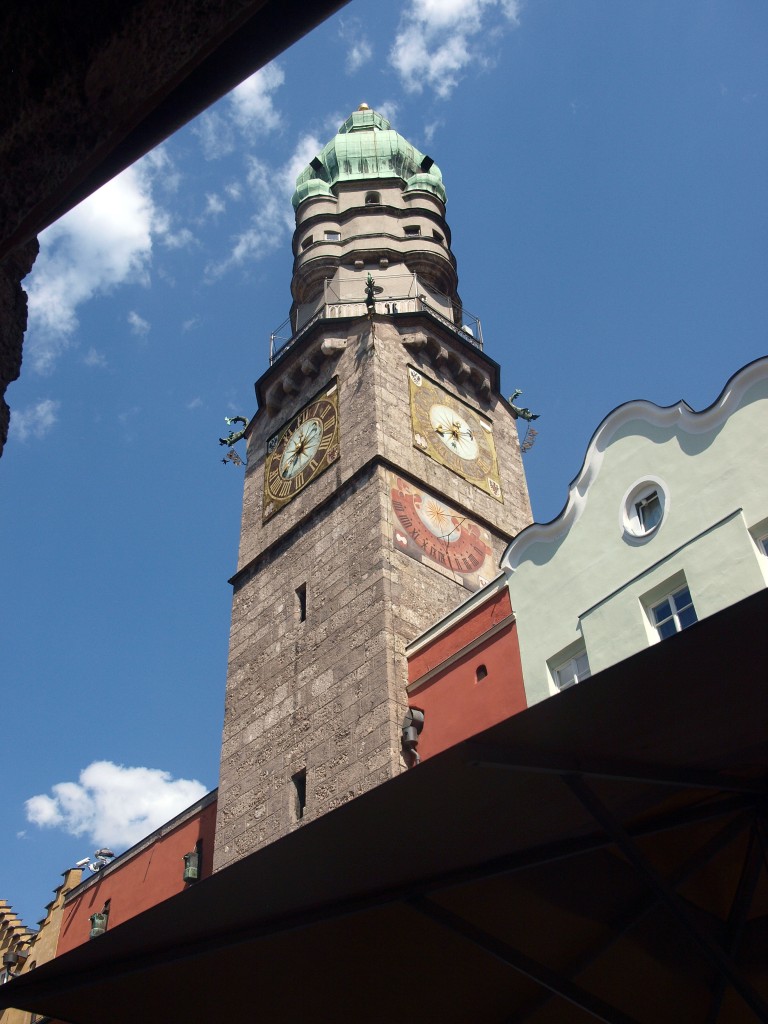
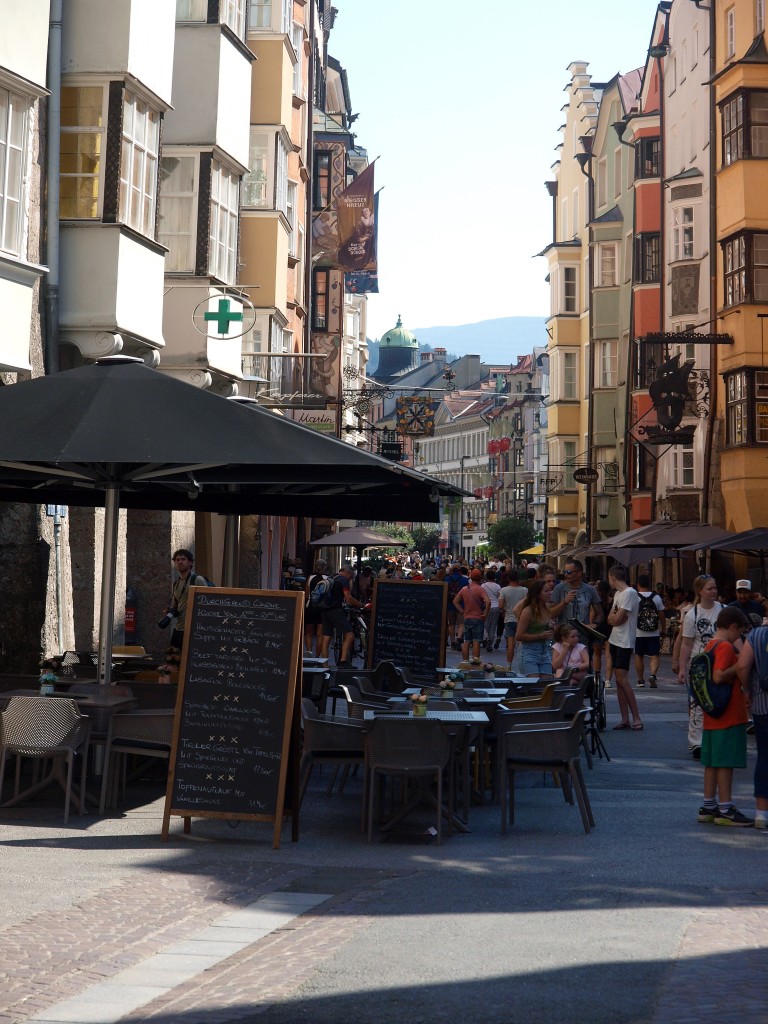

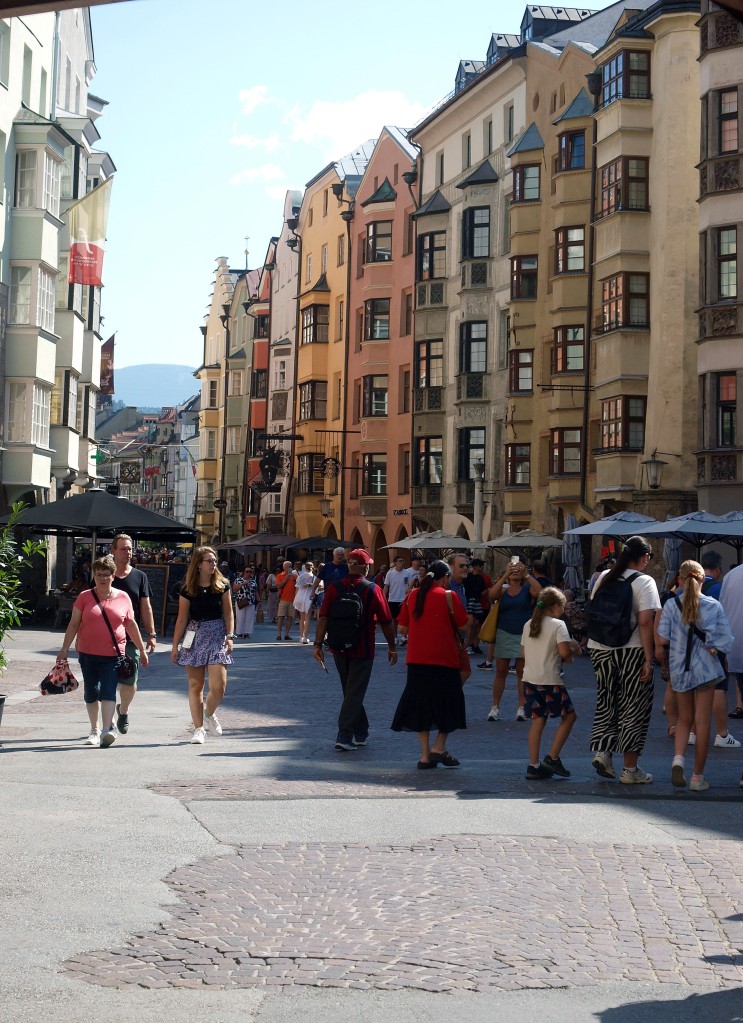
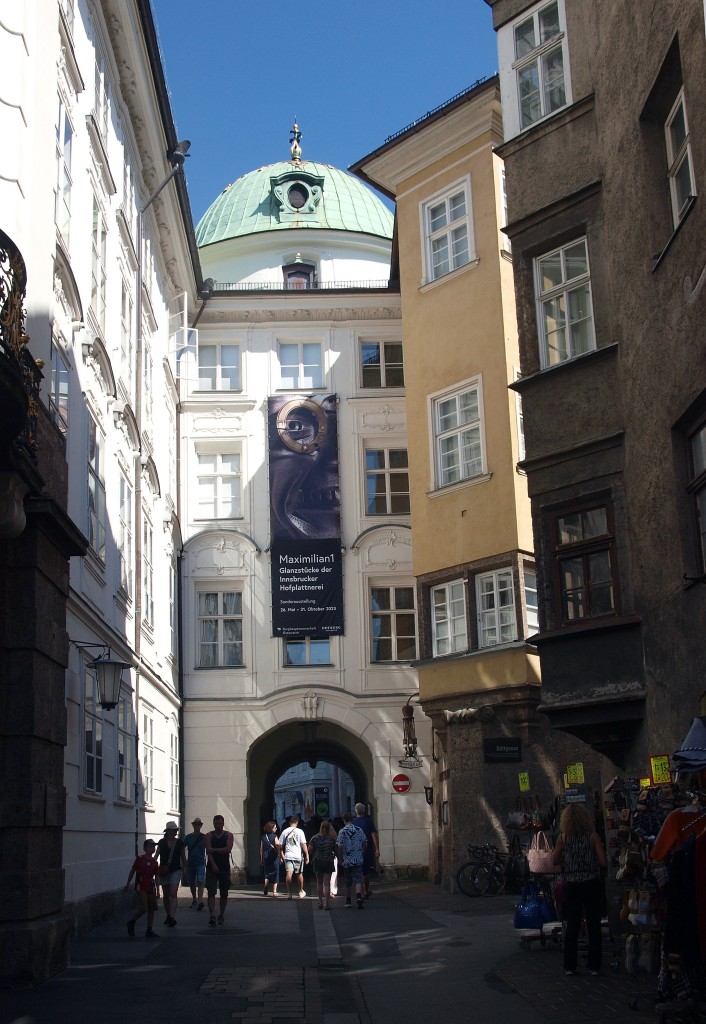

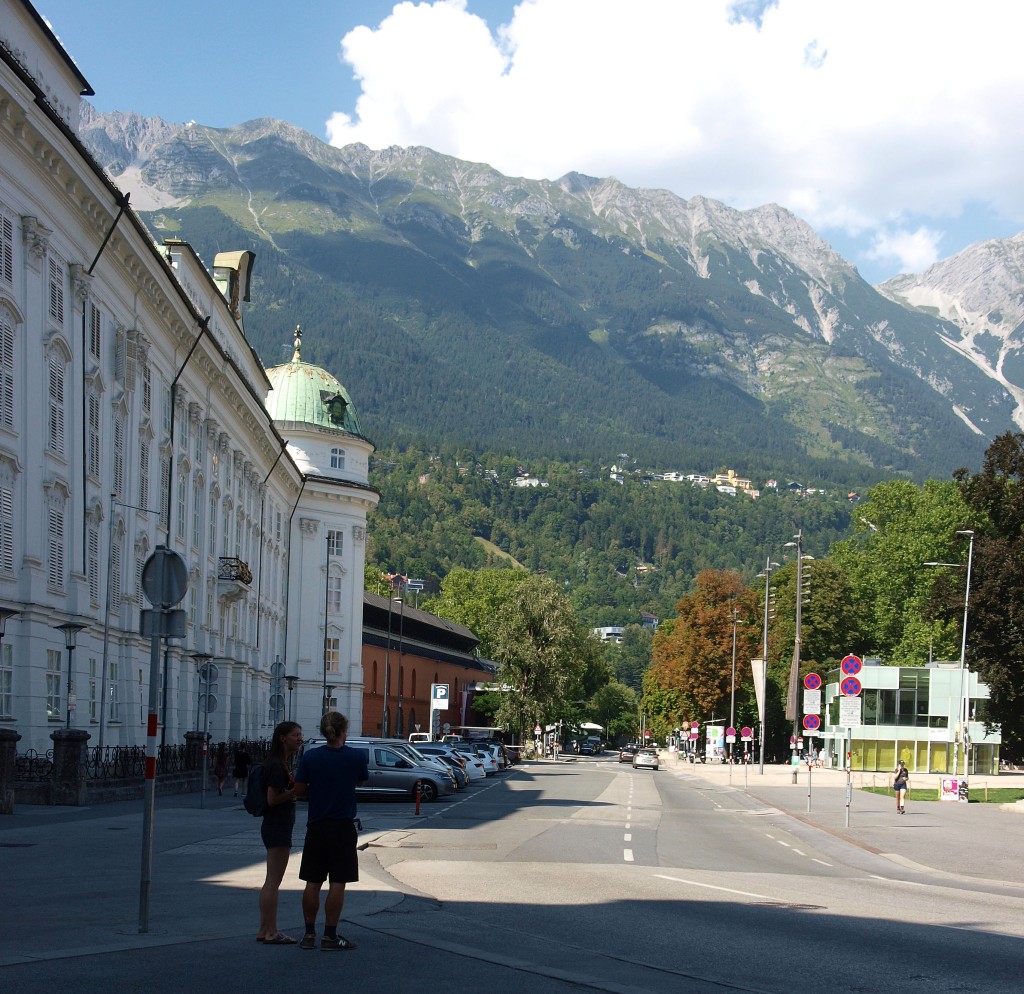

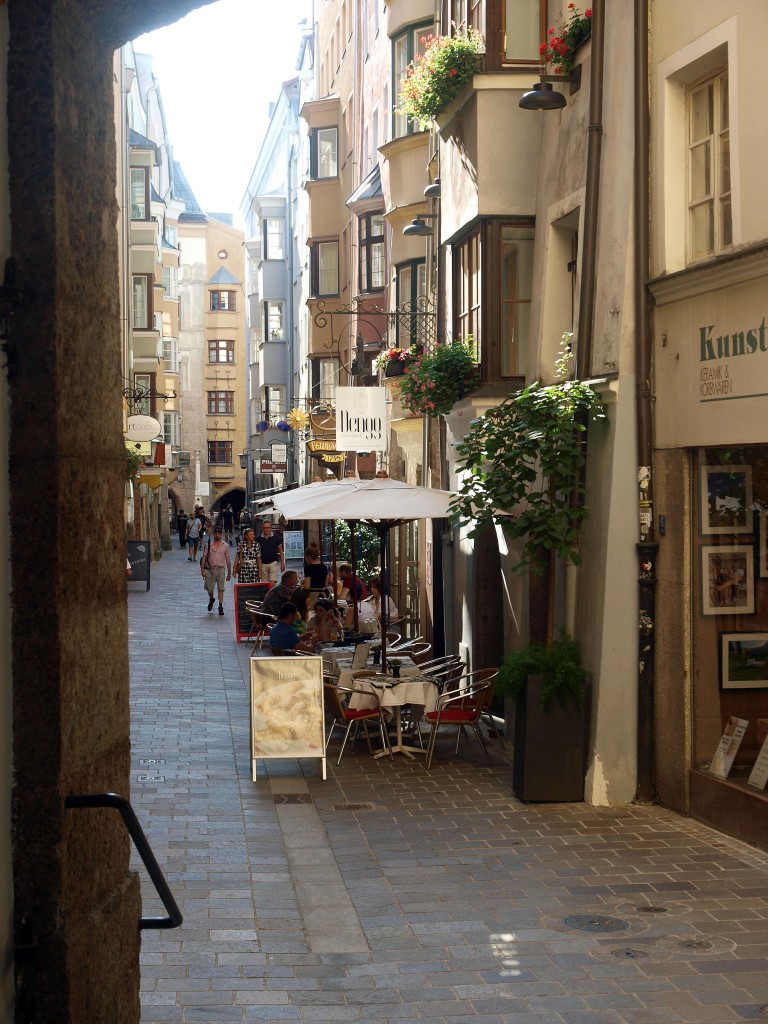
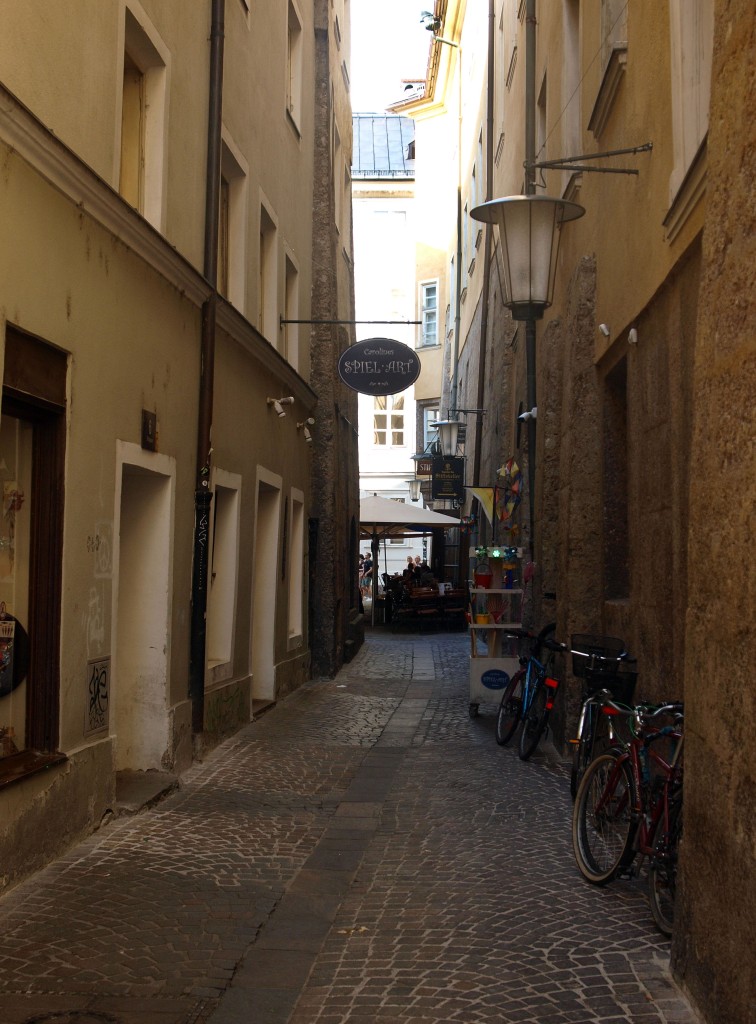

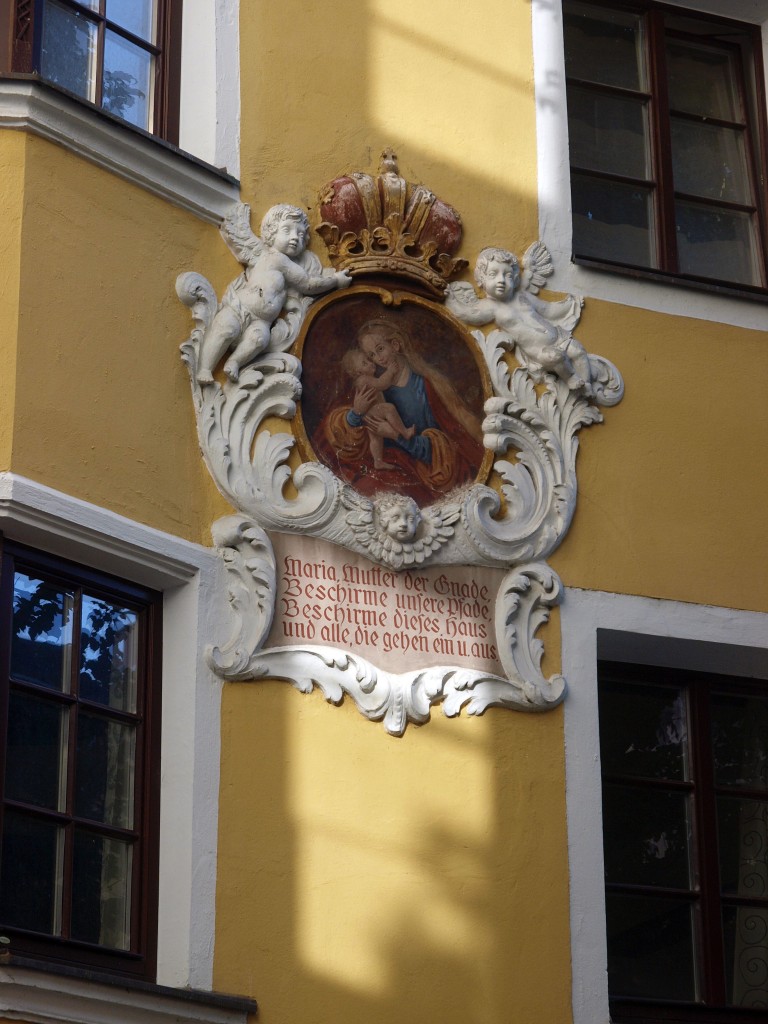

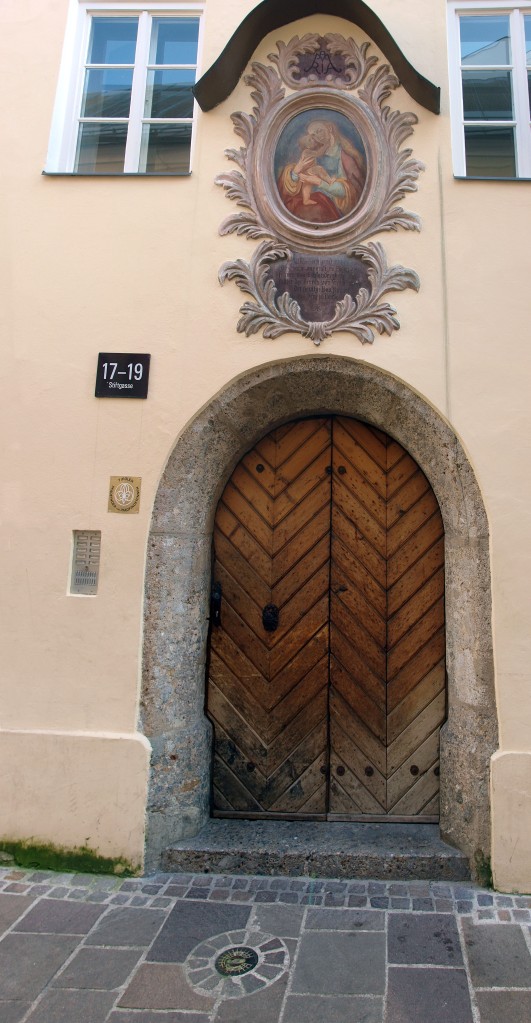
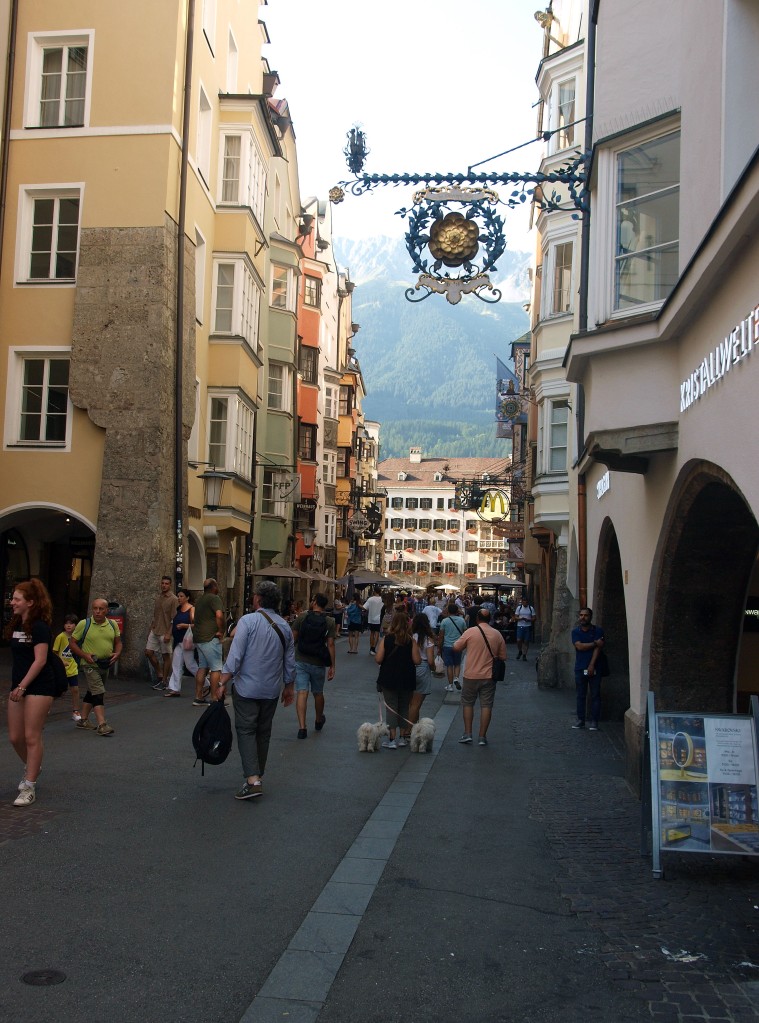
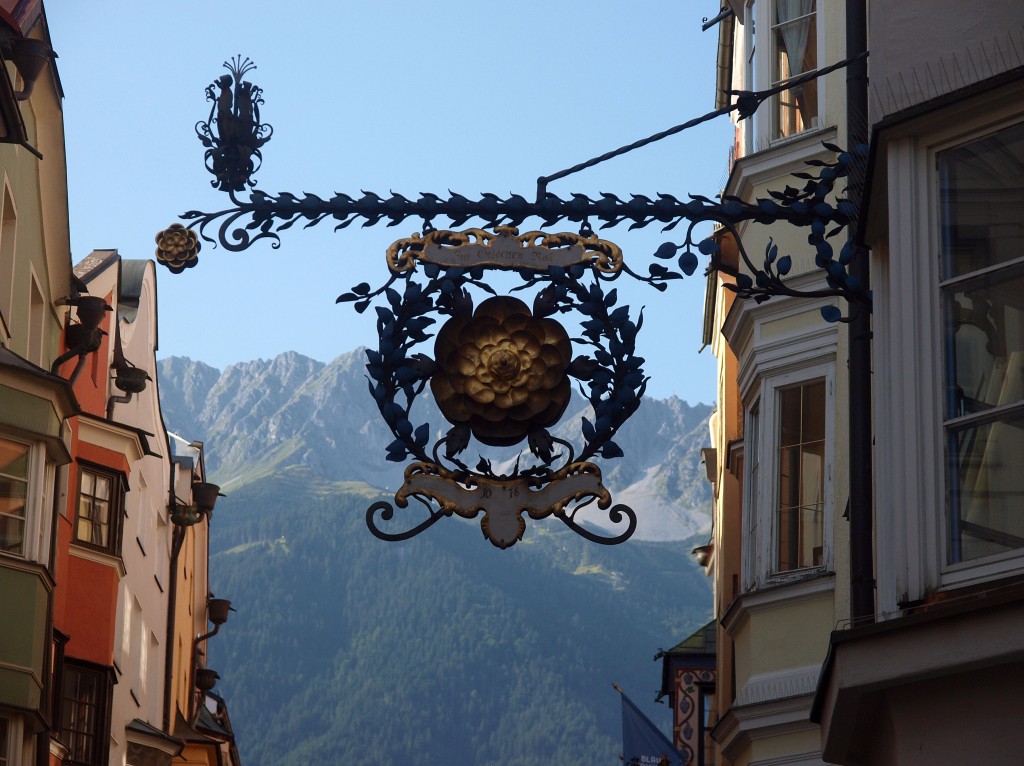
By now, the heat was getting oppressive, but salvation and cooling appeared in the shape of the Volkskunst (Folk Art) Museum.
This is an extensive collection of folk art and artefacts, including festival costumes, agricultural tools, furniture, and two other interesting collections. One was a series of reconstructed rural rooms, removed from now-demolished buildings and reconstructed inside the museum. These had been collected starting at the turn of the Nineteenth Century, and made a fascinating series on exhibits showing something of rural Tirolean life over the preceding two or three hundred years – including an insight as to the stature of rural people, forcibly brought home when you fail to stoop low enough to get through the door! American traveller Galen Freysinger has posted a series of pictures of thee rooms online: follow this link.
The other remarkable thing were the number of small tableaux, starting out with some representations of religious scenes, but then extending to rural festivals or notable events. I looked at these and immediately identified them as what us scale modellers term ‘dioramas’ – an arrangement of models with a backdrop or scenery that tells a story. The earliest of these showed the figures merely as one-dimensional painted card, mounted upright within a three-dimensional setting. Model soldier collectors will immediately recognise these as ‘flats’, the earliest form of model figure offered for sale.
Another website, by Galen Freysinger shows a selection of these Nativity scenes. It’s funny how so many of these appear to transplant Biblical Palestine into the Alps; and even when they don’t, in some of them there seems to have been a brief from the commissioning noble to “just get my castle in the scene somewhere”.
The museum also had a reconstruction of a local photographer’s studio with examples of early photographs of local costumes.
We spent some time in the museum, where it was at least cooler; but it soon came around to closing time, and so, both suffering from Museum Feet, we made our way back to our rather hot hotel, via the local Spar supermarket to stock up on necessities, like fruit and water.
Previous: day 2, Zürich – Innsbruck
Next: day 3, the Ascent of the Nordketten
More photographs on my Flickr page.
